Issue 30 April 2011
Worcestershire Record | 30 (April 2011) (ISSN 1 475-9616) page: 29-30 | Worcestershire Biological Records Centre & Worcestershire Recorders
A Teme Valley moth-ing update
Danny Arnold, Chairman of the Teme Valley Wildlife Group
The Teme Valley is host to some of the most pristine and diverse habitat in Worcestershire. In fact, there are only but a handful of habitat types found in the County that are NOT found in the Teme Valley and environs. As such, the area abounds with bio-diversity in every aspect of flora and fauna. Yet, in reality, when it comes to biological recording, the Teme Valley, is very much, the forgotten corner of Worcestershire. As a way of emphasising this point, on the Lepidoptera front, the fourth ‘first record for Worcestershire’ has shown up in the Teme Valley in less than two years. Though concerted effort on two trapping sites, one each side of the Valley, four ‘new’ moth species have been recorded in the County for the first time.
In July 2009, at the Worcestershire Wildlife Trust’s Hunthouse Wood reserve the tiny 496a Coleophora adjectella was taken by Patrick Clement during a scheduled Teme Valley Wildlife Group monthly trapping session. Following genitalia dissection, Tony Simpson, the Worcestershire County Moth Recorder, accepted the specimen onto the Worcestershire County list. This moth is typically found in the south-east England where the main food plant is Blackthorn. MOGBI (Emmet 1996) indicates that continental authors also include Hawthorn and, interestingly, Wild Cherry, all of which are found in Hunthouse Wood.
Since that time the remaining ‘firsts’ have all come from the South side of the Valley at the writer’s constant effort site at Upper Rochford. In June 2010, a single specimen of the macro moth 2286 Light Knot Grass Acronicta menyanthids came into one of five Skinner traps being run on the site over night. With the habitat all wrong for this species, it being an upland/damp moorland feeder, it almost certainly found its way down into the Teme Valley from Clee Hill, from where it has been recorded in Shropshire. This moth is a definite ‘northern’ species with north Worcestershire being right on the edge of its geographical territory.
Less than a month later in July 2010, another suspected migrant off the Clee came to another of the five traps. This time it was the small ‘micro’ moth, 1008 Philedone gerningana. Once again, this is another upland/acid moorland feeder, having a very similar appearance to the far more common Light Brown Apple Moth which is found in the Valley. The main visual difference between the two being the bipectinate-ciliate antennae.
Then in mid January 2011, during a three night mild spell, which saw the first moths appear in the traps for several weeks, a small Tortrix moth came into a light trap. It was at first considered to be a form of Acleris hastiana, a moth of variable colouration and one of the very few micro moths on the wing at this time of year. However, not feeling ‘quite right’, it was genitalia determined to confirm yet another County first: 1059 Acleris abietana.
A.abietana was first located in the UK in the mid 1960’s where it is thought to have come in on firs from Scandinavia destined to be planted in Scotland. The NBN Gateway map shows just three records from around the Perthshire area and one close to Kielder Water. There is also known to be one additional record in 2008 from Herefordshire, which was the most southerly record for the species. Some sources infer additional UK records; though appear not to be necessarily publically documented. Never the less, this is certainly a UK scarcity, and again, an excellent record for the Worcestershire list.
It may be no coincidence that three of these four species are apparently right on the edge of their Southern geographical limit, with the forth being right at the North of its UK limit. And in all four cases the Teme Valley has the habitat to hold them.
In addition to these impressive finds during the last two years, the Teme Valley has also produced numerous 2nd and 3rd moth species records for Worcestershire, all going to emphasise the biological importance of this area in terms of specialist habitat diversity and its condition.
In 2011, the Group is looking to expand their moth trapping sites into totally unrecorded new habitats within the area. A circular request to the people on the Teme Valley Wildlife Group emailing list, came up with ten responses from around the Valley with permissions for new areas to trap.
The Teme Valley oozes with tiny tracts and parcels of land that have remained unspoilt and relatively untouched for many years and it is these that are going to be the focus of attention. We already know from the conservationists the importance of building ‘wildlife corridors’ for the long term protection of species. The Teme Valley is the living blue print!
Who knows what wildlife gems this area will bring forth in 2011?
What is certain is that this ‘forgotten corner of Worcestershire’, is slowly but surely putting itself on the map….literally!
Reference
Emmet, A. Maitland, (Ed). 1996. The moths and butterflies of Great Britain and Ireland. Volume 3, page 221. Harley Books.
Images

Fig.1. Light Knot Grass Acronicta menyanthids. Picture ©Danny Arnold
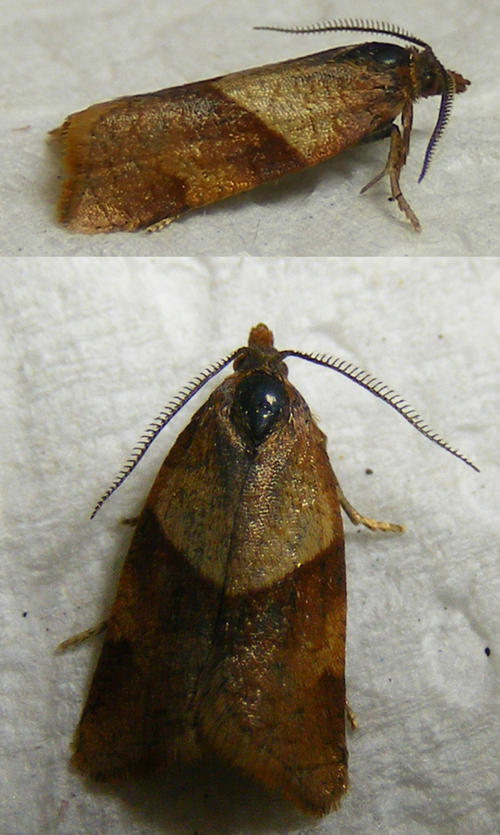
Fig.2. Philedone gerningana. Picture ©Danny Arnold

Fig.3. Acleris abietana. Picture ©Danny Arnold
Worcestershire Record | 30 (April 2011) (ISSN 1 475-9616) page: 28-29 | Worcestershire Biological Records Centre & Worcestershire Recorders
Note on Pauper Pug Moth Eupithecia egenaria
Danny Arnold
The Pauper Pug Moth is a relative rarity within Worcestershire and indeed, much of the country. First found in Worcestershire as recently as 2000, the main stronghold has been at Shrawley Wood where they have shown up in good numbers. Until recently this has been the only site in the county where this species has been recorded (bar a single individual which was captured and identified from the side of the Malvern Hills in 2010).
On a trapping session in early May 2011, Danny Arnold & Dean Fenton discovered a hitherto unknown and new strong population of this Red Data Book species at a Hanley Dingle, one of the Worcestershire Wildlife Trust’s more difficult to access sites. Several dozen were caught in the two moth traps set up, along with a host of other ‘new moth records’ for the site. Identification was confirmed by dissection of both a male and female.
The Pauper Pug larvae are a Lime Tree feeders and Hanley Dingle supports both Large & Small leaf Limes.
(Comment. This moth was first discovered in Britain in 1962 in the Wyre Valley limewoods. (Riley, A.M. & Prior, G. 2003. British & Irish Pug Moths. Harley Books). There seems to be some discussion on whether the larvae feed on small-leaved or large-leaved lime. Hanley Dingle contains both species and the largest stand of large-leaved lime in Worcestershire). Shrawley Wood is of small-leaved lime. Limes are widespread in west Worcestershire. (Ed)).
Image
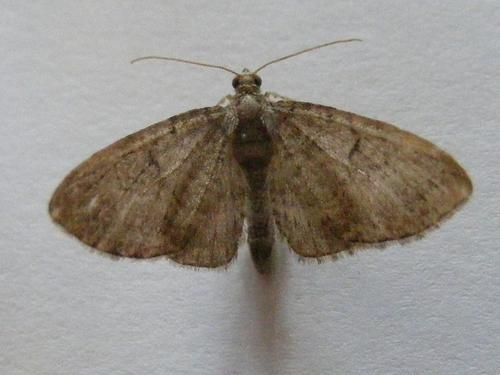
Fig. 1. Pauper Pug Moth Eupithecia egenaria from Hanley Dingle. Picture ©Danny Arnold
Worcestershire Record | 30 (April 2011) (ISSN 1 475-9616) page: 26-28 | Worcestershire Biological Records Centre & Worcestershire Recorders
Worcestershire and the new Dragonfly Atlas of England, Wales & Scotland
Mike Averill
2010 was the third of a five year project to remap the dragonflies in the UK mainland. In Worcestershire 884 new records were added to the previous two years to give 2751 in total.
The results from the first three years in Worcestershire are summarised in the map (Fig. 1.). This shows how many species have been recorded in each 2×2 km square and the total is coded into nine groups as per the key. It shows that many squares have only two species or less recorded which is obviously an underestimate of the real situation. There are a few sites coded to nine which means there are between 17 and 19 species for example the Grimley gravel pits and Upton Warren. If possible recording in the blank areas is needed as the popular sites are well covered.
In 2010 new records helped to fill in some of the outlying areas around Tenbury and the old South Birmingham part of the vice county, but there are still large gaps in quite a few locations such as in the SW of the county and in SO97.
To see which species are under-recorded check the species listed in the table below against the 10×10 km squares. The table is set in two parts to cover all species.
| Aeshna cyanea | Aeshna grandis | Aeshna juncea | Aeshna mixta | Anax imperator | Calopteryx splendens | Calopteryx virgo | Coenagrion puella | Cordulegaster boltonii | Enallagma cyathigerum | Erythromma najas | Erythromma viridulum | Gomphus vulgatissimus | |
| SO56 | 3 | 3 | 2 | ||||||||||
| SO66 | 6 | 1 | 1 | 1 | 10 | 4 | 1 | ||||||
| SO67 | 1 | 1 | 3 | 1 | 7 | 1 | 6 | 1 | |||||
| SO73 | 1 | ||||||||||||
| SO74 | 1 | 1 | 3 | 3 | 3 | ||||||||
| SO75 | 1 | 2 | 2 | 2 | 1 | ||||||||
| SO76 | 1 | 4 | 5 | 4 | 4 | 1 | 4 | 4 | |||||
| SO77 | 10 | 6 | 4 | 2 | 9 | 5 | 7 | 4 | 5 | 1 | 7 | ||
| SO83 | 2 | 2 | 8 | 4 | 2 | 4 | 8 | 4 | |||||
| SO84 | 4 | 4 | 9 | 15 | 2 | 11 | 32 | 8 | 5 | ||||
| SO85 | 3 | 12 | 6 | 19 | 8 | 1 | 19 | 23 | 5 | 2 | 3 | ||
| SO86 | 8 | 7 | 16 | 16 | 12 | 16 | 24 | 33 | 15 | 1 | |||
| SO87 | 23 | 26 | 10 | 7 | 9 | 22 | 3 | 45 | 22 | 16 | 1 | 1 | |
| SO88 | 7 | 3 | 4 | 7 | 2 | 3 | 12 | 11 | |||||
| SO93 | 1 | 1 | 2 | 22 | 6 | 3 | 19 | 32 | 3 | ||||
| SO94 | 11 | 10 | 6 | 14 | 111 | 8 | 24 | 48 | 8 | 2 | 15 | ||
| SO95 | 7 | 6 | 5 | 7 | 7 | 2 | 3 | 4 | 3 | ||||
| SO96 | 18 | 19 | 19 | 10 | 39 | 15 | 21 | 14 | 3 | ||||
| SO97 | 4 | 2 | 1 | 7 | 3 | ||||||||
| SO98 | 4 | 5 | 1 | 1 | 1 | 2 | 2 | ||||||
| SP03 | 1 | ||||||||||||
| SP04 | 1 | 1 | 2 | 1 | 17 | 3 | 7 | 2 | 1 | ||||
| SP05 | 2 | 2 | 2 | 1 | 3 | 3 | |||||||
| SP06 | 3 | 1 | 2 | 2 | 1 | 4 | 8 | ||||||
| SP07 | 2 | 5 | 5 | 4 | 7 | 11 | 3 | ||||||
| SP08 | 2 | 1 | 1 | 2 | |||||||||
| SP13 | 1 | 1 | 1 | 1 | |||||||||
| SP14 | 1 | 1 | |||||||||||
| SP16 | 1 | 1 | 3 | 1 | 5 | 1 | |||||||
| SP18 | 1 | ||||||||||||
| Total | 127 | 112 | 10 | 84 | 156 | 251 | 71 | 244 | 5 | 288 | 89 | 10 | 33 |
| Ischnura elegans | Lestes sponsa | Libellula depressa | Libellula fulva | Libellula quadrimaculata | Orthetrum cancellatum | Platycnemis pennipes | Pyrrhosoma nymphula | Sympetrum danae | Sympetrum fonscolombii | Sympetrum sanguineum | Sympetrum striolatum | Total | |
| SO56 | 3 | 2 | 2 | 15 | |||||||||
| SO66 | 8 | 1 | 6 | 3 | 2 | 2 | 8 | 1 | 5 | 60 | |||
| SO67 | 5 | 3 | 5 | 1 | 2 | 37 | |||||||
| SO73 | 1 | 2 | |||||||||||
| SO74 | 4 | 2 | 1 | 1 | 2 | 21 | |||||||
| SO75 | 3 | 5 | 16 | ||||||||||
| SO76 | 4 | 2 | 1 | 2 | 4 | 1 | 41 | ||||||
| SO77 | 3 | 2 | 1 | 6 | 4 | 2 | 4 | 82 | |||||
| SO83 | 8 | 4 | 10 | 1 | 1 | 1 | 8 | 67 | |||||
| SO84 | 28 | 2 | 3 | 1 | 3 | 23 | 5 | 5 | 13 | 25 | 198 | ||
| SO85 | 36 | 3 | 3 | 5 | 12 | 4 | 8 | 6 | 16 | 194 | |||
| SO86 | 37 | 6 | 5 | 8 | 11 | 8 | 17 | 1 | 6 | 22 | 269 | ||
| SO87 | 50 | 2 | 8 | 2 | 7 | 8 | 34 | 1 | 9 | 36 | 342 | ||
| SO88 | 6 | 2 | 1 | 11 | 1 | 16 | 86 | ||||||
| SO93 | 29 | 3 | 3 | 3 | 17 | 14 | 4 | 4 | 9 | 9 | 184 | ||
| SO94 | 69 | 3 | 9 | 26 | 3 | 16 | 54 | 33 | 1 | 32 | 503 | ||
| SO95 | 3 | 2 | 2 | 1 | 5 | 2 | 5 | 1 | 6 | 71 | |||
| SO96 | 30 | 3 | 8 | 4 | 2 | 13 | 6 | 11 | 5 | 20 | 260 | ||
| SO97 | 5 | 1 | 2 | 6 | 4 | 35 | |||||||
| SO98 | 2 | 1 | 3 | 8 | 30 | ||||||||
| SP03 | 1 | ||||||||||||
| SP04 | 8 | 2 | 3 | 1 | 4 | 11 | 2 | 2 | 68 | ||||
| SP05 | 3 | 1 | 2 | 1 | 20 | ||||||||
| SP06 | 14 | 1 | 1 | 2 | 2 | 1 | 42 | ||||||
| SP07 | 14 | 1 | 2 | 2 | 3 | 3 | 62 | ||||||
| SP08 | 1 | 4 | 1 | 12 | |||||||||
| SP13 | 4 | ||||||||||||
| SP14 | 1 | 3 | |||||||||||
| SP16 | 3 | 1 | 4 | 1 | 2 | 23 | |||||||
| SP18 | 2 | 3 | |||||||||||
| 376 | 27 | 70 | 39 | 57 | 131 | 107 | 169 | 2 | 5 | 56 | 232 | 2751 |
Table shows the number of records for each species per 10×10 km square in Worcestershire for 2008-10
Please send your records to mike.averill@blueyonder.co.uk and these should contain at least the basic information about the location of the dragonfly with an NGR, date and species, but if you can give any estimate of numbers or breeding activity that would add a lot to the record. If you feel keen I can send a spreadsheet with a pick list of species already entered.
If you travel outside Worcs, don’t forget this work is part of a national atlas and all records are welcome. I am happy to receive any records or you can enter them online via the British Dragonfly Society website: http://www.ghmahoney.org.uk/bds/recording/recordentry.aspx
Records from Herefordshire are badly needed to bring the dataset up to date.
Image
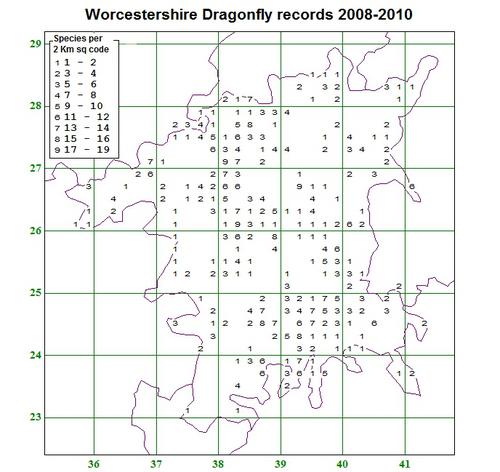
Fig. 1. The number of records of dragonflies in Worcestershire for each 2×2 km square (see code) collected in the first three years of the project.
Worcestershire Record | 30 (April 2011) (ISSN 1 475-9616) page: 9-15 | Worcestershire Biological Records Centre & Worcestershire Recorders
Mistletoe and mistletoe insects, overview and observations from 2010
Jonathan Briggs – including pictures © unless otherwise stated.
jonathanbriggs@mistletoe.org.uk
This account of mistletoe Viscum album and its associated insects reprises and updates the account I gave to the Worcestershire Recorders Annual meeting in March 2010. The text draws heavily on a recent paper I wrote for the Gloucestershire-based CNFC (Briggs 2011) with some updated observations from this winter. Hopefully it will stimulate more mistletoe bug, moth and weevil hunting in Worcestershire this summer; our mistletoe insects are an interesting little group, most are (relatively) easily spotted, and there should be plenty of them in Worcestershire.
I’ll start with a quick review of mistletoe itself, with notes on its distribution, hosts and habitats, as understanding those is essential if the invertebrates are to be fully appreciated.
Mistletoe distribution
Britain is at the northern edge of mistletoe’s distribution in Europe, with mistletoe occupying slightly more northerly latitudes here than it does in mainland Europe (it is almost entirely absent from Scandinavia). This suggests a climatic limitation to its natural range – a concept supported by a brief glance at its UK distribution where there is a clear bias to the SW Midlands area.
Within Britain this distribution is often simplified as being the ‘Three Counties’ of Worcestershire, Herefordshire and Gloucestershire and is often assumed to be a result of association with apple orchards. But looking at an enlargement map (both maps are derived from the BSBI/Plantlife 1990s national mistletoe survey) it becomes clear that the distribution more closely matches the lowlands in and around the river corridors of the Severn, Avon, Wye and Usk, straying well into Gwent and down into Somerset. Obvious geographical constraints seem to be altitude – the Cotswold escarpment clearly forms the eastern boundary, with the southern Welsh uplands forming the western side and the Clee Hills and the Birmingham plateau forming the northern limit.
This distribution has been known, and commented on, throughout botanical recording history, but exact climatic factors are difficult to define, though it is thought that winter and summer temperature maxima and minima are important. But, as the maps show, the species can survive almost anywhere in southern Britain, so it’s obviously not quite so simple. There are, incidentally, several relatively new accounts of some of the eastern counties’ mistletoe colonies spreading further in recent years, so something may be changing (some possible factors are discussed briefly below).
Habitats and hosts
The habitat and host preferences of mistletoe are just as peculiar as its distribution. As a parasite of tree branches the species is, obviously, dependent on suitable host trees for its survival, but it really requires those trees to be in fairly open habitats, and it does not thrive in a woodland environment. In a pre-clearance Britain it would probably have been restricted to trees on edges of clearings, alongside rivers and on the open habitats of steep slopes. In our more man-made Britain the vast majority is found on trees in gardens, orchards, parks, churchyards, field margins and roadsides. The implication is that it would be much less frequent without these habitats, though its distribution might well be similar.
The pattern of preferred hosts is intriguing, with most mistletoe on man-made hosts (i.e.hybrids and varieties created through horticulture). Cultivated apple and hybrid limes support most of our mistletoe – choices which correlate quite well with the garden, orchard and parkland habitats. This host preference is marked, with huge proportions on those few tree species, but it is worth stressing that mistletoe will grow on many hundreds of different hosts too. Its natural (pre-clearance) hosts would probably be dominated by hawthorns, whitebeams, and white willows.
Conservation issues arising so far
The association of mistletoe with apples, orchards and the three counties has inevitably led to a strong belief that these are all interlinked, and that the future of mistletoe depends on the future of apple orchards. This is an oversimplification, but it is an important factor.
The 1990s BSBI/Plantlife Mistletoe Survey set out to investigate whether mistletoe was actually threatened by apple orchard loss. Results showed that whilst mistletoe quantity might be reduced through loss of orchards, the distribution of mistletoe was much the same as it had ever been, with possible increases in some areas. The ‘core’ area in the south-west midlands did however have the greatest range of hosts and habitats for mistletoe –its habitat preferences become even more dominated by gardens and parks further east, north or south.
This all tends to strengthen the view that it is here because the location suits it, not because there are/were lots of apple trees. An additional point of course is that apple growing areas occur, or used to occur, in many other parts of the country, but these other apple areas have no significant association now, or historically, with mistletoe.
The whole mistletoe conservation issue is, therefore, a little confusing. It is undoubtedly rare over most of Britain, and it is locally threatened in some areas. In those areas (primarily in the east) several local Biodiversity Plans have included direct action (e.g. deliberate planting) to encourage mistletoe. In other areas (again mostly in the east) it is reported to be locally increasing, apparently without intervention.
But here in the SW Midlands it seems to be still common, and there is no real threat to its continuing existence in the wider countryside. Except in orchards. And that’s where most of it is, in terms of quantity. Orchard loss is continuing despite many local campaigning groups raising awareness. Their efforts can save exemplary farm and community orchards but the loss in the wider countryside has either happened or is continuing.
This implies that we have already, and probably will continue to experience for the next few years, a reduction in the amount of mistletoe. Does this matter or not? In economic terms it might, as most Christmas mistletoe is harvested from orchards. The famous mistletoe auctions at Tenbury Wells are supplied almost entirely from apple orchards. So we seem likely to have a smaller mistletoe crop in future.
But the Tenbury mistletoe auctions always seem to have plenty of mistletoe – so is the crop really threatened? This is another confusing area, and there are no statistics to help, but it does seem reasonably likely that the auctions are being largely supplied by excessive growths of mistletoe in now-neglected orchards. In other words there might be a short-term glut of mistletoe available from older, senescent orchards, which makes current availability seem good. But this is an unsustainable situation – once those old trees have gone the harvestable quantities will surely reduce.
Conservation issues for associated species
So there might be some economic impacts for mistletoe cropping with continuing local apple orchard loss. What are the wider conservation implications? Loss of abundance might ‘only’ be a landscape issue in simple conservation terms, as long as the species remains common on other hosts and habitats locally but there may be some side-effects, particularly for the obligate insects, and the specialist birds, of mistletoe. The current, but ephemeral, phenomenon of excessive mistletoe growth on older apple trees may also have implications for these species.
The obligate insects of mistletoe are an odd little group. In the 1990s just four species were known in the UK, all overlooked and considered scarce or rare. Since then two more have been discovered (both by National Trust survey teams) and there may be more to find in future (several dozen are known from Viscum album in mainland Europe).
Their national status, and conservation needs, have only recently been given any attention, helped along by the attention given to mistletoe following the 1990s studies and the inclusion of one of them, the moth Celypha woodiana, on the UK BAP Priority Species list in 2008. But despite this recent attention, little is known about their biology as, inevitably, most recording is just that, recording. So there is much potential for investigation (and more recording too) particularly in terms of habitat and life-cycle needs. Do these insects thrive best on crowded mistletoe? Or on well-spaced clumps? Will a loss of abundance, with inevitably increased isolation of some colonies, be a problem or not? Is there a preference for male or female mistletoe? Older or younger plants? Edge-grown plants on the ends of tree branches, or denser growths further inside the canopy? And, not least, is the pre-occupation with sampling mistletoe on apple trees (where mistletoe is relatively accessible) resulting in flawed assumptions that these species are ‘associated’ with apple orchards, when they might be as common, or even more frequent, on mistletoe in other hosts/habitats?
A summary of each of the six species, drawn from my recent CNFC account (Briggs 2011), so with a bit of a Gloucestershire bias, is presented below. (Note that this is not a full assessment of current records.)
The six species are; one moth (the Mistletoe Marble Moth Celypha woodiana), three sap-sucking bugs (Cacopsylla visci, Pinalitus viscicola and Hypseloecus visci,), one predatory bug (Anthocoris visci – it feeds on the other bugs) and one beetle (the Mistletoe Weevil Ixapion variegatum). There are also several non-obligate insects using mistletoe too – I’ve added some points on pollinators to this account.
Celypha woodiana (Mistletoe Marble Moth)
This small tortricid moth was originally discovered in 1878 by John Wood of Tarrington near Hereford. It was known to be associated with apple orchards, but its larval food plant remained unknown until it was found to be a leaf-miner of mistletoe leaves in 1892.
The moth remained fairly obscure, with only occasional records across Herefordshire, Worcestershire, Gloucestershire, Gwent, Somerset, and Warwickshire, until it was added to the UK BAP in 2008. This has led to considerably more attention, with a 2009 national survey undertaken by Butterfly Conservation, part-funded by the National Trust and Natural England.
Finding the moth itself is difficult (though it does come to traps) so most survey effort concentrates on spotting the leaf-mines of the larvae. These begin as small comma-shapes, following hatching in late summer, and remain unchanged throughout the winter. In spring and summer they expand to a larger blister mine that can be spotted from the ground. This takes practice, as James McGill, who undertook the 2009 survey (McGill, 2009) found out. As part of that project he organised training sessions for others, showing how to look for these mines with binoculars.
McGill also reports on the difficulty of differentiating other tortricid moths that may be seen on or near mistletoe. Most are web-spinning, binding leaves together, but confusingly, Celypha can also sometimes spin leaves together, so larval appearance sometimes has to be used too.
McGill concentrated on apple orchards, visiting 34 sites across mistletoe’s core area. Several new sites were found, but some old sites failed to produce records. Of all the sites visited the best, in terms of number of host trees showing signs of the moth, was an orchard at Sandhurst, Gloucester, with the moth found on mistletoe in 10 trees.
The preoccupation of the 2009 survey with apple orchards is unsurprising but also slightly frustrating, as it would be useful to see whether the moth is as common on mistletoe on other hosts. Recording effort has always been biased towards orchards because of the original 1878 association with orchards, and the ‘official’ description of the moth in Bradley et al (1979) stating it is ‘apparently restricted to old apple orchards in the west of England’.
Some records from the 2009 survey hint at the importance of other hosts; the highest number of actual mines seen on one host tree during the survey was 27, on a hawthorn on the Somerset Levels. The most mines seen on apple were just 10, with most scoring well below that.
Other recent records give further information. There are Worcestershire records on mistletoe on Rowan (Simpson 2005). Further south in Gloucestershire Robert Homan has been recording it on mistletoe on hawthorn at Chaceley (Homan 2007), and also on hawthorns along the banks of the Coombe Hill Canal (2005 to 2010) and on hawthorn in Hyde Lane, Cheltenham (2005 to 2007).
It does seem likely that other mistletoe hosts may be just as important as apple orchards, and possibly more so. McGill noted that there seemed to be more mines on higher mistletoe growths, on the edges of the host tree. Most mistletoe outside orchards is in exactly this position, so if the moth prefers mistletoe like that, it must surely find a lot of potential in non-orchard trees. Of course there is undeniably more mistletoe in orchards, and so greater potential for the moth, but McGill also suggests that orchards with too much mistletoe seemed to have fewer moths; another hint that mistletoe in the wider countryside might be just as important.
Cacopsylla visci (Psylla visci)
This psyllid seems to be the most neglected of our mistletoe insects, partly because it is similar to so many others (e.g. Psylla mali, a specialist on apple). It has been recorded from across mistletoe’s core area, with records suggesting it is almost always found if it is actually looked for. Hollier & Briggs (1999) looked for it and recorded it in at all sites when sampling in Painswick, Kemerton and Little Marcle. Green & Meiklejohn (2000) found it readily at Little Comberton, and Price (1987) found it easily when looked for in Warwickshire.
Though often assumed to be limited to ‘our’ area it is surprisingly widespread, and has been recorded across the country (e.g. Badmin (1985) bred large numbers from mistletoe that had fallen from a Field Maple near Sittingbourne). More intriguingly it has recently been recorded as a new Norwegian species, despite only one sizeable mistletoe population within Norway (Hansen & Hodkinson, 2006). This raises the interesting question of how the species can spread to such an isolated population of its foodplant.
Pinalitus viscicola (Orthops viscicola, Lygus viscicola)
There’s an interesting recorder-challenge back-story for this one, which also links to the Hypseloecus (see below). In 1888 two new species of mistletoe bug were described from apple orchards near Paris, and Douglas (1889a) challenged British entomologists to find them. The Woolhope Naturalists Field Club in Herefordshire rose to this challenge and managed to describe one of the two, Pinalitus viscicola, as ‘common’ by the summer of 1889 (Douglas 1889b). They did not (then) find the other species.
At the same time, also in response to the challenge, previously collected but hitherto unidentified specimens of this species from mistletoe in Dorset and Norwich were also reported (Douglas 1889c). The implication was clear; this species had been overlooked, but was actually surprisingly common on mistletoe.
Today this little bug is still under-recorded, but still easy to find. Most records mention it as ‘frequent’. For example Hollier & Briggs (1999) found it in large numbers at Painswick, Kemerton and Little Marcle, and Price (1987) found it easily on mistletoe in apple in churchyards, allotments and gardens in Warwickshire. It occurs outside of mistletoe’s core area too; Nau (1985) recorded it from mistletoe on a Field Maple in Bedfordshire.
My own observations in 2010, at various sites in the Haresfield area of Gloucestershire suggest it is very abundant, with instars becoming very obvious from mid-May onwards, and numerous mature adults from early June, with a second flush of adults in late August and September.
The species overwinters as eggs, with instar development in spring, so it seems likely my second flush was a second generation that had matured quickly in June-July. Having found that this is a surprisingly easy species to find and monitor I hope to do some more detailed monitoring this season.
Anthocoris visci
This is the oddest of our mistletoe obligates, for it is a predatory species. It obviously does not rely directly on mistletoe, and instead is assumed (though with little actual evidence) to specialise in feeding on the other mistletoe bugs, especially the psyllid.
It was described as a new species by Douglas (1889d), after being collected from mistletoe near Hereford. Adults appear in August to September and are thought to overwinter under bark and lay eggs in spring. The larvae, said to be a distinctive orange-red, are also carnivorous. The adult also has some red colouring, but in general appearance is very similar to other Anthocorid bugs (the so-called Flower Bugs) and so it can easily be confused with other, commoner, species. In 2010 I observed several Anthocorids on mistletoe, including some feeding on psyllid bugs, but none were quite right for A.visci.
It is officially listed as ‘Notable’ with threats listed as destruction of old apple orchards. This is despite little knowledge of it on mistletoe outside apple orchards. Most records are in the mistletoe core area but it has also been spotted as far afield as Dorset, Denbigh and Norfolk. Like the other bugs it is fairly easily detected when looked for by experts but that isn’t very often, possibly due to lack of opportunity; Nau (1985) recorded it from mistletoe from the top of a poplar tree, but he could only sample that because it blew down in a gale.
Hypseloecus visci
This is second of the two species discovered near Paris in 1888 Douglas (1889a), but this is the one the Herefordshire naturalists failed to find in 1889 (see Pinalitus viscicola above). It may have been here all along, or may be a new arrival, but it wasn’t actually found in Britain until 2003, when the National Trust Biological Survey team found it in Somerset (Gibbs & Nau 2005).
The NT team found it on mistletoe in apple orchards in late July at two Somerset sites. Records since have been sporadic but scattered, and they include ‘large numbers’ taken on mistletoe in Bushy Park, Middlesex and ‘large numbers’ attracted to a moth trap in Hampshire (Denton 2004 and Gibbs & Nau 2005).
These latter observations suggest a wide geographic spread, well beyond the core area, and early confirmation on a variety of hosts (at Bushy Park the mistletoe is on limes and hawthorns, not apple). It is not at all clear whether this is a recent arrival or not but it certainly seems widespread. In 2010 I observed several bugs looking very like Hypseloecus visci on mistletoe in Gloucestershire sites but these were formally identified.
Ixapion variegatum
This is another new arrival, or at least a new discovery, first recorded in Britain in 2000 by the National Trust team on mistletoe on apple at Brockhampton, Herefordshire. It has subsequently been recorded in Worcestershire, Gloucestershire and Monmouthshire.
As with Hypseloecus visci we have no real knowledge of whether this is a new arrival or not. Foster et al (2001), describing the new discovery in 2000, suggest that this species is probably ‘a long-established but overlooked representative of the British fauna rather than a recent arrival’. It is a very small weevil, about 3mm long, so could be easily overlooked. On the other hand it is very distinctive, so if found should surely have been readily spotted as unusual.
Foster et al (2001), reviewing European data for this species, suggest that it occurs at low densities (easily missed?) and appears to increase when mistletoe is perhaps under stress, perhaps on host trees that are dying. This association with ‘stressed’ mistletoe is also reported by others (e.g. Green & Meikelejohn 2004).
My own observations in the Stroud area in 2010, summarised in the table below, suggest that the species is very easy to observe in mistletoe without beating, and so it should be relatively easy to find and to study. Some populations I found were very numerous. Furthermore, rather than choosing stressed mistletoe, the weevil seemed to be, in effect, the causeof the stressed mistletoe. Eggs are laid into mistletoe stems just below the terminal bud (which, by late summer, is next year’s flower bud), and the larva develops within the stem before emerging as an adult later in the summer. One particular mistletoe clump I observed started the year looking healthy, but with nearly all its terminal buds dying after weevil infestation, was looking very stressed by August.
Over the winter I noticed that some of the dead terminal buds did not, yet, have an exit hole. Dissection of these revealed a fairly mature sized larva within the stem, presumably overwintering and due to emerge in spring.
| Dates/period | Comments | |
| Adults present | 25th June to 9th September | Continually present at one or more of the sites visited |
| Mating observed | 2nd July, 22ndand 26thAugust | |
| Feeding observed | July to August | Probing/feeding stems, and leaves, resulting in a speckling of small brown dots on the leaf surfaces |
| Egg-laying | Assumed in early July | Not definitely observed, but adults probing around areas below terminal buds assumed to be preparatory to egg-laying |
| Adult emergence | June onwards | Exit holes observed in increasing numbers from June. Most single, a few double. Observed in vitro by taking distressed but intact shoots indoors – emergence occurred within 2 days. |
| Die-back of infested terminal buds | June onwards | Some distress to terminal leaves and buds observed before holes appeared – the degree of dieback increased after emergence. Most buds with dieback showed an emergence hole by August. Dieback in new season growth observed in August, implying development of second generation. |
| Overwintering larvae | Investigated in February | A few dead terminal buds without an exit hole were dissected, and a mature-size larva found. |
The weevil’s impact on terminal buds isn’t necessarily just a curiosity. It may imply that these weevils do not ‘require’ stressed mistletoe, as assumed by some recent authors. Some suggest that this ‘need’ makes a management case for retention of stressed (ie old, senescent,) mistletoe on overgrown apple trees. But that might not be the case at all. It also has implications for the argument over whether the weevil is native and overlooked or a new, spreading, arrival. If the latter is true then we might, perhaps, be seeing the spread of a damaging species, which is destroying mistletoe flower buds and so could have economic impacts for the mistletoe trade.
Pollinators
Mistletoe is an early flowering species, with flower buds (those terminal buds damaged by the weevils) developing in late summer, ready to open in February. Male and female flowers are produced on entirely separate plants, though they sometimes grow in such close proximity (sometimes one is epi-parasitic on another) that it seems like one growth exhibits both sexes.
Despite being small and green these flowers are insect-pollinated. The exact species are, not surprisingly, rather poorly documented, but if you visit a mistletoe-laden tree on a sunny day in February or March you will always see insect activity, mostly small flies (Dasyphora etc) around the flowers. Sampling is difficult unless they are low growths.
Bees, including honey bees, also visit the flowers, and this is especially noticeable in mistletoe-rich orchards where there are also bee hives. It is not known how significant this early resource is for insects but it would be interesting to gain more information on the pollinators. Too late now for 2011, but a challenge for 2012?
Scarcity v obscurity
As well as the insect habitat requirement questions mentioned above, the most obvious question for the insects is are they really scarce/rare, or are they simply overlooked? Only much more recording effort can answer this. Some (notably Cacopsylla and Pinalitus) seem common when looked for, so rarity for them at least might not be an issue.
The biggest problem for recording is, of course, access. Most mistletoe grows too high to be sampled. Which is why there is that apple orchard bias in the records. We really do need more recording from mistletoe outside orchards, and on all hosts. Gardens are a good starting point – most garden mistletoe is easily accessible, and though much is on apple there is also plenty on other hosts, particularly other rosaceous shrubs and trees, but also many others like Acer, Salix, or even oddities like Robinia. Understanding how these insects use mistletoe in the wider environment may be particularly important as apple orchards continue to decline.
Associated birds and climatic factor
Lastly, it’s worth a quick mention of mistletoe’s bird vectors, and briefly comment on review climate change issues.
The single (but often polyembryonic) seed in each mistletoe berry can only distributed by birds, and not many species of birds take an interest in them. The white, extremely sticky, berries are either overlooked (not being red, blue or black) or are disliked (because of their stickiness) by most birds. Only some thrushes, primarily Mistle Thrushes (Turdus viscivorous) and a few other relatively unusual species (e.g. Waxwing Bombycilla garrulus) take them regularly. The thrush usually swallows a lot of berries before excreting the seeds, still in a sticky slime. This string of seed-laden slime will stick onto a host branch and any seed that is contact with the branch can germinate. But most seeds end up dangling in the slime string and won’t survive.
The dynamics of this situation have been changing in recent decades with increasing number of overwintering Blackcaps, Sylvia atricapilla, across southern Britain. Blackcaps are another mistletoe specialist, but they are much more efficient than Mistle Thrushes as they only swallow the berry skin and pulp, wiping every seed off their beaks individually. This means that a lot more mistletoe seeds are being planted directly onto a host branch – which must, surely be affecting mistletoe spread. There are no data on this of course – it would be very difficult to monitor, and even more difficult to prove cause and effect – but there must be some impact.
The reports of faster spread in some eastern mistletoe populations might, possibly, be linked to Blackcaps, or even to other bird vectors (flocks of feral Ring-necked Parakeets have been seen feeding on mistletoe berries in the Richmond area of London, one of the areas where mistletoe is said to be increasing). Or this could suggest some climate change factors (the overwintering Blackcap increase might be climate-related). The longer-term impacts of climate change on our mistletoe may be rather more abrupt – Jeffree & Jeffree (1996) suggest climate change will eliminate mistletoe entirely from Britain, (though it may move north in mainland Europe) if UK winter temperature rises are greater than UK summer temperature rises. This will take a while of course – so there should still be plenty of time to get out there and document those mistletoe insects!
References
Bradley J. D. Tremewan, W. G & Smith, A. 1979. British Tortricid Moths: Tortricidae: Olethreutinae. The Ray Society London.
Briggs, J. 1996. Mistletoe – distribution, biology and the National Survey, British Wildlife 7(2), 75 28
Briggs, J. 1999. Kissing Goodbye to Mistletoe? BSBI and Plantlife Report
Briggs, J. 2011. Mistletoe (Viscum album); a brief review of its local status with recent observations on its insect associations and conservation problems, Proc Cotts Nat Field Club, XLV (II), 181 193
Denton, J. 2004 Heteroptera News 4 (Autumn 2004), 5
Douglas, J. W. 1889a. Two new species of Hemiptera on mistletoe Ent Mon Mag 25; 256
Douglas, J. W. 1889b. Lygus viscicola in England Ent Mon Mag 25; 396
Douglas, J.W. 1889c. Lygus viscicola Ent Mon Mag 25; 457
Douglas J. W. 1889d. A new species of Anthocoris Ent Mon Mag 25; 426
Foster, A. P., Morris, M. G., & Whitehead, P.F. 2001. Ixapion variegatum(Wenker), (Coleoptera, Apionidae) new to the British Isles, with observations on its European and conservation status, Ent Mon Mag 137; 95-105
Gibbs, D. & Nau, B. 2005. Hypsoloecus visci (Puton) (Hemiptera: Miridae) a mistletoe bug new to Britain, Br J Ent Nat Hist, 18; 159-161
Green, H. & Meiklejohn, J. 2000. Mistletoe Bugs Worcestershire Record 9: 23
Green, H. & Meiklejohn, J. 2004. Mistletoe Bugs and a weevil: Ixapion variegatum in Worcestershire. Worcestershire Record 17: 24-25
Hansen, L. O. & Hodkinson, I. D. 2006. The mistletoe associated psyllid Cacopsylla visci in Norway. Norw J Entomol 53; 89-91
Hollier, J. & Briggs, J. 1999. The specialist Hemiptera associated with Mistletoe Br J Ent nat Hist 12; 237-238
Homan, R. 2007. A record of the mistle leaf-miner Celypha woodiana in VC37 Worcestershire. Worcestershire Record 22: p22
Jeffree, C. E. & Jeffree, E. P. 1996. Redistribution of the potential geographical ranges of mistletoe and Colorado beetle in Europe in response to the temperature component of climate change. Funct Ecol 10; 562–577
Lane, S 2009. Recent records of Ixapion variegatum (Wencker) in Worcestershire and Gloucestershire. Beetle News 1(3); 3
McGill, J. 2009. Survey for the Mistletoe Marble (Celypha woodiana) in 2009 Butterfly Conservation Report No S09-29
Nau, B. 1985. Mistletoe Bugs, Het Study Group Newsletter 6: 8
Price J. M. 1987. Mistletoe Bugs in Warwickshire Het Study Group Newsletter 7: 5
Simpson, Tony 2005. Celypha woodiana, a rare and localised insect to look out for. Worcestershire Record 19; 18-19.
Images

Fig. 01. National distribution of mistletoe. ©Jonathan Briggs
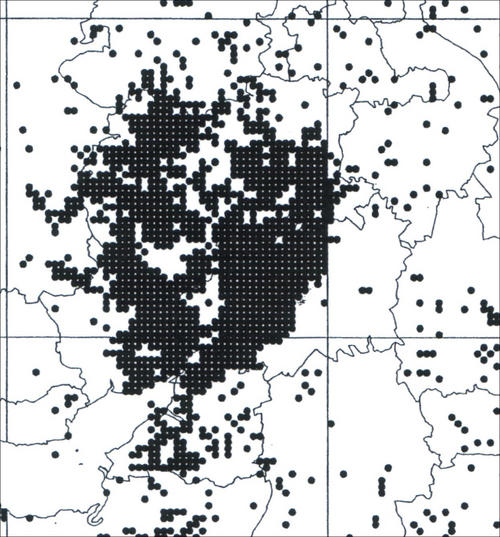
Fig. 02. Main area of Mistletoe distribution centred on the lower Severn valley. ©Jonathan Briggs
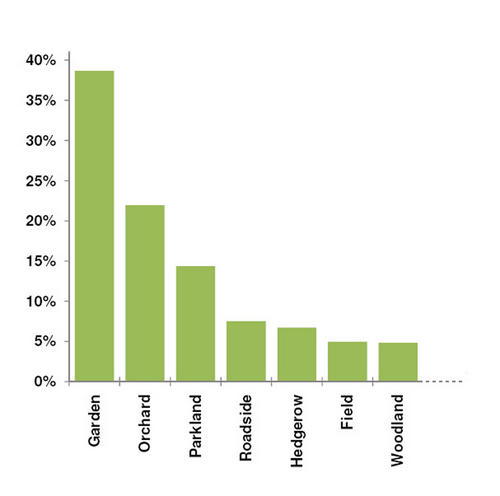
Fig. 03. Mistletoe habitats. ©Jonathan Briggs
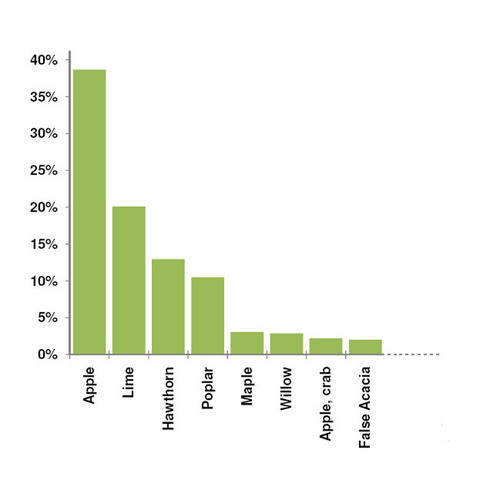
Fig. 04. Main mistletoe hosts. ©Jonathan Briggs
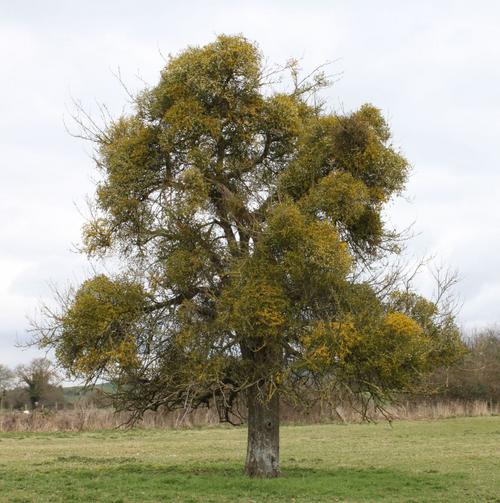
Fig. 05. Apple tree with a very heavy growth of Mistletoe. ©Jonathan Briggs
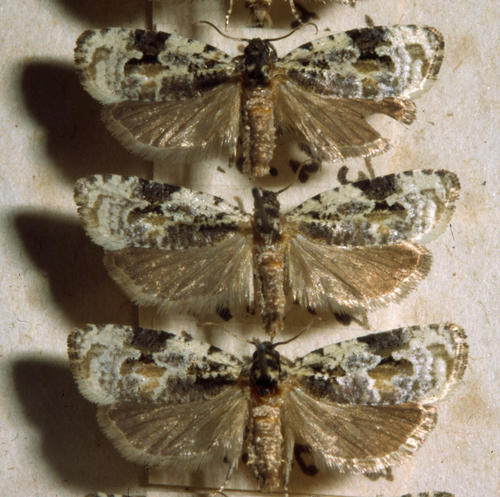
Fig. 06. Celypha_woodiana__Mistletoe_Marble_moth_.Ray_Barnett
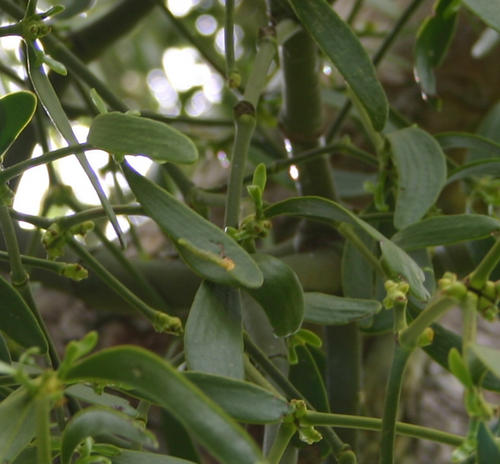
Fig. 07. Celypha woodiana (Mistletoe Marble moth) mine in Mistletoe leaf. ©Jonathan Briggs
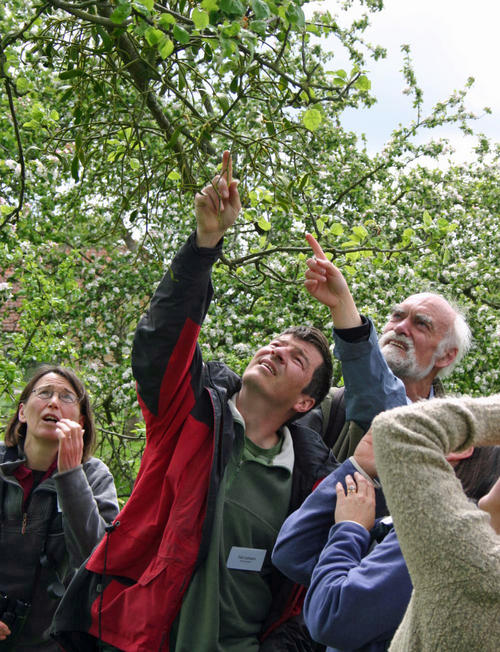
Fig. 08. Celypha woodiana (Mistletoe Marble moth). Searching for mines. ©Jonathan Briggs
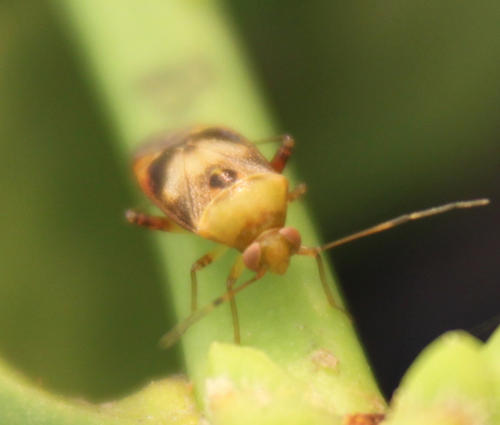
Fig. 09. Pinalitus viscicola (other names Orthops viscicola and Lygus viscicola). ©Jonathan Briggs
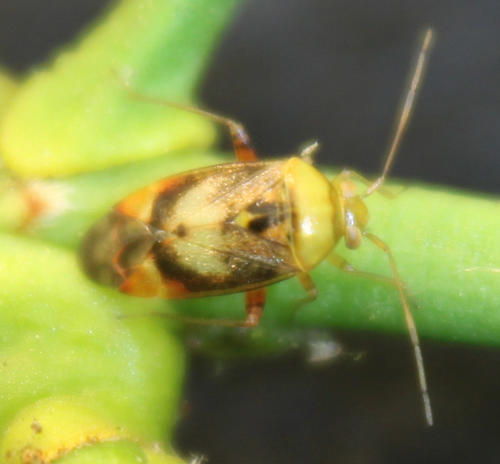
Fig. 10. Pinalitus viscicola (other names Orthops viscicola and Lygus viscicola). ©Jonathan Briggs

Fig. 11. Specimens of Anthocoris visci. Picture ©G H Green

Fig. 12. Ixapion variegatum, the Mistletoe Weevil. ©Jonathan Briggs
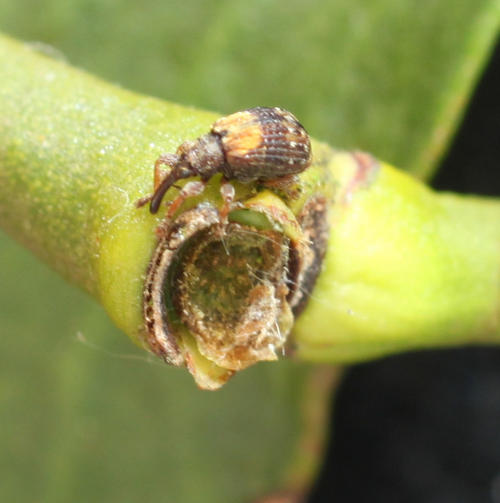
Fig. 13 Ixapion variegatum, the Mistletoe Weevil. ©Jonathan Briggs
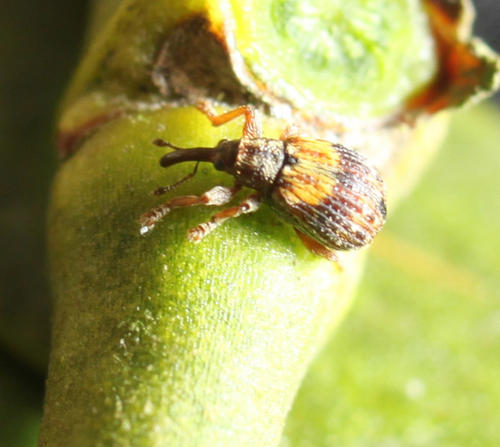
Fig. 14. Ixapion variegatum, the Mistletoe Weevil. ©Jonathan Briggs
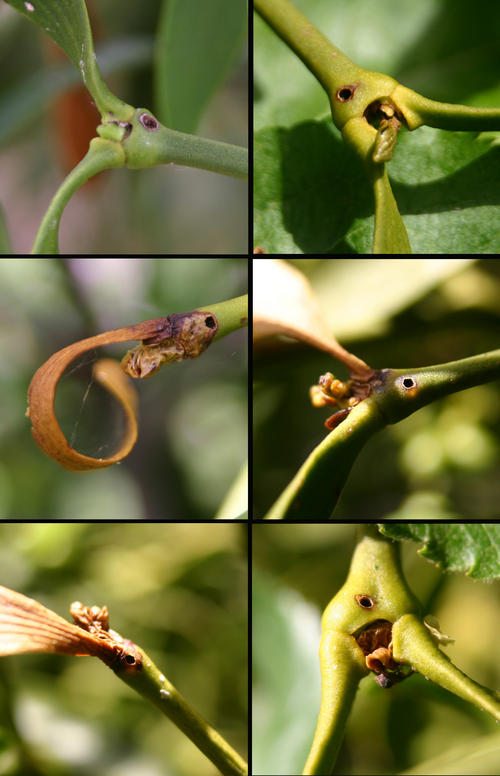
Fig. 15. Six pictures of Ixapion variegatum emergence exit holes. ©Jonathan Briggs
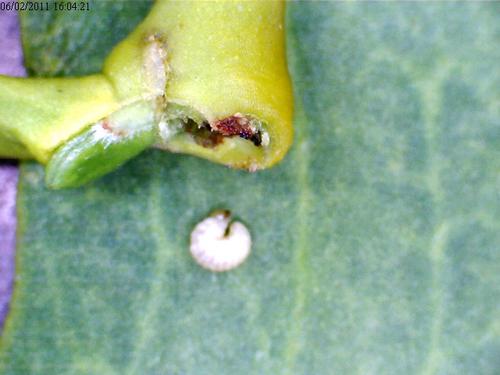
Fig.16. Ixapion variegatum larva extracted from Mistletoe stem below terminal bud. ©Jonathan Briggs

Fig. 17. Honey bee visiting Mistletoe male flower and acting as a pollinator of Mistletoe. ©Jonathan Briggs
Worcestershire Record | 30 (April 2011) (ISSN 1 475-9616) page: 30 | Worcestershire Biological Records Centre & Worcestershire Recorders
Great-crested Grebe nest sailing
John Clarke
I was down at Kemerton Lake Nature Reserve the other day during a gale when I noticed that a Great-crested Grebe’s nest floating across the lake, accompanied by the two adults. A branch supporting the nest (left of nest in pictures) had broken free and the whole thing had set off across the lake. It got about two thirds of the way across when the branch caught in some Potamogeton or other floating plant that stopped its progress. The nest was accompanied all the way by both birds – she tried several times to get onto the nest but it was no longer supported by the branch and partially sank so she had to get off. He swam around, sometimes alert, at other times preening or occasionally diving. It was a pathetic sight and I wished that I could have seen the outcome. They had less than 100m to go to reach the reeds where maybe they could have done some repairs. I guess that the outcome was disastrous but I will try to locate the nest at a later date. (written 26th May 2011).
Image
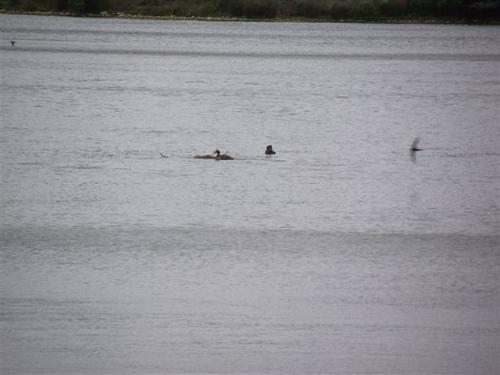
Fig. 1. Great-crested Grebe nest sailing before the wind with pair in attendance. Picture ©John Clarke
Worcestershire Record | 30 (April 2011) (ISSN 1 475-9616) page: 23 | Worcestershire Biological Records Centre & Worcestershire Recorders
Box Bug Gonocerus acuteangulatus in Edgbaston
Andrew Curran
On the 6th April 2011 the following email was received from Andrew Curran:
I decided to have a walk in the large wildlife garden near my home in Edgbaston, Birmingham, on a sunny morning. I came across what I thought to be my first Dock Bug of the year there. I took three pictures just in case. At home I had a look at the photographic guide (Evans & Edmondson) in the evening and suddenly realised that the bug did not seem right for Dock Bug. Then I looked at the various sites available on the internet. To my surprise theinsect looked more like Box Bug Gonocerus acuteangulatus (narrower abdomen at the rear, plain legs & antennal pattern). However, Box Bug should not be expected in the Midlands? I thought you might find my picture (taken on the 6th of April) particularly interesting and see whether the bug is actually a Box Bug or not.
Andrew’s picture was quickly emailed to several Worcestershire naturalists – the response was positive: Andrew had indeed found Box Bug!
John Meiklejohn commented: “The bug keys out clearly to Gonocerus acuteangulatus, Box Bug”.
Others remembered that Gary Farmer had mentioned Box Bug in a talk given at Worcestershire Entomology Day in 2009 as one to look out for as he had seen one in the Cotswolds and the species was known to be spreading. A picture accompanies his follow-up article in the Wyre Forest Review 2009 p56.
The British Bugs website states:
Historically the species was very rare (RBD1) and known only from Box Hill in Surrey, where it feeds on Box trees, this bug is expanding its range and now occurs widely in the south-east and beyond. It is also exploiting different foodplants, and has been found on hawthorn, buckthorn, yew and plum trees. See http://www.britishbugs.org.uk/heteroptera/Coreidae/gonocerus_acuteangulatus.html
This is a species worth looking out for. Superficially it resembles the common Dock Bug Coreus marginatus but is narrower and has sharply pointed extremities to the pronotum rather than bluntly angled.
References
British Bugs website at http://www.britishbugs.org.uk/heteroptera/Coreidae/gonocerus_acuteangulatus.htmlor search for www.britishbugs.org.uk and then for Box Bug in space provided.
Evans, M. & Edmondson, R. 2005. A photographic guide to the shieldbugs and squashbugs of the British Isles. WGUK.
Images
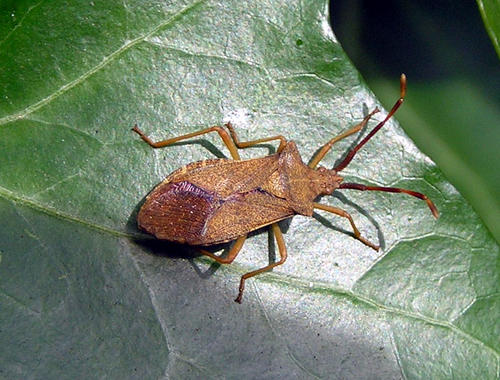
Fig. 1. Box Bug Gonocerus acuteangulatus. ©Andrew Curran
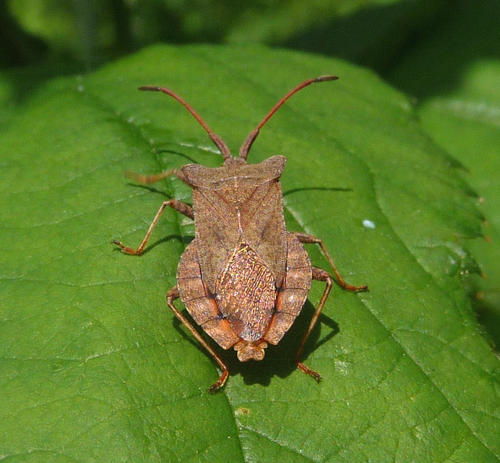
Fig. 2. For comparison a picture of Dock Bug Coreus marginatus. ©Harry Green
Worcestershire Record | 30 (April 2011) (ISSN 1 475-9616) page: 31 | Worcestershire Biological Records Centre & Worcestershire Recorders
The identification of specimens and cataloguing of Worcester Museum Coleoptera (beetle) collection (update June 2011)
David M. Green
davidmxgreen@gmail.com
Begun summer 2010, the identification of specimens and listing of data of the Coleoptera (beetle) collection of Worcester City Art Gallery and Museum, Foregate Street, Worcester, continues. This work was described in the previous issue of Worcestershire Record (Green 2010).
Number of specimens identified so far: 5 781
Number of species identified so far: 1 130
According to museum documentation:
Number of specimens in collection: 11 460
Number of species in collection: 1 772
Therefore approximately:
50% of the specimens in the collection are now identified to species.
64% of the species are now identified to species.
Most of the specimens not yet examined are the weevils and the Staphylinidae on which I am presently working having covered the subfamilies Tachyporinae and Staphylininae. Some specimens have been noted on examination as requiring further work for identification; these I expect to return to when the whole collection has been examined.
Reference
Green, David M. 2010. Identification of specimens and cataloguing of the Coleoptera (beetle) collection of Worcester City Museum and Art Gallery. Worcestershire Record 29:9-10
Worcestershire Record | 30 (April 2011) (ISSN 1 475-9616) page: 31 | Worcestershire Biological Records Centre & Worcestershire Recorders
Worcestershire Record | 30 (April 2011) (ISSN 1 475-9616) page: 31 | Worcestershire Biological Records Centre & Worcestershire Recorders
Dinoptera collaris (Linnaeus, 1758) (Coleoptera: Cerambycidae) specimens at Worcester Museum
David M. Green
davidmxgreen@gmail.com
The longhorn beetle Dinoptera collaris (Linnaeus, 1758) (Coleoptera: Cerambycidae) is currently designated an Endangered species in the UK (JNCC 2011). Specimens of D. collaris are present in the Worcester Museum collection, originating from the collection of J. E. Fletcher of Worcester. The nine specimens were found by Fletcher close to Worcester, most recorded as “on flowers”, in June during the years 1881, 1885, 1883 and the last day of May 1886 – at Oldbury Farm, Temple Laugherne, Earl’s Court Farm and Whitehall. These sites are between the northwest of present day built-up Worcester and Broadheath, excepting “Whitehall” for which I have no unambiguous location. The photograph of one of the specimens from the Museum collection illustrates the distinctive appearance of the species.
According to Hyman and Parsons (1992), D. collaris (under the name Acmaeops) declined dramatically; it is associated with broad leaf woodland, chiefly oak, probably other broad leaf trees, especially on steep slopes on sandy soil. The larvae occur under loose dry bark of exposed rotten roots and pupate in the soil. Adults visit flowers, including blossom of trees.
The photograph also indicates the condition of typical specimens in the Museum collection. The V-cut in the specimen card mount is apparently to enable close-packing of the cards, such that the pin through the card in front fits into the V. This strange technique is quite often used in the collection. The cards are typically pinned into the drawer using a headless pin. All the specimens possess some surface dirt as can be seen in the picture, but seldom as to prevent satisfactory examination to identification.
References
JNCC 2011. Conservation Designations for UK Taxa. Taxon_designations_20110121.zip – http://jncc.defra.gov.uk/page-3408(10 June 2011)
Hyman, P.S and Parsons, M.S. 1992. A review of the scarce and threatened Coleoptera of Great Britain (1). U.K. Nature Conservation No. 3. JNCC.
Image

Fig. 1. The longhorn beetle Dinoptera collaris in the Worcester Museum collection. ©David M Green
Worcestershire Record | 30 (April 2011) (ISSN 1 475-9616) page: 51 | Worcestershire Biological Records Centre & Worcestershire Recorders
Buzzard stories
Harry Green (compiler); Martin Skirrow; Rob Harvard
Buzzard versus peregrine
Martin Skirrow
Yesterday (13th December 2010)), here at the farm near Berrow) at about 15.00hrs, I heard an agitated “kek-kek-kek-kek” and saw a female peregrine swooping repeatedly at something on the ground fractionally below my line of vision. After a couple of minutes to gain a suitable vantage point, I saw a buzzard fly up from the point of focus and make off with a carcase. The peregrine had given up a few moments before. On inspecting the site, there was a mass of scattered pigeon feathers and fresh blood. I assume the peregrine had made the kill only to have it stolen. In the nearby trees were many pigeons (flocks of 300+ have been around for several days) which, after the entertainment of seeing someone else eaten, departed. There was another fairly fresh pigeon kill site close by.
All this within 200 metres of my dwelling. Watching that peregrine with its swoops and Immelmann turns called to mind demonstrations at the Falconry Centre, except that instead of Jemima Parry-Jones with a lure there was a buteo with some booty!
Buzzards versus ducks
Rob Harvard
Cycling in this morning (12th April 2011) over the Severn bridge at the Ketch (S edge of Worcester) a Buzzard was hovering above the bridge and swooped down to attempt to take two ducks in flight as they were about to fly under the bridge. I’ve never seen anything like this since I saw a buzzard land on a pheasant when working in Wiltshire. I’ve noticed a pair of Buzzards often hovering above this bridge. Maybe they have found an easy way to hunt here?
Editors’s Note
Don’t underestimate buzzards – they ain’t a success story for nothing! Good addition to the Worcestershire Record series on what buzzards eat and do. The variety is endless. Please send in your stories
Image
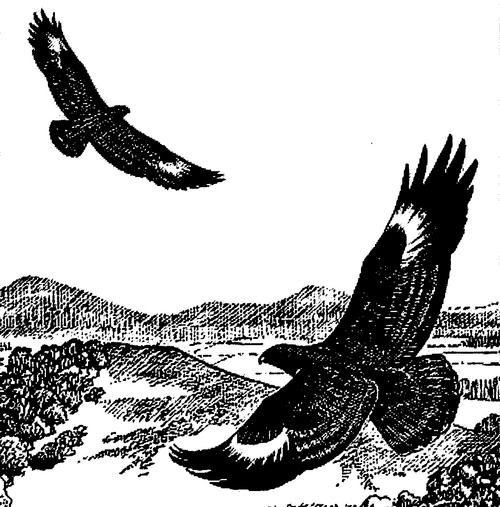
Fig. 1. Buzzard Drawing by Ray Bishop
Worcestershire Record | 30 (April 2011) (ISSN 1 475-9616) page: 22 | Worcestershire Biological Records Centre & Worcestershire Recorders
Adomerus biguttatus ( = Sehirus biguttatus), the Cow-wheat Shieldbug re-found in Worcestershire
Harry Green (compiler)
On 30th March 2011 Nick Button found the shieldbug Sehirus biguttatus by the side of a ride in Worcestershire Wildlife Trust reserve Monkwood, near Sinton Green. The Worcestershire Biological Records Centre database contains two previous records from Monkwood dated August 1968–June 1970. Of these, one grid reference is for the centre of the wood, the other at the north end. The records are by I L Crombie and the time span suggests he found them in the wood on several occasions. Apparently Monkwood has been the only known location in Worcestershire for many years: there are also records from the Shropshire part (north side) of Wyre Forest.
The British bugs website states: A medium-sized shiny black shieldbug which has a pale margin to the pronotum and forewings and two pale spots on the corium. This species can be found under stands of the foodplant, Cow-wheat Melampyrum pratense, growing in sunny woodland clearings and rides. There is one generation per year, the new generation becoming adult in August. Scarce, with a scattered distribution mainly confined to southern England and south Wales. It has declined in recent years due to the widespread neglect of traditional woodland management practices which create suitable cleared areas.
Evans & Edmondson (2005) note that it is a ground living species found in the sunnier parts of woodlands on various soils. In Worcestershire the associated food plant, Cow-wheat, tends to have a more westerly distribution. This being so, and encouraged by Nick’s record, the Wyre Forest Study Group searched hard for the bug and found it on 16th April 2011 near Uncllys in Wyre Forest. Rosemary Winnall writes as follows:
On a recent field trip, the Wyre Forest Study Group was delighted to find a small insect that some members had been searching for for a while! Paul Allen (ably encouraged by Brett Westwood) eventually spotted the tiny 5.5mm long shieldbug Sehirus (Adomerus) biguttatus on a sunny bank in leaf litter under its food-plant Common Cow-wheat Melampyrum pratense. In previous searches we had been looking on the plants, but Paul instead heaped some leaf litter from below the Cow-wheat into a white tray and searched through carefully. No others were found in spite of checks on the food-plants – perhaps it comes out to feed at night? The shieldbug was fast moving and was not keen to be photographed!
It seems likely that this species will occur at other sites in Worcestershire where there is Cow-wheat. It is however hard to find. The early stages are probably present during June and July. The full-grown insect may be found from August through to the following spring. Since Monkwood became a nature reserve there has been a programme of re-instating coppice regimes and widening the main ride. Both these practices have created open sunny areas favoured by the bug so hopefully the population will grow. Nationally the species appears to be uncommon with widely scattered records shown on the map derived from the NBN website but this may perhaps reflect its elusiveness rather than great rarity.
References
British Bugs website at http://www.britishbugs.org.uk/heteroptera/Cydnidae/adomerus_biguttatus.htmlor search for www.britishbugs.org.uk and then for Adomerus biguttatus in space provided.
Evans, M. & Edmondson, R. 2005. A photographic guide to the shieldbugs and squashbugs of the British Isles. WGUK.
Images
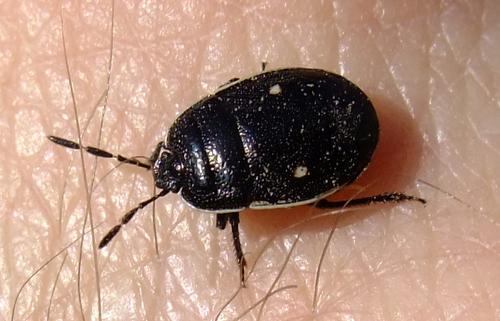
Fig. 1. Adomerus biguttatus (Sehirus biguttatus), Monkwood, March 2011. ©Nick Button
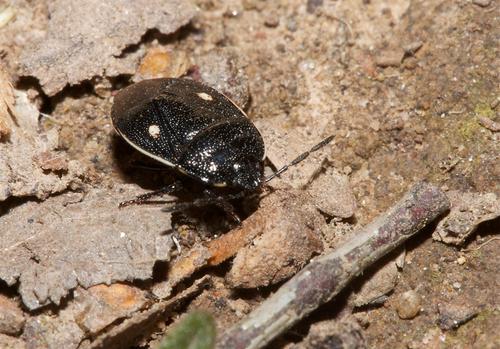
Fig. 2. Adomerus biguttatus (Sehirus biguttatus), Wyre Forest, April 2011. ©Rosemary Winnall
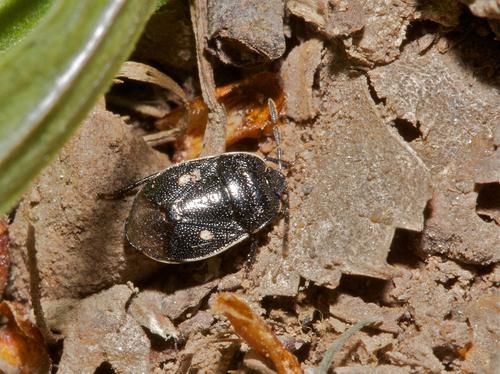
Fig. 3. Adomerus biguttatus (Sehirus biguttatus), Wyre Forest, April 2011. ©Rosemary Winnall
Worcestershire Record | 30 (April 2011) (ISSN 1 475-9616) page: 33-34 | Worcestershire Biological Records Centre & Worcestershire Recorders
Hornet stories: Hornets stripping bark and also catching fly; Hornet nest in cordwood near Tiddesley wood and in old nest box
Harry Green
(compiler)
In recent years the rapid spread of hornets throughout most for Worcestershire from western strongholds has given rise to a number of stories reported in previous issues of Worcestershire Record. Here are a couple more. The editor is always interested to receive more!
Hornets stripping bark and also catching fly
This picture (Fig. 1) was sent to Caroline Corsie at Worcestershire Wildlife Trust by Douglas Gregor. He wrote: in case it is of interest I attach a photograph of a couple of hornets stripping bark from an ash sapling in Monkwood at the end of October. Flies were beginning to irritate them and in this picture one of the hornets did take its vengeance! The question is, why were they stripping living bark? Perhaps to obtain sap which, once flowing, would probably attract flies. Many insects, including wasps and hornets, are attracted to sap runs on trees, especially as they develop the late-season sweet-tooth.
Hornet nest in cordwood near Tiddesley wood and in old nest box
Harry Green
Volunteers working at the old barns near Tiddesley Wood, Pershore, were fascinated watching many hornets flying in and out of a small hole is a large (about 2 metres long) piece of beech destined for firewood logs. When the time came for logging-up the contactor carefully cut open the log with a chain saw to reveal the carton nest build along a narrow tunnel over one metre long, here illustrated (Fig.2, Fig. 3 & Fig. 4). Irregularly constructed hornet nests are commonplace iin tree cavities while those hanging free in roof-spaces or the like are usually more or less globular in construction.
Hornets often take over nest boxes put up for birds. These are usually too small for purpose and hornet nest construction flows round the outside of the box. In 2010 hornets occupied an old nest box in Tiddesley Wood. The box is a bit larger than the usual tit box and was becoming rotten as the hornets chewed through the bottom and probably used the paper manufactured from that source to help construct their nest (Fig. 5, Fig. 6 & Fig. 7)
Images
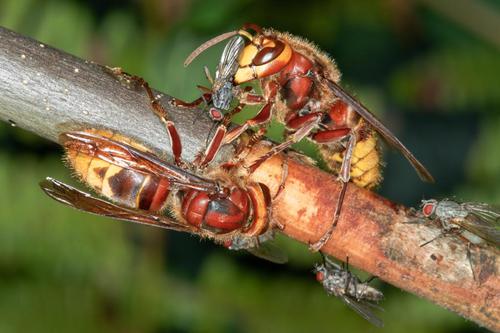
Fig. 1. Hornets stripping bark on ash sapling and catching fly. Picture ©Douglas Gregor.
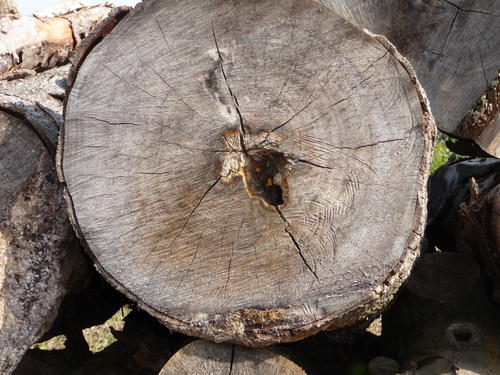
Fig. 2. Entrance to hornet’s nest in beech cordwood. Picture ©Harry Green.
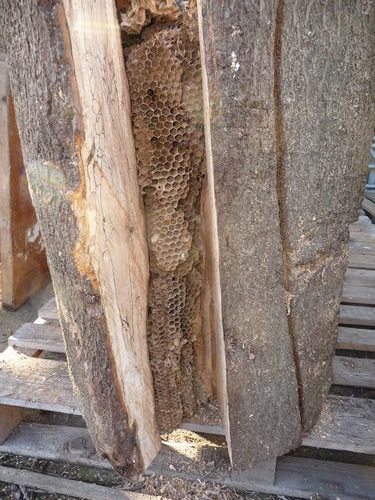
Fig. 3. Hornet nest about one metre long in rotting beech log cavity. Picture ©Harry Green.
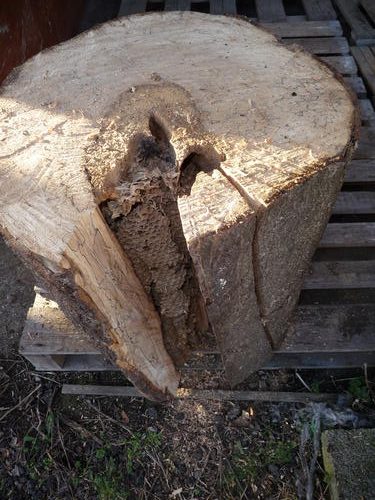
Fig. 4. Hornet nest about one metre long in rotting beech log cavity. Picture ©Harry Green.
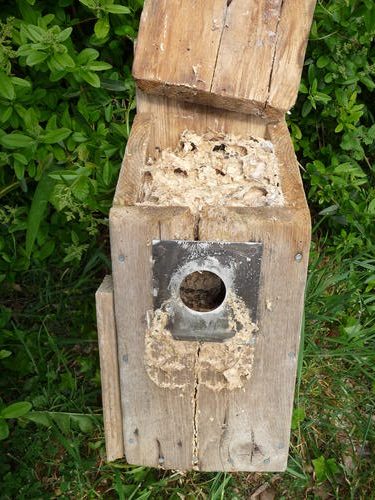
Fig. 5. Hornet nest in nest-box. Those parts of the nest exposed to the weather on the outside of the box have disintegrated. Picture ©Harry Green.
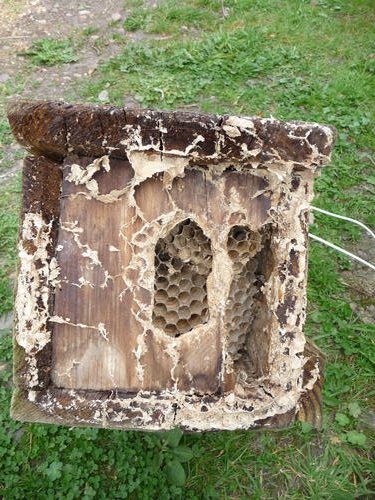
Fig. 6. Hornet nest in nest-box. The hornets have chewed through the base of the box. Picture ©Harry Green.
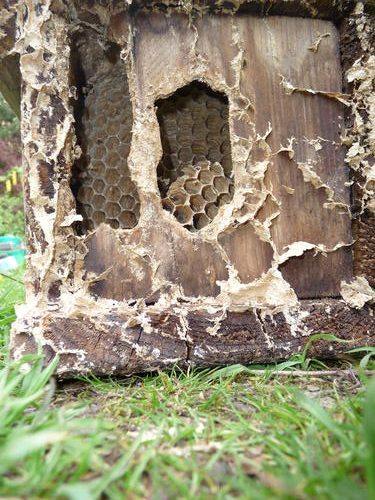
Fig. 7. Hornet nest in nest-box. The hornets have chewed through the base of the box. Picture ©Harry Green.
Worcestershire Record | 30 (April 2011) (ISSN 1 475-9616) page: 32 | Worcestershire Biological Records Centre & Worcestershire Recorders
New species [in Africa] for a Worcestershire recorder [Will Watson]
Harry Green
For the naturalists of Worcestershire Will Watson is a familiar face. He is a freshwater ecologist who used to live in Worcester and now lives near Bromyard. He often contributes records to the Worcestershire Biological Records Centre and adds an aquatic dimension to our special recording days. He has recently received an unexpected honour, probably unique in the annals of our local naturalists. In January 2011 we were delighted to receive the following email (Ed).
An email from Will: “Great news. I am able to confirm that I did discover a new species of water beetle on the Manda Wilderness Reserve in Mozambique. The beetle was found during both of my trips in 2008 and 2009. It has been named Haliplus watsoni which is a little bit embarrassing but a great honour. It has all been written up in a Dutch scientific paper Netherlande Entologische Vereniging: http://www.nev.nl/tve/html African Haliplidae (Coleoptera) by Bernhard J. Van Vondel. Volume 153 239-314 December 2010.
PRESS RELEASE:
Herefordshire man discovers new species
Over the course of two scientific expeditions to the subtropical rainforests of Mozambique, Will Watson, Wildlife Consultant from Docklow discovered a species of water beetle new to science. The 2.7 mm long diving beetle has been named Haliplus watsoni. Will says:
“I am absolutely chuffed to have found a new species of beetle and honoured to have it named after me. This is a particularly rare accolade as it is not normal convention to name species after the finder. The expedition had its moments of risk. I was initially concerned by that I might be confronted by crocodiles and hippos. However, in the end I was infected by the microscopic parasite which causes bilharzia. But this makes all the pain and effort worthwhile”
The water beetle was discovered in 2008 in a floodplain pool on the Manda Wilderness Community Game Reserve which is managed in association with the local community by Nkwichi Lodge. The reserve is in northern Mozambique in the Great Rift Valley and borders Lake Niassa (also known as Lake Malawi) which is 365 miles long and 55 miles wide and is the 9thlargest lake in the world. Further water beetle specimens were collected on a second trip to Mozambique in 2009. The reserve covers 130 000 hectares; just over half the size of Herefordshire but with a fraction of its population. It is an unspoilt wilderness with Brachystegia forest, savannah, swamps, streams, mountains and miles of sandy beaches with crystal clear water.
It took a year and half for the beetle’s identity to be confirmed by international water beetle expert Bernhard Van Vondel and others in the scientific community. Its discovery comes at a time when the Mozambique Government and the World Wildlife Fund are in the process of establishing the Lake Niassa Reserve and the Manda Wilderness Community are developing eco-tourism on their reserve. This find indicates how valuable the surrounding freshwater habitats are for biodiversity and should help inform and direct conservation efforts.
Images
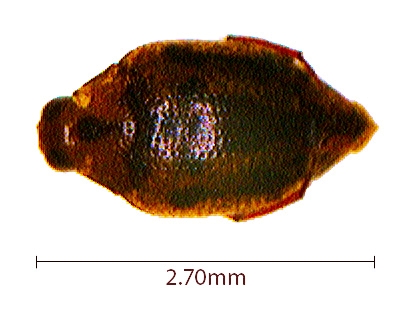
Fig. 1. Haliplus watsoni. Picture ©Will Watson
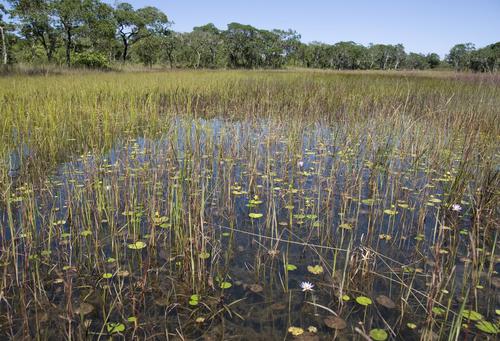
Fig. 2. The floodplain pool in northern Mozambique where the beetle was found. Picture©Will Watson
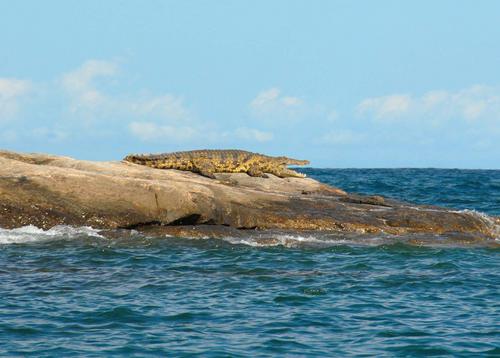
Fig. 3. Nile Crocodile photographed on Lake Niassa in 2008. Picture ©Will Watson
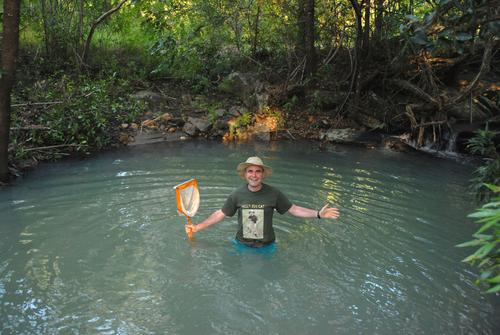
Fig. 4. Will with his pond net in a lakeside pool. Picture ©Will Watson
Worcestershire Record | 30 (April 2011) (ISSN 1 475-9616) page: 38 | Worcestershire Biological Records Centre & Worcestershire Recorders
Bechstein’s Bat – the national survey comes to Worcestershire
James Hitchcock
The Bechstein’s Bat Myotis Bechsteinii project is part of the National Bat Monitoring Programme which began in 2007. The project aims to survey woodlands in Southern England and South Wales over a four year period using a new trapping technique. The project works with local bat groups to help with the surveys. Gathering useful information on the bat’s range and its habitat preferences are a key objective of the survey.
Bechstein’s Bat is one of the rarest mammals in the UK, and a UK Biodiversity Action Plan priority species (Bat Conservation Trust). It has proven difficult to detect in previous attempted surveys as it rarely leaves the canopy of its favoured broadleaf woodland habitat. The current survey is the first time that anyone has attempted to map its distribution and to obtain information to inform woodland management.
Frank Greenaway and David Hill, who are leading Bat researchers, have developed and tested a technique to relay ultrasonic social calls to locate Bechstein’s Bats. The project is relying on the involvement of experienced, specially trained volunteers recruited through the local bat group network, and the support of landowners and woodland managers.
The plan is to survey four or five counties or areas during each year of the project. The 2009 survey focused on Cornwall, Devon, Dorset, Kent, Oxfordshire and Surrey.
In 2010 the project came to Worcestershire – along with Gloucestershire, North Buckinghamshire and Somerset – with the local Worcestershire bat group surveying 15 woodlands around the county, catching 101 bats of nine different species. In total six Bechstein’s were caught at three different sites (Records from Jane Sedgley; Worcestershire Bat Group) in the county, one of which, Grafton Wood, is owned and managed by Worcestershire Wildlife Trust (WWT) and Butterfly Conservation (BC). Another site is Romers Wood, owned and managed by Herefordshire Nature Trust. The third site is not being named as it is in private ownership and has no public access.
In Britain the last population estimate for Bechstein’s Bat in 1995 put the pre-breeding number at just 1500 (Bat Conservation Trust). The UK is currently on the northerly edge of the known breeding range. Bechstein’s are most often associated with broadleaved woodland, needing at least 25 hectares to support a nursery colony. Mature trees between 80-120 years of age are required along with a good supply of old woodpecker holes where the bats set up their roosts. They feed by hawking and gleaning. Its low population density combined with an exacting set of habitat requirements make it particularly vulnerable to habitat loss.
The records gathered from this work are currently the most northerly that are known for the species. Because of this further survey work is being planned by WWT and BC to try and identify which areas of Grafton Wood are being used by the bats. We also hope to try and identify other woodlands in the surrounding area that are inhabited and ascertain if they are important in supporting the local population. The national survey only allowed one woodland per 10km square to be visited so there is certainly scope for visiting woodlands around Grafton Wood, such as Trench Wood. The work will hopefully be done as part of the national project through the Worcestershire bat group but it is likely that any radio tracking to identify roosts will be carried out by paid consultants funded by the Trust. We are delighted to find the Bechstein’s in our woodland and are currently working through the management guidance literature to ensure that we take account of the habitat requirements of this species during forestry work.
Images
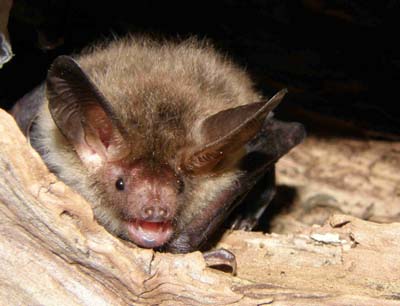
Fig. 1. Bechstein’s bat. Picture © Derek Smith.

Fig. 2. Grafton Wood showing habitat favoured by Bechstein’s Bat. Picture ©James Hitchcock.
Worcestershire Record | 30 (April 2011) (ISSN 1 475-9616) page: 40 | Worcestershire Biological Records Centre & Worcestershire Recorders
Harsh winter for wrens
Garth Lowe
The winter at the end of 2010 was a particularly harsh one, starting very early with the first snow on the 26th Nov and the cold spell continuing through most of December. On nine days in this period the maximum temperature at Old Storridge never got above 0°C with some night temperatures dropping to -10°C.
These conditions put a great strain on the resident birds especially those with the least body mass such as the wren. A timely reminder from a resident of Birchwood Lane, just a ten minute walk through the woods, encouraged us to see a phenomena not observed very often. During the last winter he had observed a number of wrens going to roost in a bird box attached to one corner upright of an open barn used as a workshop, and claimed there were at least twenty entering the box. On the evening of the 19th December 2010 with the daily maximum having only reached -3°C that day, I met my sister Cherry Greenway and her husband to see how this activity actually worked.
In snowy conditions I arrived at the box at around 3 40pm with no birds to be seen and I thought it was too late and they all must be in the box as it was so cold. By 3 55 three pairs of eyes were studying the box when the first wren arrived, hung about for a bit and then went in only to reappear again as if to say I am not going to be the first! This was repeated a few times by more wrens, which had started to arrive. By 4 10pm just a few had stayed inside, but others kept on arriving and continuing with the in and out action.
By nature this bird cannot be called a social bird, setting up territories in the spring and defending them against other male wrens, so this winter gathering has to overcome that part of their make up. It is an ingenious scheme, all huddling together in a sheltered area through long cold nights, so saving on the loss of body heat. The speculation is how did this evolve?
The numbers going into the box continued to be monitored with the figure rising steadily, but dropping back still as a few birds kept coming out. The figure of 20 was soon passed and then 30, which we thought quite unbelievable in one normal sized bird box. A figure of 40 was then reached, with more wrens still arriving by the minute and queuing up around the site, so it was speculated we might even reach 50! At 4 30pm things went very quiet so the observation was terminated. It is true to say that 50 wrens were seen to go in but two came out at the end and went elsewhere, leaving still an incredible figure of 48 all tucked up warmly inside.
It is also a remarkable fact that there were still so many wrens still alive in the surrounding district with the inclement conditions. Since this number could not all be living closely around the site, some birds must have flown in quite a distance from their territory to the box. The last question of course is just how all these birds get to know that there is a wren Hilton, where they all gather for the night? Memory must work quite well as it was used last year, but how did all those youngsters from this year cotton on to this fact?
It was a magical 45 minutes watching the wrens performing their going to bed actions, which must have taken place night after night in the long period of intense cold.
Worcestershire Record | 30 (April 2011) (ISSN 1 475-9616) page: 40 | Worcestershire Biological Records Centre & Worcestershire Recorders
Worcestershire Record | 30 (April 2011) (ISSN 1 475-9616) page: 23-24 | Worcestershire Biological Records Centre & Worcestershire Recorders
Striking red and black bugs (Hemiptera – Heteroptera) in Worcestershire
John Meiklejohn
(There is an increasing number of sightings of striking red and black bugs in Worcestershire. Hopefully this article will encourage readers to look out for them and send in records. Ed.)
Eurydema ornata (Fig. 1.)
In March 2000 I was given a striking red and black coloured shield bug that had emerged from purchased broccoli in a house in Westmancote, on the southern slope of Bredon Hill. Using P.Kirby’s Draft Key for British Heteroptera, it was identified as Eurydema ornata. The British Bugs website states: a relatively recent arrival in the UK, but now established in the Channel Isles, and in Dorset and Hampshire; it may also appear at other places in south England. It spends the winter as an adult and feeds on crucifers, including cress, radish and cabbages.
Eurydema dominulus is very similar to and slightly smaller than E. ornata. It lacks the dark spot on the embolium of the wing. There are a few U.K. records for this species, mainly from Kent and Sussex. The British Bugs website states: a very scarce species found in woodland rides in parts of southern England. Most records are from Kent and Sussex.
Eurydema oleracea (Fig.2.)
In June 2005, whilst with a party from the South-east Worcestershire local group of the Worcestershire Wildlife Trust in the Umbria region of Italy, I collected another brightly coloured, red and black shield bug. This was determined as Eurydema oleracea, the Brassica Bug, a bug associated with cruciferous plants, particularly with Horse-radish, Armorica rusticana. The form with the red markings is less common than the form with white markings. There are records in Worcestershire Biological Records Centre for this bug from John Partridge, 2004, and Kevin McGee (2007). Kevin published the picture (Fig. 2) and wrote as follows: The Brassica Bug. My first UK records for this mainly southern species were both from Oilseed Rape flowers near Deerfold Wood, Drakes Broughton on 5.5.2007 & 20.5.2007.
The British Bugs website states: well distributed in southern and central England; may be locally frequent and appears to be increasing in abundance.
Corizus hyoscyami (Fig. 3).
Another similarly coloured bug which is becoming more common than the above species is the rhopalid bug Corizus hyoscyami. It has spread from the south-west of England where it was first recorded and was first found in Worcestershire in the Redditch area in 2006 by Gary Farmer. It is a polyphagus species and known to feed on Storksbills. There are five Worcestershire records for it in Worcestershire Biological Records Centre. The British Bugs website states: locally distributed in sandy habitats around the coasts of southern Britain, this species has recently been found more frequently inland. It is associated with a range of plants, and overwinters as an adult, the new generation appearing in August-September. Nymphs are yellow/red-brown in colour and also rather hairy.
McGee (2007) also wrote as follows: Corizus hyoscyami (Rhopalidae, local). One of these striking red & black bugs was found on ground vegetation in the garden of ‘The Newalls’ at the Wyre Forest by John Partridge at the end of a Wyre Forest Study Group field trip on 21.4.2007. Just as I was about to take a photo it took flight and was not relocated! Please also see page 41 of the November 2006 issue of the Worcestershire Record for previous reports of this species which is yet another spreading up from the south.
Pyrrhocoris apterus
A red and black bug that has to date only been regularly recorded from a rock off the coast of South Devon but is common in Europe is the Red Fire Bug, Pyrrhocoris apterus. It can easily be confused with Corizus hyosciami but as it is associated with Tree Mallow it is unlikely to turn up in Worcestershire.
References
The British Bugs web site is a useful source of information and pictures: http://www.britishbugs.org.uk.
Evans, M & Edmondson, R. 2005. A photographic guide to the Shieldbugs and Squashbugs of the British Isles. Published by WGUK in association with WildGuideUK.com.
McGee, K 2007. Records of Note 2007. Worcestershire Record 23:42-46.
Images

Fig.1. John Meiklejohn’s specimen of Eurydema ornata. Picture ©Harry Green.
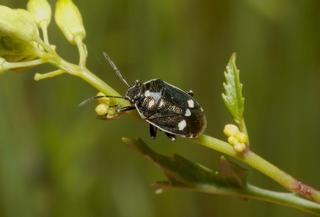
Fig.2. Eurydema oleracea. The white and black form with red marks replaced by white. Picture ©Kevin McGee.
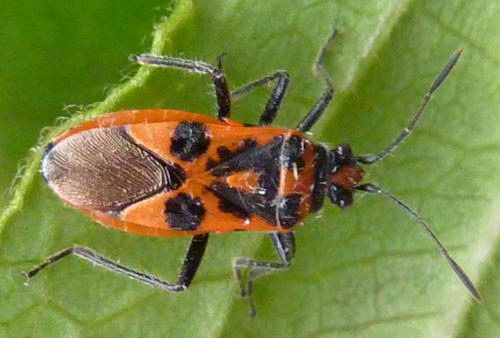
Fig.3. Corizus hyoscyami at Grafton Wood 3rd January 2011. Picture ©Tony Simpson.
Worcestershire Record | 30 (April 2011) (ISSN 1 475-9616) page: 25 | Worcestershire Biological Records Centre & Worcestershire Recorders
The Terrapins of Worcestershire County Hall
Wade Muggleton
For many years at Worcestershire County Hall there has been a story of Terrapins living in the ornamental lakes in front of the building. When I started working here it seemed a bit of a farfetched story, but it is true enough and here is a photo I took of them. They have been living here now for well over a decade, there are at least three, possibly more; one colleague claims to have seen six at once, and they obviously find enough food to prosper in what is a shallow man-made lake with little decent habitat or marginal vegetation. In the summer they can often be seen basking out on the brick work, and seem quite acclimatised to the comings and goings of people.
The largest one is probably 14 inches or so across and despite the lakes freezing over completely on various occasions they seem to survive. There is of course the question of whether their prosperity comes at the expense of the general ecology of the lakes; I believe they have a reputation for eating almost anything.
The most likely explanation for their presence is that they were released following the children’s TV craze of Mutant Ninja Turtles in the 1990’s. Like many reptiles they can be long lived and despite originating in far warmer climes they seem to have adapted to life at County Hall well enough.
Wade Muggleton, Senior Community Greenspace Officer, The Countryside Centre, Wildwood Drive, Worcester, WR5 2LG. 01905 766491.
Note
County Herpetologist Alan Shepherd comments as follows:
They are Trachemys scripta-elegans the Red-eared Slider. The red “ear” markings are not very visible but can be discerned on the larger specimen, which incidentally is a female as males have longer front claws. The ear markings can be variable and there is a yellow variation, which i think was bred up in captivity. Look at http://en.wikipedia.org/wiki/Red-eared_slider for more information.
Image
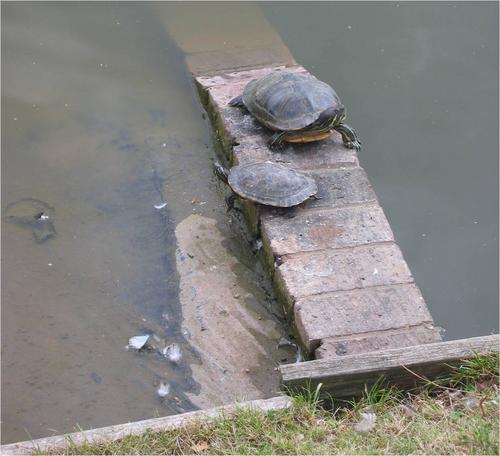
Fig.1. The Terrapins (Red-eared Sliders) of Worcestershire County Hall ©Wade Muggleton
Worcestershire Record | 30 (April 2011) (ISSN 1 475-9616) page: 39 | Worcestershire Biological Records Centre & Worcestershire Recorders
Birds in Worcestershire – November 2010 to April 2011
Gavin Peplow
This last winter will be remembered as the coldest for several decades, with in particular heavy snowfall and extensive sub-zero temperatures during December. Though milder from January, this has overall been a very dry season, with clear sunny days in March developing in to an early spring. The impact on our smaller bird populations of these conditions has yet to be revealed.
A party of four White-fronted Geese lingered at Bittell into November whilst a Great White Egret was watched briefly at the same site mid-month – the first locality record. ‘Sawbills’ were well represented with single Red-breasted Mergansers at this last locality and also at Bredon’s Hardwick, whilst redhead Smew were seen at Westwood Pool and at Lower Moor. A ringtail Hen Harrier was seen near Bewdley whilst Upton Warren attracted a passage Short-eared Owl and two Bitterns were seen there intermittently. Scarcer Gulls included both a Little Gull and a Kittiwake at Clifton Gravel Pits and two Caspian Gulls at Throckmorton Tip. A Grey Phalarope one evening at Westwood was exceptional in being the third record of this species for the autumn.
Good numbers of Waxwings arrived in the north and east of the UK and a party of 14 birds were seen briefly at Chaddesley Corbett mid month. A Water Pipit at Lower Moor was only the second site record, whilst a Snow Bunting on the Malverns was more predictable. Following the earlier autumn influx, a single Lapland Bunting was heard over Bredon Hill but unfortunately wasn’t seen to land. Hawfinches appeared in reasonable numbers at Chase End with up to six birds counted.
As winter began to bite in early December, six Bewick’s Swans and a Great Grey Shrike were seen briefly at Clifton Gravel Pits, whilst a Black-necked Grebe there lingered a bit longer before leaving when the main pit froze over. An unexpected find was a Dartford Warbler on the north east side of Evesham. It was found one frosty morning in an old apple orchard and stayed for a week before disappearing. A second year Glaucous Gull visited Throckmorton Tip and a Snow Bunting was seen on the north Malverns mid-month, though the highlight was a party of seven Bean Geese that stayed a few days at Clifton Pits until snow covered their favoured feeding area and they moved on. Waxwing numbers built up extensively across the County with the highest count being 135 at Tenbury, adding to the local interest of a Bittern feeding in the open along the banks of the River Teme, right on the edge of town! With no respite from the weather, an adult Whooper Swan was seen at various points along the River Severn before it ended up joining the Mute Swan flock in the middle of Worcester at the end of the year, thereafter remaining there through to the spring. A Firecrest was reported in the Wyre Forest and nearby a sub-adult drake Smew attracted much interest as it tried to find food on an unfrozen section of the river in Bewdley.
Temperatures eased a little from early January and there was a good selection of scarcer birds seen over the month. Main highlights included Iceland and Caspian Gulls at Throckmorton, with another of the last species also seen at Wildmoor Tip near Bromsgrove. Wildfowl were represented by two Bewick’s and a Whooper Swan at Bredon’s Hardwick, two White-fronted Geese at Lower Moor and a Scaup at Bittell. Two Mealy Redpolls were seen at Stourport and Hawfinches were regular visitors to Lodge Hill Farm in the Wyre Forest. The month concluded with a Great Grey Shrike being seen briefly at Bredon’s Hardwick.
Perhaps the same wandering Shrike was reported near Upton-upon-Severn a couple of weeks later in mid-February whilst elsewhere a very early returning Avocet appeared at Upton Warren. A Mediterranean Gull became a regular visitor at this last site from later in the month, a Kittiwake visited nearby Westwood and another Caspian Gull was found at Wildmoor Tip. Bittell attracted a drake Scaup followed by a drake Red-breasted Merganser a week later. Waxwings continued to be seen in good numbers but were generally elusive as they moved on quickly in their search for food.
Presumably two different Scaup were again at Bittell on a single date in early March and one or two White-fronted Geese continued to be seen occasionally at Lower Moor. A Glaucous Gull visited Throckmorton Tip on a couple of dates during the second half of the month and the Whooper Swan that had been wintering in Worcester, dropped into Upton Warren for a couple of hours. Hawfinch numbers peaked at an exceptional 22 in the Wyre Forest on a single date, with otherwise only single figure counts being reported. Several Mealy Redpolls were seen and/or trapped at the Knapp and Papermill reserve at Alfrick and included one bird believed to be of one of the northwestern races from Iceland or Greenland. A Black Redstart was found on Clent and early returning migrants were widely reported from the second week. What was believed to be the same Great Grey Shrike eventually settled down on Bredon Hill and was then seen at various locations around the Hill over the next few weeks.
April proved to be an excellent month in the County, with a good range of scarce and unusual species being found. Birds such as Little Egret, several Marsh Harriers, Wood Sandpipers and the last few Waxwings from the winter invasion only making up a strong supporting cast! A Hoopoe flew across Upton Warren Moors Pool one early morning early in the month, but unfortunately couldn’t be relocated. A strong Ring Ouzel passage included up to 12 birds on Bredon Hill, whilst a Blue-headed Wagtail – a subspecies of the more familiar Yellow, spent a couple of days at Ripple. A very good count of eight Little Gulls spent an afternoon at Upton Warren mid-month, with observers watching these delightful ‘larids’ also picking up an Osprey flying over and a Sandwich Tern – the latter probably being the same as one seen at Lower Moor earlier in the day. A few Arctic Terns were noted and a Black Tern was seen at Clifton Pits. A Spoonbill spent about ½ hour at Upton Warren Flashes before moving on and two Common Cranes were even briefer, only being seen in flight over Churchill near Redditch as they headed north.
Without doubt the highlight of the month was a Bluethroat that was first seen hopping around the base of reed stems at the Hen Pool, Upton Warren one late afternoon during the last week. Unfortunately it was very elusive, although it did show itself singing for a brief period the following morning before disappearing completely. It was a male of the white-spotted race and only the third ever County record (the other two both being of the red-spotted race). The month concluded with a strong passage of Bar-tailed Godwits – 27 flew over Upton Warren one evening and a further nine flew through the new John Bennett reserve at Birlingham.
Records compiled from reports received by Birdline Midlands. For all the latest information on birds currently within Worcestershire and the Midlands Region, call 09068-700247 (calls charged at 60p per minute).
Image
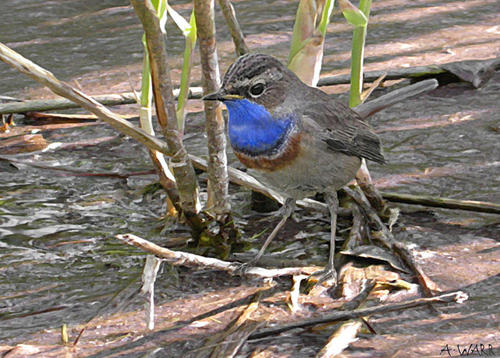
Fig.1. White-spotted Bluethroat at Upton Warren, April 2011. Computer generated painting © Andy Warr.
Worcestershire Record | 30 (April 2011) (ISSN 1 475-9616) page: 30 | Worcestershire Biological Records Centre & Worcestershire Recorders
Smooth x palmate newt hybrid in a Wyre Forest garden pond
John Robinson
Fig. 1 shows a Palmate x Smooth Newt hybrid found in one of my three ponds in the garden in Wyre Forest which has a good population of both Smooth and Palmate Newts. The identification has been verified. Such hybrids are extremely rare.
Image
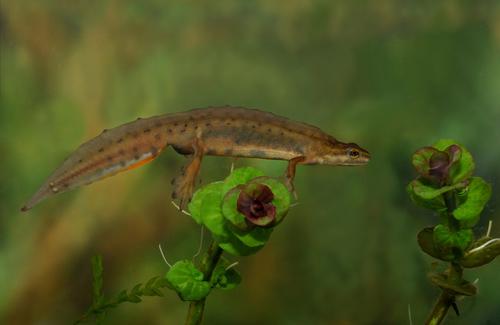
Fig. 1.Palmate x Smooth Newt hybrid. Picture ©John Robinson.
Worcestershire Record | 30 (April 2011) (ISSN 1 475-9616) page: 28 | Worcestershire Biological Records Centre & Worcestershire Recorders
New online Worcestershire moth recorder information including up to date list of species and recording advice
Tony Simpson
tonysimpson.1945@hotmail.co.uk
The last published information on the Worcestershire (VC37) moths was by Harper and Simpson in the Atlas of the Larger Moths and the two Atlases on the Smaller Moths of Herefordshire & Worcestershire published by the West Midlands Branch of Butterfly Conservation in 2000 to 2003.
There have been a lot of changes since then in the numbers and status of moths in VC37 both because of the spread of new species to our area, the increases and decreases in frequency of a lot of species possibly related to climate change, and because of an enormous increase in recorders and recording effort over the last ten years. There was obviously a need to bring county moth recording up to date.
Nigel Stone has been keeping the database for the whole of the West Midlands but has now asked the counties to take back the responsibility for the management of their own records, as the huge number of recent records has made his work load increasingly onerous. A big vote of thanks is due to him for his sterling work and help which has been much appreciated. He will continue to keep a back-up database whilst we run and manage the county list and records.
I remain the county recorder for Worcestershire (Victoria County 37) but Oliver Wadsworth has kindly agreed to be the IT manager for the county records. Jeff Rush produced an on line moth list including information on status and flight times and based on this Oliver and myself have produced an up to date county list and notes for VC37 moth recorders which can be obtained from Oliver at oliver.wadsworth@sky.com Danny Arnold has kindly agreed to hosting up to date copies of the “recorders package” and an online version of the county list at http://www.temevalleywildlife.com/galleries/WorcestershireMothWebsite.htm.
Species are listed separately under Smaller (Micro) and Larger (Macro) moth lists with Bradley number, English names for the Larger Moths, scientific names and their status, usual flight times, and for rare species their first and last records and some details of their sites in the county. The species have been put into the following categories: Common/Fairly Common and Widespread which are accepted without need for other details; Uncommon/Localised for which a photo or specimen may needed unless previously recorded from that site or area; species which need dissection to be certain of their identification and should otherwise be recorded as an aggregate; Rare/First County Record/presumed Extinct for which a specimen or photo where appropriate is needed. We will keep the list of species and changes in status up to date and this will be available on line in a readable only format. Further information is in the Notes for Recorders. For those who contribute to the Garden Moth Scheme it should be noted that we no longer automatically receive these records and therefore it is important to send us all your records as these will otherwise not get into the county moth data.
Records can be emailed to oliver.wadsworth@sky.com , or to me at tonysimpson.1945@hotmail.co.uk, or by post if wished to “A.N.B. Simpson,The Sycamores, Old Rectory Gardens, Leigh, WR6 5LD, Tel. 01886 832637.
Worcestershire Record | 30 (April 2011) (ISSN 1 475-9616) page: 28 | Worcestershire Biological Records Centre & Worcestershire Recorders
Worcestershire Record | 30 (April 2011) (ISSN 1 475-9616) page: 24-25 | Worcestershire Biological Records Centre & Worcestershire Recorders
Dotted beefly Bombylius discolor in southwest Worcestershire
Martin Skirrow
Hitherto there have been only three Worcestershire records for the Dotted Beefly Bombylius discolor, all around Bredon Hill: Kemerton in the south in 2004 and two near Beckford in the SE in early 2006 and 2007 (Worcestershire Record, No 21, Nov 2006; No 22, April 2007). At my home on a farm in Berrow, about 20 km west of Bredon (SO 778339) I was lucky to catch a B. discolor (photo) on 28th March 2011 where it was flying low and feeding on the flowers of Ground Ivy Glechoma hederacea. It was at about 16.00 h on a moderately warm afternoon with hazy sun. Harry Green, in his article in the Worcs Record No 21, cites Stubbs & Drake (2001) stating that a temperature of over 17oC is required to enable this species to fly. This might have been the temperature near the ground, but I doubt whether the general air temperature was as high as this (alas I have no firm readings).
The area in question, which borders a stream, had recently been cleared of rough growth and brambles, and a line of hazel trees had been coppiced. Numerous low plants are beginning to flower in the area, notably ground ivy, cowslips, and violets Viola reichenbachiana; V. odorata. The soil at the farm is a slightly acid heavy clay and most of its 55 acres consist of meadows, several of which are unimproved and species rich. The hosts of the parasitic larvae of B. discolor are mining bees that favour short turf and bare ground, mainly Andrena flavipes but also A. cineraria. I have found the latter here, but not the former, although I have not looked specifically for it.
(Postscript: Another Bombylius discolor nearby on 6th April in the afternoon feeding on hyacinth flowers)
Reference
Stubbs, A.E. & Drake, M. 2001. British soldier flies and their allies. British Entomological and Natural History Society, Reading.
Images
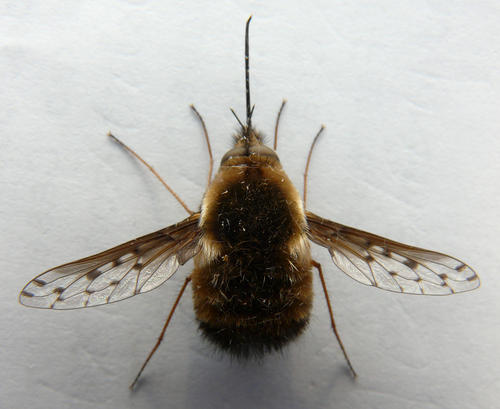
Fig. 1 Dotted beefly Bombylius discolor caught at Berrow. Picture ©Martin Skirrow.
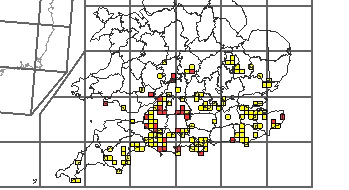
Fig. 2 Bombylius discolor distribution according to the NBN March 2011. Red are records 1990-2010, yellow indicates earlier records. Resolution is 10x10km squares with vice county boundaries and 100×100 km squares indicated.
Worcestershire Record | 30 (April 2011) (ISSN 1 475-9616) page: 46-51 | Worcestershire Biological Records Centre & Worcestershire Recorders
Notes on birds in the Severn and Avon Vales (the “Severn Hams”), Gloucestershire and south Worcestershire, January 2011–March 2011
Mike Smart [This is an edited version of Mike’s original report and deals only with birds usually associated with wetlands. Ed]
General introduction
The main sites are (from the north):
Along the Severn in Worcestershire, a series of well-watched gravel workings attract many water birds, notably waders; these are (from the north): Holt and Grimley (on the west bank just north of Worcester), Clifton (on the east bank just south of Kempsey); Ryall (on the east bank opposite Upton Ham); the new Ripple Pits (east bank) just south of the M50. Upton Warren Nature reserve, north of Droitwich, is outside the area covered by the present report, but is occasionally mentioned as it attracts many significant birds.
Powick Ham, just south of Worcester, the flood meadows where the Teme flows into the Severn.
Upton Ham (Worcs), the Upper Ham, a hay meadow south of the town, is an SSSI and is the best conserved of the riverside hams in botanical terms; south of the old railway embankment is the Lower Ham.
Longdon Marsh (where the Worcestershire Wildlife Trust has a major reserve south of Marsh Lane), a nearly enclosed basin north of the M50 motorway, flowing via the Longdon Brook to the Severn, just north of The Mythe and Mythe Hook, above Tewkesbury and just in Gloucestershire.
The Avon Meadows (on either side of the Avon, going north from Tewkesbury), along the border between Gloucestershire and Worcestershire, and including: the restored gravel pits at Bredon’s Hardwick (Worcs); Upham Meadow (sometimes called the “Great Hay Meadow”) and Summer Leasow at Twyning (Glos) which form an SSSI on ornithological grounds; Rectory Farm Meadows (Worcs), across the Avon from Upham Meadow and an SSSI on botanical grounds; Strensham Pits (Worcs), sludge pools below the waterworks at Strensham; further north along the Worcestershire Avon is the Gwen Finch Worcestershire Wildlife Trust Reserve near Nafford, an area of shallow lakes by the Avon; between Pershore and Fladbury is Lower Moor, and just to the north Throckmorton Landfill Site, which attracts large numbers of feeding gulls, (like Gloucester LS) and where the lagoons sometimes attract water birds. Just to the east of Bredon is Kemerton Lake (Worcs), a restored gravel pit in the valley of the Carrant Brook, which flows through Cowfield Marsh into the Avon just above Tewkesbury.
The “Severn Hams” between Tewkesbury and Gloucester, in which the main wetland areas are: Ashleworth and Hasfield Hams; Coombe Hill Canal and Meadows; , including Cobney Meadows at the western end (Coombe Hill Canal is a long disused and overgrown canal, which runs through the centre of Coombe Hill Meadows); and Cobney Meadows to the south of the canal, which adjoin the Leigh Meadows alongside the River Chelt and Leigh Brook above Wainlodes. Barrow Ponds are created by the artificial damming of a small tributary of the Chelt, east of the A 38. Ashleworth Ham and Coombe Hill are Gloucestershire Wildlife Trust reserves, and are particularly well-watched. This area also includes: the Severn Ham at Tewkesbury; the Severn between Lower Lode and Haw Bridge; and the Severn from Wainlodes, past Ashleworth Quay and Sandhurst, to Gloucester. The River Leadon flows into the Severn just above Gloucester, and its valley extends north past Newent; the newly created ponds at Blackwells End near Collier’s Brook, a tributary of the Leadon, have great potential. At Sandhurst, Maisemore and at Walham Pools near Gloucester there are a number of abandoned overgrown riverside brick-pits, artificial excavations in the floodplain.
Maisemore Ham is now largely converted to arable farming.
Sites on the edge of urban Gloucester, once flood meadows: Port Ham, Castlemeads and Over Ponds on Alney Island, Sudmeadow, and the Gloucester Landfill Site (GLS). Port Ham has recently been restored and some shallow scrapes dug; at the southern end of Port Ham is Lower Parting where the two arms of the Severn meet again; Sudmeadow is immediately south of Lower Parting; GLS attracts large numbers of gulls, and has a pond attractive to passage and some resident waterbirds; a little further south, near the Gloucester-Sharpness Canal, is the small Quedgeley Local Nature Reserve.
Minsterworth Ham, on the west bank of the Severn below Gloucester.
Walmore Common, on the west bank of the Severn below Gloucester; also the little marsh at Rodley (Wilmer Common), west of Walmore, along the stream west of Boxbush Farm.
Elmore Back, on the east bank of the Severn below Gloucester, opposite Walmore.
Most of these sites are marshes which flood when the level of the Severn is high (either because of water coming down from North Wales, or because of high tides downstream; or more often a combination of both), thus preventing local streams from reaching the Severn, so that they back flood. When there is a major Severn flood, with water coming over the flood-banks along the river (a “river flood”), there may be extensive floods over the whole floodplain area. The major Severn tributary, the Avon, does not have flood-banks in some places and so floods easily above Tewkesbury. The River Chelt holds running water, and is small enough to have muddy edges and mud banks.
Weather and flooding: general
The north of England and Scotland experienced cold wintry weather in the first ten days of January, followed in the middle of the month by a mild wet spell across the whole of UK; high pressure built again through the second half of the month, with the last week drier and colder. Southwest England reverted to a more normal Atlantic pattern at the beginning of the month, escaping the very cold weather. The Severn Vale was overcast and dull, with mainly south-westerly winds and high cloud for the first two weeks of the year; there were slight frosts in Gloucester at the beginning of the month and on 9 & 10 January. Some rain fell in the second week of January, when maximum temperatures were above 10°C on most days and Pershore recorded 14.5°C on 13 January, the highest temperature anywhere in UK in the month. Winds became much stronger on 15 January; the large anticyclone then produced sharp overnight frosts (-4° or -5°C in Gloucester) from 17-22 January; milder westerly air dominated from 23-25 January, with light rain on 25 January; anticyclonic conditions prevailed again with a cold easterly wind from 26 January, with frosts from 28 January, coldest on the night of 30/31 when the temperature dropped to -7°C in Gloucester. Nationally, precipitation was low, 88% of the thirty year average across England and Wales; total January rainfall in Gloucester was only 46 mm (against 48mm in both 2009 and 2010, the average being between 60 and 70mm).
Nationally, February was very mild, mainly because of the south-westerly winds which prevailed during the first half of the month, bringing quite heavy rain to western Britain; the second half of the month was however chillier. In the vales, winds remained steadily south-westerly from 1-7 February, quite strong with slight rain on 4 and 5 February, much milder than late January with no frost. On 8 February high pressure edged in from the continent, light easterly winds bringing a sharp frost with fog. From 9-14 February winds returned to the southwest, and the weather became damp and mild, sometimes sunny, sometimes showery, with temperatures reaching 13°C and 14 mm of rain on 13 February. From 15-22 February, winds were mainly light and south-easterly, but there was no frost and occasional showers. Milder as wind went southwest from 23-25 February, but cooler, with easterly winds and the occasional shower from 26-28 February; despite heavy rain elsewhere in Britain, rainfall in southwest England and south Wales was only 62% of the 30 year average. Total rainfall in Gloucester in February was only 35mm.
At UK level, Scotland had near-normal rainfall in March but the rest of the country was remarkably dry: England and Wales had the driest March since 1990, while rainfall in southwest England and south Wales was only 30% of the 30 year average. The south was generally mild in the second half of the month, though unsettled at the end. March in the Vales began as February had ended, with an anticyclone extending from continental Europe for the first week, bringing high grey cloud, with a cold north-easterly wind; no frost most days but quite sharp frost on 4 March, lighter frost on 5, 8 March. Winds went south-westerly on 7 March, remaining in that quarter until 13 March, with warmer temperatures and little or no rain. From 15-22 March, high pressure edged in from the continent, bringing high cloud and sunny periods by day, with frost on 18 & 19 March; bright, sunny and warm from 20-25 March, temperatures touching 15°. Wind went westerly from 25 March until the end of the month. March was unusually dry, with only a monthly total of only 5 mm in Gloucester, bringing the annual rainfall so far to only 86 mm.
In the first few days of the year, most wetlands in the vale remained very dry, with ditch levels very low, after the very dry conditions experienced in summer and autumn 2010. However, the Severn began to rise a little with the thaw of mid-December’s snow from upstream and local rainfall in the second week of January: it reached 8.23m at Haw Bridge on 2 January, still low for the season, but the highest since last spring; over the next two weeks the Severn continued to rise (to 9.25 m. on 13 January and 10.10m. on 15 January), which meant that local streams could not discharge; so they backed up, flooding meadows along the Chelt, at Coombe Hill and at Ashleworth for the first time this winter, a late date for a first flood. From about 18 January however, the Severn dropped again at Haw Bridge (from 9.38m. on 18 January, to 8.58m. on 22 January and 7.35 on 25 January, down to 7.05 by 5 February), so that water levels on the meadows dropped gradually. In the second week of February, the level of the Severn began to rise again (8.85 at Haw Bridge on 8 February, 9.62 on 10 February but down to 8.16 on 12 February) causing the winter’s second flood, as local streams backed up; but the flooding remained very light, and river and ditch levels dropped back to normal by the end of February. Severn levels remained low throughout March, with no flooding and water levels dropping gradually everywhere.
Conditions at the main sites
Ashleworth/Hasfield Hams: Little or no open water on the main pool on 1 January, but the meadows gradually became flooded, the main field of GWT reserve flooded for the first time this winter from 10 January; extensive flooding from the middle of the month, dropping from 22 January, when there was extensive ice cover; most surface water had gone by 29 January when the last two half boards were inserted (exceptionally late) in the sluice, so as to maintain open water on the reserve; levels on the reserve continued to drop but had stabilised by 5 February. They rose again from 8 February, with water pouring in over the sluice on 10 – 12 February, but dropped gradually by natural means through the second half of February and March; further drop by 23 March, when the top boards were removed.
Coombe Hill: Little water in scrapes and Long Pool early in the year, but water gradually rose after the first week of January, producing the unusual conditions of fresh, still unflooded grass in January, highly attractive to Wigeon; extensive shallow flooding from the middle of the month created excellent conditions for ducks, largely iced over round 22 January; water levels lower and no ice on 25 January, lower still but largely iced over on 29 January; the ice melted in the milder conditions in the first week of February. A second light flood, with the boardwalk to the Grundon Hide under water from 11-13 February and the scrapes disappearing under shallow flooding, but the water had all cleared by 19 February, levels continuing to drop throughout late February and March, with no surface flooding and water only in the scrapes and Long Pool.
Cobney/Leigh Meadows: Dry in the first few days of January, but the Chelt gradually rose, beginning to overtop its banks by 15 January; Cobney Meadows were extensively flooded on 18 January, Leigh Meadows less so; water, largely iced over, dropping on 22 January, lower with no ice on 25 January, gone by 29 January. The Chelt was high on 10 February but not breaking its banks; water pouring under the canal into Cobney Meadows from the Deerhurst Parish Drain, flooding still quite extensive on 13 February, but dropped again after a couple of days; no flooding in March.
Walmore Common: No flooding on 2 January, only a little water on the Common Pool, but some surface water by 7 January. Lightly flooded but mostly iced over on 19 January, flooding largely gone by 24 January, none left 27 January or 2 February; no increase in flooding 11-13 February despite higher river levels, and no more flooding in February or early March.
BIRD RECORDS
Swans
The Whoopers which generally winter in the Coombe Hill/Ashleworth area had not appeared in autumn 2010, no doubt because of the unusually dry conditions; but a family party of three which had appeared in late 2010 were in the Minsterworth area, feeding on a highly fertilised field (treated with chicken waste before seeding last autumn), for the first two weeks of this year; they appeared briefly at Walmore and were seen again at Minsterworth in February; a single Whooper was in the Ashleworth/ Coombe Hill area round 30 January. A group of 13 Bewick’s from 18 January were the first to appear in the Coombe Hill/Ashleworth area this winter; rather few were recorded at Walmore, where flooding only occurred for a short period in mid-January. From late January until early March a flock, including all four Whoopers, up to 48 Bewick’s and a few Mutes, took up residence by day on an oilseed rape field by the Severn at Upper Dumball, just south of Walmore, the Bewick’s returning at nightfall to roost at Slimbridge, while the Whoopers and Mutes flew the couple of hundred yards to roost on the river. The cold northeast winds in late February and early March appeared to delay the departure of the Bewick’s to Russia.
Mute Swan: At Mythe Hook, two pairs on 24 March. At Ashleworth, three on 8 January, five on 15 January, three on 29 January, two on 5 February, three on 10 February, a cygnet on 8 March; two territorial pairs on 13 March, one apparently preparing to nest on 22 March. At Coombe Hill, five on 8, 13 January, 12 on 15 January, seven on 18, 22, 25 (including 3JI) January, six on 5, 8 February, four on 12, 19 February, three on 2 March, two on 8 March, three on 15, 19 March, two pairs on 22 March. At Cobney/Leigh Meadows five on 15 January, 14 on 22 January, two on 25, 29 January. At Minsterworth, two with Whoopers on 1 January, three on 3 January, nine on 7 January, three on 8 January, four on 10 January, 22 on 11 January. At Walmore one on 2, 7 January, two on 16 January, nine (three cygnets) with other swans on 21 January, none 24 January, 2 February; two (a pair) on 10, 20 March; two on 27 March. At Upper Dumball, on the same field as the Bewick’s and Whoopers, three on 13 February, four on 25 February, two on 2 March, when both birds flew onto the nearby Severn to roost, not following the Bewick’s to Slimbridge; on 10 March, three.
Whooper Swan: At Minsterworth Ham, a family of two adults and a cygnet, feeding on a very bright green, fertilised field seen from 1 to 14 January had probably arrived about Christmas; what must have been the same family were feeding with Bewick’s and Mutes on a newly reseeded area of grass at Walmore on 21 January; back briefly at Minsterworth on 2 February. A single adult at Waterend near Longney (just across the river from Walmore and Minsterworth) with Bewick’s and Mutes on 3 & 8 January was apparently a separate bird; what was perhaps the same single bird was at Ashleworth on 30 January, roosting at Ashleworth on the evening of 3 February, also roosting at Coombe Hill on the morning of 5 February. The roosting area of these birds was unknown, but certainly not Slimbridge, and only the single occasionally appeared at Coombe Hill or Ashleworth. None in January or early February on the usual favourite fields on the Leigh Meadows.
On 11 February four birds (three adults and a cygnet), which must have been the family party of three and the singleton seen separately earlier in the winter, were found with Bewick’s in an oil-seed rape field at Upper Dumball near Rodley on the west bank of the Severn, about four miles as the swan flies from Slimbridge, in an area where such numbers of wild swans do not seem to have been recorded before; according to the farmer they had been present since about the beginning of the month. Still there on 13, 25 February, 2, 4, 6 March; on 25 February they appeared to go to roost on the nearby Severn at nightfall, on 2 March they definitely did so, departing before the Bewick’s and landing on the Severn, then being carried gradually downstream. On 8 March what must have been the same group of four were at Walmore (Colin Butters); they may well have been roosting on the Common Pool, since they were at Walmore on the evening of 9 March and the morning of 10 March, when they moved back to the rape field at Upper Dumball during the day; not recorded after 10 March (probably because no one looked) but four (three adults and a cygnet again) were at Walmore on the very late date of 27 March..
Bewick’s Swan: At Slimbridge the highest count of the year was of 319 on 2 January; numbers remained high there through January and well into February; with mainly adverse north-easterly winds, departures were late with 247 still present on 25 February; numbers decreased to 144 on 1 March and 89 departed on the night of 7 March in still conditions, leaving on 41 on 8 March; only five birds left on 10 March, all gone by 15 March. Studies of over seven thousand birds across north-west Europe suggest that the proportion of cygnets produced in summer 2010 was only 10.5%, higher than the five year average of 8.5%, but not enough to maintain population numbers.
The first of the winter at Coombe Hill were 13 (eight adults and five cygnets) on floodwater on 18 January, what must have been the same 13 birds were at Hasfield Ham on 22 January, and had apparently roosted on the spot; they were at Hasfield again on 23 January and flew off to the northeast. At Coombe Hill a party of two adults and one cygnet had roosted on 25, 29 January but flew off early on, apparently to graze north of Haw Bridge, but were not found later. At Ashleworth a family of five (two adults and three cygnets) on 30 January. A family of six (two adults and four cygnets) was at Minsterworth with the Whoopers on 1 January. At Waterend, four adults and three cygnets were with the Whooper on 3, 8 January. At Walmore none on 2, 7 January; six (five adults, no rings) on 21 January, none on 24, 27 January; a family of five (two adults and three cygnets – the birds from Ashleworth?) feeding on the reseeded patch at Walmore on 2 February departed towards Slimbridge; none on 11, 13 February. On 11 February, a group of 48 (37 adults and 11 cygnets) were seen with Whoopers and Mutes at Upper Dumball on the west bank of the Severn; still present on 13, 20, 24 and 25 February, when they were seen to depart just before nightfall (at 17h55) flying in the direction of Slimbridge, but not accompanied by the Whoopers or Mutes; 40 (11 cygnets) were still there on 2 March, staying after the Whoopers had left, and departing towards Slimbridge when it was almost dark at 18h14; still 40 there on 4 March, 38 on 6 March, only 14 left on 8 March, none on 10 March.
GEESE
The wintering flock, mainly of Canada and Greylag Geese, reached only moderate proportions in the dry conditions of late 2010, but numbers increased to about 800 when the floods rose in mid January, and a few wild Whitefronts, plus a Pinkfoot which had perhaps summered, joined them. As usual, they departed to their breeding grounds (Midlands for the Canadas, Forest of Dean and South Wales for the Greylags?) by early February. From mid February, only a few pairs were left, no doubt birds preparing to breed locally.
Greylag Goose: The wintering flock in the Coombe Hill area (which no doubt roved between Coombe Hill, Ashleworth and Tewkesbury) increased to about 200 birds late in January, with at least three different darvic ringed birds (all ringed as juveniles at Llanwern, Gwent in June 2007 or 2008) repeatedly seen, plus at least seven with metal rings; 35 on 1 January as the thaw advanced, 115 on 7 January; 140 on 8 January; 180 on 15 January, 170 on 18 January, 200 on 22 January, 180+ on 25 January, 119 on 29 January; sharp decrease in early February, only 30 on 12 February, a single pair on 2, 19, 22 March, two pairs on 26 March. At Ashleworth two on 5 February, only eight came in to roost (in pairs) on 8 February, only four on 12 February; a pair on 13 March. At Leigh/Cobney Meadows 22 on 12 February.
Bar-headed Goose: At Coombe Hill, one with Greylags on 7, 13, 14, 15, 25 January; no doubt the same bird at Ashleworth on 19 January.
Pink-footed Goose: At Coombe Hill, an adult with Greylags on 15, 18, 25 January (maybe the one that was seen last summer with them?).
White-fronted Goose: At Coombe Hill, an immature with the Greylags on 8 January seemed to be a wild individual, as it was clearly uneasy and was chased off by the Greylags; two adults flew in to join the Greylags on 18 January.
Canada Goose: On Upham Meadow (where local farmers report up to 200), 150 on 8 January; very possibly the Coombe Hill birds which are regularly seen flying off to the north towards Tewkesbury. At Mythe Hook, a pair mating on 24 March. At Deerhurst Walton a pair looking ready to breed on 26 February. At Ashleworth only five on 15 January, but 500 (no doubt including birds from Coombe Hill) had come to roost at dusk on 19 January; 25 on 5 February; 50 came in to roost on 8 February, only 14 on 12 February, ten on 8 March, 24 including a pair mating on 13 March. At Coombe Hill, 175 on 1 January after the thaw, highest number for some time; 230 on 8 January, 300 on 14 January, 390 on 15 January, 425 on 18 January, 400 on 22 January, 300+ on 25 January, decrease to only 25 on 5 February, 115 on 12 February, only 40 on 19 February, only ten, mainly paired, on 2 March; only two pairs on 8 March, but 65 on 13 March, ten on 15 March, including a pair accompanied by the white farmyard goose which was trying to break up the happy couple, still there on 19, 22 March; on 23 March a battle royal was observed between the white farmyard goose and the male Canada, which the Canada won conclusively, leaving the farmyard bird alone and forlorn on 26 March; two or three pairs on 26 March. At Leigh/Cobney Meadows three on 12 February. At Walmore 19 on 16 January.
Barnacle Goose: At Tirley Sandpits five on 5 March. At Ashleworth two on 19 March
Hybrid geese: A Barnacle x Greylag hybrid with the Canadas at Coombe Hill on 5, 12, 19 February, at Ashleworth at dusk on 8 February; at Ashleworth, then Leigh Meadows on 13 March.
Egyptian Goose: A pair displaying on the Southern Meadows at Coombe Hill on 16 February, pair still present on 19 February. Two (the same birds?) at Ashleworth on 13 March. A pair, undoubtedly the same birds, in moderate display at Coombe Hill on 22 March, present on 26 March.
DUCKS
Duck numbers at Ashleworth and Coombe Hill had been poor in late 2010 because of the low water levels. As soon as the meadows became flooded, numbers of ducks increased rapidly; 1300 Wigeon were at Coombe Hill by 8 January and numbers reached 2500 by 18 January, 3000 on 25 January; numbers of Teal reached the unusual high of 2000 by 22 January, when 200 Pintail were present, but decreased soon afterwards. The second light flood around 10 February did not attract numbers on this scale, and indeed by the end of February numbers had gone down quite spectacularly, so there was clearly an early departure.
Shelduck: At Ashleworth, two on 13 March. At Coombe Hill, two males on 8 January; two on 15 January; a pair and a singleton on 5 February, eight on 12 February, one on 19 February; nine on 2 March, lekking hard, some paired already, on 2 March, numbers large, with 16 paired and lekking on 8 March; nine with two established pairs on 15, 19 March, six on 22 March, two pairs on 26 March. At Walmore five on 16 January, three on 13 February, one on 10 March, four on 20 March. An escaped Paradise Shelduck hybrid at Coombe Hill on 27 January.
Surface-feeding ducks:
Wigeon: At Mythe Hook 45 on 24 March. At Ashleworth 40+ on 2, 7 January, 80 on 8 January, much larger number of 690 on more extensive flood on 15 January, 300 on 22 January, 210 on 27 January, 450 on 29 January, 1800+ on 30 January, 450 on 5 February, only about 200 on 10 February, decrease to 75 on 12 February, 110 on 2 March, 151 on 6 March, 200 on 8 March, 260 on 13 March, 130 on 22 March. At Coombe Hill, as the thaw progressed, 420 on 1 January, 600 on 7 January; on 8 January a group of 1300, walking out of the water to feed on the fresh grass surrounding the scrapes, 1226 on 15 January; sharp increase to 2500 on floodwater on 18, 22 January, 3000 on 25 January, down to 590 on 5 February, 372 on 12 February, 420 on 19 February; only 100 on 2 March, 40 on 8 March, four on 13 March, five on 15, 19 March, two on 22 March. At Leigh/Cobney Meadows 147 on shallow flood on 12 February. At Walmore 62 on 16 January.
Gadwall: At Ashleworth 10 on 7 January, 18 on 8 January, 12 on 15 January, two on 27 January, 17 on 29 January, 28 on 30 January, 20 on 5 February, 10 on 10 February, eight on 14 February, five on 8, 13 March. At Coombe Hill, seven on 8 January, four on 15 January, one on 18 January, 15 on 22 January, 10 on 25 January, seven on 29 January, one on 5 February, four on 12 February, five on 19 February, two on 8 March, seven on 13 March. At Walmore 11 on 16 January.
Teal: At Mythe Hook two on 24 March. At Ashleworth 40+ on 2 January, 150 on 3 January, 88 on 8 January, 300 on 15 January, 250 on 22 January, 178 on 27 January, 650 on 29 January (refugees from Coombe Hill?), 300+ on 30 January, 250 on 5 February, 100 on 10 February, 256 on 14 February, 150 on 8, 13 March, 80 on 22 March. At Coombe Hill 200 back after the thaw on 1, 7 January, 310 on 8 January, 139 on 15 January, 400 on 18 January; the unusual (indeed unprecedented) total of 2000 on 22 January, down to 500 on 25 January, only 100 in icy conditions on 29 January, most apparently moved to Ashleworth; only 95 on 5 February, 233 on 12 February, 150 on 19 February, 120 on 2 March, 40 on 8 March, 73 on 13 March, 35 on 15 March, 110 on 19 March, 115 on 22 March. At Leigh/Cobney Meadows eight on 12 February. At Castlemeads 20 flushed by cattle on 21 February. At Walmore 305 on 16 January, at least 25 on 19 January, 150 on 24 January, 100 on 2 February, only 27 on 13 February, 20 on 10 March, 28 on 13 March, 14 on 27 March.
Mallard: Many paired in ditches and streams round Tewkesbury and Staverton 22-24 February. At Ashleworth, 110 on 15 January, 60 on 22 January, 130 on 29 January, 50 on 5 February, 20 on 10 February, 31 on 14 February, 40 on 8 March, 25 on 13 March, 47 on 13 March. At Coombe Hill 50 on 8 January, 123 on 15 January, 100 on 22 January, 50 on 5, 79 on 12 February, ten on 19 February, 30 on 2 March, 40 on 8 March, 12 on 15 March, 20 on 19 March, 22 on 15 March. At Cobney/Leigh Meadows, 17 on 15 January, five on 22 January, 40 on 25 January, 60 on 29 January, nine on 12 February. At Walmore 125 on 16 January.
Pintail: First good showing on 15 January with higher floodwater. At Ashleworth six on 8 January, 80 on 15 January, 50 on 22 January, 80 on 23 January, 82 on 27 January, 68 on 29 January, 120+ on 30 January, 32 on 5 February, 10 on 10 February, seven on 13 February, 10 on 19 February, 14 on 2 March, 10 on 8 March, 15 on 13 March, eight on 19 March. At Coombe Hill five on 8 January, one on 13 January, 88 on 15 January, 76 on 18 January, 200 on 22 January, 250 on 25 January, only 30 left on 29 January, only three on 5 February, seven on 12 February, a single on 2 March, 12 on 6 March, two on 19 March. At Leigh/Cobney Meadows three on 12 February. At Walmore eight on 16 January.
Shoveler: At Ashleworth, seven on 15 January, ten on 22 January, six on 27 January, 11 on 29 January, seven on 30 January, three on 5 February, six on 10 February, 18 on 13 February, 30 on 2 March, 31 on 6 March, 20 on 8 March, 35 on 13 March, 25 on 19 March, eight on 22 March. At Coombe Hill five on 8 January, 18 on 15 January, 14 on 18 January, 10 on 22 January, none on 25, 29 January, 5 February, ten on 12 February, two on 19 February, eight on 8 March, 14 on 13 March, 17 on 15 March, ten on 19 March, eight on 22 March, two on 26 March. At Leigh/Cobney Meadows seven on 12 February. At Port Ham two on 3 January. At Walmore one on 16 January.
Diving ducks:
Pochard: At Coombe Hill one on 8 January.
Tufted Duck: At Mythe Hook, three on brook and three on brickpits on 24 March. On the Mill Avon at Tewkesbury, four on 28 January. At Tirley Court Lake, two males on 27 February. At Ashleworth, three on 15 January, 15 on 18 January, eight on 19 January, ten on 27 January, four on 29 January, two on 30 January, seven on 5 February, four on 10 February, eight on 13 February, four on 6, 8 March, two on 13 March, six on 17 March. At Coombe Hill four on 15 January, ten on 2 March, two on 4, 13 March, two on 15 March actually mating on Long Pool.
Goosander: Three (drake and two redheads) on Severn at Wainlodes on 22 January, a redhead on 5 February.
Red-breasted Merganser: A male of this infrequently recorded species appeared briefly on the scrapes at Coombe Hill on 15 February.
GREBES
Little Grebe: At Ashleworth, one on 15, 23 January, 12 February, 2, 8 March, three (with some whinnying) on 13 March, four on 17, 19 March. At Coombe Hill one on 15 January.
Great Crested Grebe: At Mythe Hook brickpits a pair on 24 March.
CORMORANTS
Cormorant: Along the Severn at Mythe Brook brickpits, one in full summer plumage on 24 March. Up to seven over the Severn, moving to and from Lower Lode pits on 28 January. At Coombe Hill, two landed by scrapes on 8 January, three in flight on 29 January, two on 5 February, five on 12 February. By the Severn Bore near Minsterworth, two perched on a dead tree on 10 March.
HERONS AND EGRETS
Bittern: A very tired bird on Port Ham on 2 January; one in flight over Alney Island (probably the same bird) on 3 January.
Little Egret: At Coombe Hill two on 22 March
Grey Heron: Numbers down in January and February, following cold weather in late 2010, at Ashleworth and Coombe Hill. At Mythe Hook three on 24 March. At Ashleworth, one on 15, 25 January, 5 February. At Coombe Hill one on 15 January, three in flight on 29 January, one on 8 March, two on 15 March, four on 22 March. At Cobney/Leigh Meadows one on 22 January. At Walmore three on 13 February.
The heronry at Staverton was occupied on 23 February, with nine nests apparently occupied, and at least ten birds in breeding plumage present.
RAILS AND CRAKES
Crane: One circled over Coombe Hill without landing just after midday on 26 March, before moving off high to the northeast.
Water Rail: Surprisingly few records.
Moorhen: At Ashleworth one on 13 March. At Coombe Hill, two on 12 February
Coot: At Mythe Hook brickpits, two on 24 March. On the Mill Avon at Tewkesbury, three on 28 January. At Tirley Court Lake, 12 on 14 January, eight on 27 February. At Ashleworth three on 5, 8 February, one on 12 February, nine on 2 March, 22 on 6 March, 20 on 8, 13 March. At Coombe Hill 27 on floodwater on 18 January, 5+ on 22, 25, 29 January, two on 12 February, ten on 2 March, 30 on 8 March, 11 on 13 March, ten on 15 March, five on 19 March, two on 22 March.
WADERS
Very few waders wintered in the Severn Hams, but some Lapwings appeared at the edge of the flood in late January, with the odd Dunlin and a single Black-tailed Godwit; there were no records of Ruff. Snipe were few and far between; most appeared to have moved out during the cold spell in November and December. The first of the resident Curlew returned to Coombe Hill as early as January, and there were distinct signs of northward passage from early February, with Golden Plover, Lapwing, Curlew and Dunlin moving through.
Oystercatcher: At Coombe Hill a single, the first of the year, on 26 February; two on 12, 13 March, two (clearly paired) on 15, 19, 22, 26 March.
Little Ringed Plover: At Coombe Hill a very early bird on 12 March (earliest date for Gloucestershire 10 March in 2006); one, not yet in full summer plumage, on 22 March; one flew straight over, calling, on 26 March.
Ringed Plover: At Coombe Hill one on 17 March.
Golden Plover: Five flew west over Llanthony (Gloucester) on 4 January. At Coombe Hill signs of northward passage from mid-February: five on 16 February, when 75 flew over; three in winter plumage with Lapwings on 19 February, 28 on 18 March. Near Walmore 15 flew north on 26 February. Several small parties noted in March, no doubt migrants moving north; some at Coombe Hill; party of 16 (one in summer plumage) at Mythe Hook on 24 March, being harried by displaying resident Lapwing.
Lapwing: At Mythe Hook, four pairs displaying well on 24 March. At Staunton no sign of breeding birds on 20 March. At Tirley 35 on 29 January, 55 on 31 January, 68 on 1 February, 90 on 5 February. At Ashleworth, four on 15 January, 90 on 5 February; a single on reserve on 13 March not looking very territorial; four on 17 March; three displaying between the reserve and arable at Colways on 22 March. Over Deerhurst on 29 January, 48 flying east. At Coombe Hill 190 on 8 January, 11 on 13 January, 287 on 15 January, 460 on 18 January, 300 on 22 January, 336 on 25 January, 80 on 29 January, 50 on 5 February, 100 on 12 February, 155 on 16 February; 120 on 19 February were very frisky and active like passing migrants; 28 on 2 March preening and moulting; four early in the morning of 8 March, in breeding plumage with red legs, flew off to the north early on; three on 13 March; 20 on 15 March including two displaying pairs; 12 displaying well round scrapes on 19, 22 March. On nearby arable at the Leigh two pairs displaying on 15 March. At Leigh Meadows, 32 on 15 January. At Walmore five on 13 February; six, displaying strongly, on 10 March; seems early for breeding birds; 17 (at least one territorial pair) on 13 March, 20 (but only four of them displaying) on 20 March, 12 on 27 March, four of them chasing crows.
Dunlin: At Coombe Hill seven on 15 January, three on 18 January, one on 26 January; seven on 14 February, two on 19 February, five on 23 February, one on 26 February, three on 2 March.
Little Stint: At Coombe Hill one on 16 February
Ruff: At Coombe Hill one on 24, 26 March.
Jack Snipe: As for Snipe, few records. At Clearwater Drive, Quedgeley, one on 1 January. At Netheridge Farm Hempsted one on 25 January, 4 March. At Walmore, one on 13 February, 13 March.
Snipe: Very few records in January in places where they are usually numerous; it would appear that most moved out of the area in the coldspell in December. On the Severn Ham, Tewkesbury, seven flushed on 28 January. At Ashleworth none on 13 January on a setaside field which most winters is a favoured site, none on 15 January; two in flight on 16 January; 15 at dusk on 3 February and 13 (a modest total) by day on 5 February in conditions which looked ideal, suggesting that some had returned; 15 at dusk on 8 February, but none found by day on 10 February, only one on 12 February; however 33 flushed from preferred area on 8 March, 28 on 13 March. At Coombe Hill a single on 8 January, none on 13, 15 January, nine on 22 January, none 25 January, 5 February, three on 13, 15 March, six on 22 March, 70 at dusk on 27 March. At Leigh Meadows, one on 24 January. At Netheridge Farm one on 11 February, seven on 4 March. At Walmore five on 16 January, seven on 24 January, six on 27 January, only one on 2 February, seven on 13 February, nine on 10 March, 14 on 13 March, four on 27 March.
Woodcock: At Maisemore Ham, two flushed on 24 February.
Black-tailed Godwit: At Coombe Hill one with Lapwings on floodwater on 25 January.
Curlew: At Mythe Hook, one bubbling on 24 March. At Ashleworth, two bubbling, one at north end of reserve, one behind field 23, on 13 March, three on 17 March. At Coombe Hill a very early bird on 15 January, two on 18, 25, 29 January, one of them bubbling on latter dates; from 12 February, small flocks, no doubt of northward migrants: eight (apparently a territorial pair and six migrants) on 12 February, 16 on 14 February, 17 on 16 February, 11 (pair plus nine migrants) on 19 February, seven on 23 February, five on 26 February; five in early morning of 2 March appeared to be partly migrants, partly residents. More migrants in early March: 31 on 5 March took off to north early in the morning; 26 in evening of 7 March, 29 on morning of 8 March had obviously roosted, but left early on to the north, calling and with excited whiffling flight; 33 on 12 March; nine on 13 March eleven on 15 March, about three flying off to north, others apparently local breeders; six on 19 March were local birds; on 22 March eight local birds early in the morning were joined at midday by ten more, one of which had colour-rings and had been ringed on the Severn estuary on 26 September last, first thought to be an indication of passage from the estuary upstream, but since the bird was seen again on 23 March at Coombe Hill and on 25 March at Ashleworth, it appears more likely to be a local breeder; by the evening of 22 March 28 were present, only four on 26 March. At Cobney Meadows, one calling on 22 January. At Maisemore Ham one flew north on 24 February. At Walmore three, apparently migrants, circling on 10 March; one perhaps two on 13 March, five on field D on 20 March but none on 27 March. At Upper Dumball ten on riverside fields on 10 March
Redshank: At Ashleworth one on 19 March. At Coombe Hill, one on 28 February, one beginning to show signs of summer plumage, on 2 March, one on 19, 22 March, two on 26 March with breeding trill.
Green Sandpiper: At Clearwater Drive (Quedgeley) one on 23 January. At Netheridge Farm Hempsted one on 24 January, 11, 16 February, 4 March.
Common Sandpiper: At Ashleworth one on 27 March.
GULLS AND TERNS
Mediterranean Gull: At Hartpury an adult with other gulls in fields on 28 February.
Black-headed Gull: At Ashleworth ten on ice on 22 January, 60 on floodwater on 12 February. At Coombe Hill 120 on floodwater on 25 January, 73 on floodwater on 12 February. At Cobney/Leigh Meadows two on ice on 22 January. At Walmore 150 on 10 March.
Common Gull: At Ashleworth 15 on floodwater on 12 February. At Walmore 20 on 10 March.
Lesser Black-backed Gull: At Cobney/Leigh Meadows 40 on ice on 22 January.
Herring Gull: At Cobney/Leigh Meadows 20 on ice on 22 January.
Glaucous Gull: At Coombe Hill a first winter bird appeared on the floodwater for a short time on the afternoon of 11 February, with other large gulls returning to roost on the estuary.
PASSERINES
Lapland Bunting: A single of this species, very scarce in Gloucestershire was heard flying north over Ashleworth on the evening of 31 March.
These are unconfirmed records, compiled by M. Smart from his own observations and those of David Anderson, Gordon Avery, Les Brown, Colin Butters, Mervyn Greening, Andy Jayne, Julia Newth and Lawrence Skipp, with some cherries picked from the Gloster Birder and Worcester Birding websites.
Worcestershire Record | 30 (April 2011) (ISSN 1 475-9616) page: 43-46 | Worcestershire Biological Records Centre & Worcestershire Recorders
Worcestershire Record | 30 (April 2011) (ISSN 1 475-9616) page: 43-46 | Worcestershire Biological Records Centre & Worcestershire Recorders
Notes on birds in the Severn and Avon Vales (the “Severn Hams”), Gloucestershire and south Worcestershire, October–December 2010
Mike Smart. [This is an edited version of Mike’s original report and deals only with birds usually associated with wetlands. Ed]
General introduction
The main sites are (from the north):
Along the Severn in Worcestershire, a series of well-watched gravel workings attract many water birds, notably waders; these are (from the north): Holt and Grimley (on the west bank just north of Worcester), Clifton (on the east bank just south of Kempsey); Ryall (on the east bank opposite Upton Ham); the new Ripple Pits (east bank) just south of the M50. Upton Warren Nature reserve, north of Droitwich, is outside the area covered by the present report, but is occasionally mentioned as it attracts many significant birds.
Powick Ham, just south of Worcester, the flood meadows where the Teme flows into the Severn.
Upton Ham (Worcs), the Upper Ham, a hay meadow south of the town, is an SSSI and is the best conserved of the riverside hams in botanical terms; south of the old railway embankment is the Lower Ham.
Longdon Marsh (where the Worcestershire Wildlife Trust has a major reserve south of Marsh Lane), a nearly enclosed basin north of the M50 motorway, flowing via the Longdon Brook to the Severn, just north of The Mythe and Mythe Hook, above Tewkesbury and just in Gloucestershire.
The Avon Meadows (on either side of the Avon, going north from Tewkesbury), along the border between Gloucestershire and Worcestershire, and including: the restored gravel pits at Bredon’s Hardwick (Worcs); Upham Meadow (sometimes called the “Great Hay Meadow”) and Summer Leasow at Twyning (Glos) which form an SSSI on ornithological grounds; Rectory Farm Meadows (Worcs), across the Avon from Upham Meadow and an SSSI on botanical grounds; Strensham Pits (Worcs), sludge pools below the waterworks at Strensham; further north along the Worcestershire Avon is the Gwen Finch Worcestershire Wildlife Trust Reserve near Nafford, an area of shallow lakes by the Avon; between Pershore and Fladbury is Lower Moor, and just to the north Throckmorton Landfill Site, which attracts large numbers of feeding gulls, (like Gloucester LS) and where the lagoons sometimes attract water birds. Just to the east of Bredon is Kemerton Lake (Worcs), a restored gravel pit in the valley of the Carrant Brook, which flows through Cowfield Marsh into the Avon just above Tewkesbury.
The “Severn Hams” between Tewkesbury and Gloucester, in which the main wetland areas are: Ashleworth and Hasfield Hams; Coombe Hill Canal and Meadows, including Cobney Meadows at the western end (Coombe Hill Canal is a long disused and overgrown canal, which runs through the centre of Coombe Hill Meadows); and the Leigh Meadows alongside the River Chelt and Leigh Brook above Wainlodes. Barrow Ponds are created by the artificial damming of a small tributary of the Chelt, east of the A 38. Ashleworth Ham and Coombe Hill are Gloucestershire Wildlife Trust reserves, and are particularly well-watched. This area also includes: the Severn Ham at Tewkesbury; the Severn between Lower Lode and Haw Bridge; and the Severn from Wainlodes, past Ashleworth Quay and Sandhurst, to Gloucester. The River Leadon flows into the Severn just above Gloucester, and its valley extends north past Newent; the newly created ponds at Blackwells End near Collier’s Brook, a tributary of the Leadon, have great potential. At Sandhurst, Maisemore and at Walham Pools near Gloucester there are a number of abandoned overgrown riverside brick-pits, artificial excavations in the floodplain. Maisemore Ham is now largely converted to arable farming.
Sites on the edge of urban Gloucester, once flood meadows: Port Ham, Castlemeads and Over Ponds on Alney Island, Sudmeadow, and the Gloucester Landfill Site (GLS). Port Ham has recently been restored and some shallow scrapes dug; at the southern end of Port Ham is Lower Parting where the two arms of the Severn meet again; Sudmeadow is immediately south of Lower Parting; GLS attracts large numbers of gulls, and has a pond attractive to passage and some resident waterbirds; a little further south, near the Gloucester-Sharpness Canal, is the small Quedgeley Local Nature Reserve.
Minsterworth Ham, on the west bank of the Severn below Gloucester.
Walmore Common, on the west bank of the Severn below Gloucester; also the little marsh at Rodley (Wilmer Common), west of Walmore, along the stream west of Boxbush Farm.
Elmore Back, on the east bank of the Severn below Gloucester, opposite Walmore.
Most of these sites are marshes which flood when the level of the Severn is high (either because of water coming down from North Wales, or because of high tides downstream; or more often a combination of both), thus preventing local streams from reaching the Severn, so that they back flood. When there is a major Severn flood, with water coming over the flood-banks along the river (a “river flood”), there may be extensive floods over the whole floodplain area. The major Severn tributary, the Avon, does not have flood-banks in some places and so floods easily above Tewkesbury. The River Chelt holds running water, and is small enough to have muddy edges and mud banks.
Weather and flooding: general
Nationally, October’s weather was marked by episodic spells, mild and wet periods alternating with a dry and cold period; overall temperatures were close to the average and rainfall was near normal. Locally, the month began with the heaviest rain since August (28mm in the first three days of October in Gloucester after 22mm for the whole of September). For the next ten days, with the Azores anticyclone extending north into the Atlantic, an area of high pressure prevented Atlantic fronts from reaching Britain; winds went dry and easterly, low cloud giving way to bright sunny autumnal days and almost an Indian summer from 10-13 October with temperatures over 20° by day but below 10° by night. It was colder in the next week, with frosts on three nights round 20 October and 25 October; westerly winds then reasserted themselves for a few days before returning to the east at the end of the month. For south west England and south Wales, as for the Midlands, rainfall was at 75% of the average over the last thirty years, but total rainfall in Gloucester was only 39mm.
Early November contrasted sharply, over the country as a whole, with the frigid conditions that were to come: south-westerly winds brought warmth during the first few days, but the south and west had heavy rain with flooding in Cornwall in the middle of the month. The second and third weeks were unsettled and often chilly, presaging an extraordinarily cold and wintry end to the month with heavy snow in eastern Scotland and northeast England; near Brecon, a new record low for Wales of -18°C was recorded on the night of 27/28 November. Rainfall was generally near average. Locally, there were westerly winds with some drizzle for the first three days of November; it was wet in the second week of the month, with 14 mm of rain in Gloucester on 8 November; from the middle of the month, winds were predominantly easterly with colder anticyclonic conditions; light frosts were experienced in Gloucester on 10, 14-16 and 23-24 November; cold, but with little or no snow, from 26 November to the end of the month. Total rainfall in Gloucester was only 40 mm.
At national level December 2010 was the coldest December since 1890, and the coldest calendar month since February 1986; it was exceptionally cold for the first nine days and again from 16 to 27 December; there were disruptive snow falls on the first two days of the month on 6 and on 17/18 December; despite the snow, precipitation, averaging across England and Wales, was only 39% of the December average, the lowest since 1971. The freezing weather was caused by cold air from the north, known as a “block pattern”. UK weather is usually dominated by the jet stream, a strong wind that blows from west to east, about five miles above the Earth’s surface, bringing damp, mild weather off the Atlantic. In winter, the ocean is warmer than the land, but when the jet stream is blocked by high pressure, as this month, it dips southward and lets chilled air flood in from the north. Where the mild, damp Atlantic weather systems hit the cold front, snow falls and the UK has been at the centre of this process.
In the Severn Vale cold conditions continued until 9 December, when a thaw set in for a few days; but from mid-December heavy snowfalls remained on the ground in very cold conditions. Until 27 December, with winds mainly in the east and south, there were only four December nights in Gloucester without frost, and the temperature did not rise above zero at all from 18 to 26 December, with minima of -11°C in Gloucester on 20 and 26 December. The coldest place in UK on 20 December was Pershore with -18.7°C. Another thaw set in on 27 December. In Gloucester, the total December rainfall was only 13 mm, bringing the annual total to only 433 mm.
As a whole 2010 was the coldest year since 1986 and the tenth coldest in the past century; it was also drier and sunnier than average; drought conditions were declared in some places during June, but the wet July soon resolved this issue.
Water levels everywhere were very low at the beginning of October, following the dry summer, but rose very slightly for a couple of days as water backed up from the Severn under the influence of high tides from 7-9 October, but dropped back again very slightly, leaving little or no open water in the fields, except in permanent waters like the Long Pool at Coombe Hill or the pools at Ashleworth.
Conditions at the main sites
Ashleworth/Hasfield Hams: Very dry in October, the only water being in the pools on the reserve, but water flowed back into the reserve from the Severn for a couple of days round 7 October under the influence of high equinoctial tides. Water levels remained low for most of November, and the first three boards were not inserted into the sluice until 20 November; this normally retains water on the reserve in winter, but there was so little water that the main fields remained unflooded.
Coombe Hill: The scrapes were dry throughout October, the only open water being on the Long Pool; slight inflow into the Long Pool from the Severn via the Parish Drain on 7 October because of high tides, but no more inflow on 12 October; conditions remained the same for the rest of October. In November a little water collected in the bottom of the scrapes, but they were far from full, and this situation was maintained through December when what little water there was froze over.
Leigh Meadows: Normal conditions with no flooding or surface water at all.
Walmore Common: No flooding throughout the period. All ditches and the little open water on the Common Pool was completely iced over in December.
Bird records
Things rather quiet throughout the period: in October and November because water levels were low everywhere and few water birds were in evidence; water levels were no higher in late November and December, and with the cold conditions in late November and for most of December any surface water froze over.
SWANS
Mute Swan: At Deerhurst, three grazing by Severn on 30 October. At Coombe Hill the only ones evident all summer had been the pair that nested on the canal but lost their young, still present on 23 November, but the colour ringed male (3AY) had moved to the Severn at Lower Lode on 28 December; eight at Coombe Hill on 7 October as the wintering flock began to build, feeding on grass on the southern meadows; but the flock did not develop, with only four in October, eight in late November, only a family party of four on 9 December. At Walmore one on 31 December.
Whooper Swan: Two (one with darvic L6L, ringed at Welney in 2007) roosted at Slimbridge from 14 October, but their daytime feeding area remained a mystery; one departed after 16 October, the other stayed until 25 October. One with Mute Swans around Preston Cross on 14 & 16 December was seen to fly, so could not have been the domesticated bird with clipped wings from nearby Saycells Farm. None recorded at the usual wintering area round Ashleworth and Coombe Hill, no doubt because of the unusually dry conditions and lack of open water for roosts. The family party of two adults and a cygnet recorded at Minsterworth Ham from 1 January 2011 probably arrived around Christmas at the height of the mid-December cold spell.
Bewick’s Swan: The first eight birds arrived at Slimbridge on 18 October; following snowfalls in early December the total rose to 120; by 10 December, 261 were present, the highest number at this time since 1991; the highest count in December was of 318 on 21 December. These swans stayed in the Slimbridge area, with few records in the (very dry) wetlands of the Severn Vale: the only record at Walmore was of a family party of six (two adults and four cygnets) on 17 December.
GEESE
Greylag Goose: Worcestershire: a flock of at least a hundred round Lower Moor throughout October.
Gloucestershire: A group of about 40 was in the Coombe Hill area in October, sometimes roosting at Coombe Hill, sometimes apparently at Barrow Ponds, and moving between these two points; numbers increased in November, and birds were often seen flying off towards Tewkesbury. At Coombe Hill, four flew out on 7 October, 13 on 10 October; 41 appeared to have roosted on 12 October before moving off early towards Barrow Ponds; 25 appeared to have roosted on 15 October, flying out early again towards Barrow Ponds, 25 roosting on 30 October left early for Barrow Ponds. 94 on 6 November, 144 on 13 November, 65 on 20 November including one colour-ringed B6P (originally ringed at Llanwern in Gwent in 2007), 54 on 23 November which flew in from the direction of Barrow Ponds; five flew over on 19 December. At Haw Bridge 18 flew downriver on 19 December.
Bar-headed Goose: At Coombe Hill, an adult with Greylags on 20 November.
Canada Goose: The usual wintering flock was slow to build up, no doubt because of the dry conditions. Like the Greylags, the Canadas moved between Barrow Ponds, Coombe Hill and a grazing site in the Deerhurst/Tewkesbury area. At Coombe Hill, only one on 7 October, 66 on 10 October, 80 on 12 October arrived from direction of Barrow Ponds and flew on towards Tewkesbury, returning an hour later; on 15 October 150 were grazing, then flew off to north; about 50 went downriver early on from Barrow Ponds on 22 October and another group of the same size flew from Deerhurst to Barrow mid-morning; 50 flying round on 30 October; 85 on 13 November, 237 on 20 November.
DUCKS
With the Long Pool at Coombe Hill the only area with open surface water in October and most of November, numbers of ducks were low, though the Teal flock clearly enjoyed the secluded conditions with plenty of food and built up gradually, joined by a few Wigeon. However, they all practically disappeared with the cold and icy conditions in December, most probably going to the estuary, though a few Wigeon and Mallard remained on the unfrozen waters of the Severn.
Shelduck: At Coombe Hill three on 16 November.
Surface-feeding ducks:
Wigeon: At Ashleworth, two on 10 October, 52 on 13 November; six flew upriver on 11 December. At Coombe Hill six on 7 October, two on 10 October, eight on 12 October, six on 15 October, ten on 30 October; seven on 6 November, but 180 on 13 November, 160 on 20 November, 120 on 23 November. In icy conditions, 120 on the Severn above Haw Bridge on 9 December, with 80 there on 19 December; three at the confluence of the Mill Avon with the Severn near Tewkesbury, and about 120 on the Severn between Forthampton and Deerhurst on 28 December. At Walmore, one on 15 November, a female on 31 December.
Gadwall: At Coombe Hill, two on 13 November. Some on the Severn during the freeze-up: four above Haw Bridge on 19 December, five between Forthampton and Chaceley on 28 December. At Walmore a male on 31 December.
Teal: At Ashleworth, four on 10 October, 22 on 13 November. At Coombe Hill, the flock in the Long Pool increased gradually during October: 100 on 3 October, 195 on 12 October, 280 on 22 October; 206 on 6 November, 300 on 13 November. Small numbers on the Severn during the cold spell: on the Severn below Forthampton eight on 28 December. At Walmore six on 15 November, five on 31 December.
Mallard: At Bredon’s Hardwick, ten on 1 November.
At Ashleworth 85 on 10 October, 58 on 13 November. At Coombe Hill 120 on 3 October, 85 on 10 October, 15 on 30 October; 39 on 6 November, 230 on 9 November and 300 (high counts) on 13 November, 63 on 20 November, only 13 on the ice on 9 December, eight on 19 December. In icy conditions 25 on 19 December on the Severn above Haw Bridge, 50 on 28 December at the confluence of the Mill Avon and the Severn in Tewkesbury, and 200 on the Severn below Forthampton.
Pintail: Very few records indeed in the dry autumn: at Ashleworth five on 13 November.
Shoveler: Few records again. At Ashleworth two on 13 November. At Coombe Hill up to nine on many dates in October, 16 on 13 November.
DIVING DUCKS:
Pochard: On 28 December, two on the Severn at Forthampton.
Tufted Duck: On 28 December, with Lower Lode brick-pits frozen over, 11 at the confluence of the Mill Avon and Severn.
Red-crested Pochard: At Tewkesbury a female on the Mill Avon on 27 December.
Goldeneye: On the Severn below Forthampton, five females or immatures among ice floes on 28 December. A species not often recorded on the river; birds that had moved south from the Midlands, or refugees from a frozen Cotswold Water Park?
Goosander: Several records along the Severn in the cold spell, perhaps different birds from the same group? One on the Severn at Wainlodes on 8 December following the first cold period. Four (a drake and three redheads) on the Severn at Tewkesbury on 10 December; a female on the Severn near the Mythe above Tewkesbury on 22 December; five females on the Mill Avon on 27 December, a male on the Severn at Lower Lode on 31 December. An unusually large flock of 12 flew north over Ashleworth on 11 December.
GREBES
Little Grebe: At Coombe Hill, one with juvenile head-markings on the Long Pool on many dates in October (two on 16 October), the juvenile still there on 23 November.
Great Crested Grebe: At Bredon’s Hardwick four on 1 November.
CORMORANTS
Cormorant: As usual, many records of birds moving up and down the river between feeding and loafing sites. At Bredon’s Hardwick 29 on 1 November.
At Lower Lode, 32 loafing on 18 November. Seven in trees along Severn above Haw Bridge, with more fishing in the river on 19 December; one or two fishing below Forthampton on 28 December. At Ashleworth, one flew downriver on 10 October. At Coombe Hill, one flying south on 3 October, seven south on 23 November; one landed on the Long Pool on 20 November; three flew over on 9 December. An old oak by the River Chelt near Wainlodes being used as loafing site – two there on 11 December, four on 19 & 29 December. At Maisemore Weir 17 sitting in trees and fishing in river on 19 December. At Port Ham, five flew downriver on 24 November.
HERONS AND EGRETS
Little Egret: Though frequent in summer, there are fewer winter records; the only records were of one in flight over Walmore on 15 November, three flying NE over Quedgeley on 30 November and four feeding on brooks round Longford on 12 December.
Grey Heron: Rather few records, probably because of the dry conditions in the early autumn; this species is known to be sensitive to cold weather, so may have moved out in December. At Bredon’s Hardwick two on 1 November. At Coombe Hill, one to two in October, one on 13 November, one on 9 December; one on the ice on 19 December. At Leigh Meadows, two on 12 October, two on 29 December. At Walmore one on 15 November.
RAILS AND CRAKES
Water Rail: One at Severn Ham, Tewkesbury on 11 December. One at Port Ham on 15 October. One at Dimore Brook Quedgeley on 27 November.
Moorhen: At Coombe Hill, 10+ from 12 October and in icy conditions on 9 December; four round a hole in the ice on 19 December.
Coot: With the brick-pits frozen over, five by the Severn at Lower Lode on 28 December.
WADERS
Golden Plover: Worcestershire: At Lower Moor 50 in flight on 1 November. At Tirley 31 on 27 November.
Lapwing: At Bredon’s Hardwick two on 1 November. Few records in Gloucestershire in the dry conditions. At Tirley, 60+ flying north on 23 November, 16 on 27 November; 23 on pasture on 3 December, 71 on 5 December. At Ashleworth, a flock of thirty flew downriver on 30 October, another flock of 30 in flight on 4 December, and a flock of 12 on 27 December. At Coombe Hill, just one on 6 November, nine on 20 November. At Alney Island 18 heading north on 5 December.
Dunlin: At Bredon’s Hardwick one on 1 November.
Jack Snipe: the only record was at Coombe Hill: two in Long Pool on 6 November.
Snipe: Much smaller numbers than usual in October and November, no doubt because of the dry conditions; and remarkably few in December, when any birds about probably fled from the icy conditions. Worcestershire: 40 at Ryden Farm along the Avon near Charlton on 19 November. Gloucestershire: At Severn Ham Tewkesbury two on 21 November. At Ashleworth, two on 25 October. At Coombe Hill, one on 3 October, three on 7 October, six on 12 October, one on 22 October, five on 30 October; four on 6 November, five on 23 November, two on 27 December after the thaw set in. At Leigh Meadows, two after first slight thaw on 11 December. At Walmore four on 6 October, six on 15 November.
Woodcock: Rarely found in the Vale: one in the osiers at Sudmeadow on 2 December.
Curlew: One in flight south of Tewkesbury on 9 December, another going west over Tewkesbury Abbey on 23 December; unusual dates for this species, perhaps cold weather migrants?
Redshank: None recorded, as usual at this time of year.
Green Sandpiper: As usual, small numbers found wintering in the vales: at Coombe Hill two on 6 October, one on 15 October and 3 & 6 November. At Sudmeadow, one present throughout October. At Clearwater Drive Quedgeley, one on 28 November.
GULLS
Many gulls pass over the area, in the morning en route from roosts on the estuary to feeding sites, notably landfill sites at Gloucester, Bishops Cleeve and Throckmorton, on the way back in the evening. The following records are only a small selection of those which land in the fields or floodwater of the vale.
Black-headed Gull: At Bredon’s Hardwick 20 on 1 November. At Deerhurst 200 on field by Severn treated with slurry on 30 October.
Common Gull: At Bredon’s Hardwick two on 1 November. At Deerhurst on 30 October, ten with Black-headed Gulls.
Lesser Black-backed Gull: At Bredon’s Hardwick one or two on 1 November. At Deerhurst on 30 October, twenty with Black-headed Gulls.
Herring Gull: At Deerhurst on 30 October, five with Black-headed Gulls.
These are unconfirmed records, compiled by M. Smart from his own observations and those of David Anderson, Gordon Avery, Les Brown, Colin Butters, Tim Cash, Mervyn Greening, Andy Jayne, Julia Newth, John Rankin and Lawrence Skipp, with some cherries picked from the Gloster Birder website.
Worcestershire Record | 30 (April 2011) (ISSN 1 475-9616) page: 46-51 | Worcestershire Biological Records Centre & Worcestershire Recorders
Worcestershire Record | 30 (April 2011) (ISSN 1 475-9616) page: 34-35 | Worcestershire Biological Records Centre & Worcestershire Recorders
Fungus forays at Monkwood Nature Reserve, near Hallow, Worcestershire
Justin Smith
justinhongos@yahoo.co.uk
Worcestershire Naturalists’ Society (WNS) organised fungus forays at Monk Woods Nature Reserve in October 2010, and earlier in the decade, in October 2004. The site is a well known butterfly reserve, but has been well known to the WNS as both a botanically-rich and mycologically-rich site; certainly Carleton Rea recorded there regularly over 100 years ago. Rea recorded common species such as Lactarius pyrogalus, Russula nigricans and Amanita citrina and also unusual species such as Cortinarius acutus and Asterophora parasitica (on Russula nigricans) which all turned up on the 2010 foray. Incidentally, Rea regarded Asterophora parasitica (asNyctalis parasitica) as common, though it is now a species that has to be searched for even if the host is common.
The 2010 foray turned up 110 species, an excellent figure for a public even. I remember leading forays in the early-mid 1980s, and this figure was the norm for many ‘good’ sites; the average for a diverse site is now normally 50-80 species, depending on time forayed, number of attendees etc. Much of the species richness for a site can be attributed to prevailing weather conditions during the main fungus fruiting season; September-November; if it is wet and warm enough, it will be a ‘good’ season; in fact, over the last 15 years, no fungus season has been the same. Most have been too dry, but some years have been damp and warm; those years have been excellent fungus recording years; 1997, 2004 and 2010 were the most memorable. Incidentally, the previous Monk Woods foray in 2004, in one of the ‘good’ years, produced 112 species over roughly the same time and area as the 2010 foray.
Monk Woods itself is botanically diverse site, dominated by oaks, hazel, ash, birch and in places by beech, willow or alder; there is a well developed under-storey dominated by hazel, with some patchy blackthorn, all on a relatively level site, divided by ditches, on clayey soils, which vary in acidity throughout the wood. The diversity of tree and shrub species in turn produce a diverse mycota of both saprotrophs (litter and dead wood feeding) and mycorrhizal (symbiotic) species.
In all, in 2010, over 50% species recorded are mycorrhizal and typified by representatives of the genera Cortinarius, Inocybe, Amanita, Lactarius, Russula and Tricholoma among others. Around 35% of species recorded in 2004 are mycorrhizal. Of the 2010 mycorrhizal species, most are common throughout the UK, but Amanita submembranacea, Russula velenovskyi, Russula farinipes and Otidea bufonia are under-recorded. A beautiful pair of clusters of the latter were found close to the car park. Star finds were Cortinarius parvannulatus and C. alnetorum, both recorded in less than 20 sites in the UK. One assumes, that as they are LBJs (Little Brown Jobs), they are likely to have been purely overlooked elsewhere. Ripartites tricholoma, another potential mycorrhizal species, appears on the 1991 RDB list for the UK, and was recorded in Monk Woods in both 2004 and 2010. Of the other 2004 mycorrhizal species recorded, Russula pseudointegra, Lepiota grangei and Tephrocybe rancida are all under-recorded in the UK.
Of the saprotrophs, the star find was Entoloma byssisedum, known from single locations in eight counties in England. It is probably overlooked, but distinct, as it tends to grow closely attached, and often under bark, on deciduous branches. It was found on both bramble and hazel in 2010. Unlike the superficially similar genus Crepidotus, the fruit-body is sessile on host material, but the spores are angular-nodulose, as opposed to ellipsoid-subglobose as typically found in Crepidotus. Other saprotrophs of note include Clitocybe candicans, Typhula phacorrhiza and Abortiporus biennis. One parasitic fungus which turned up in 2004 and 2010, forming dark greyish lesions and tiny black perithecia on Clavulina cinerea, was Helminthosphaeria clavariarum (see photos).
Edible fungi were in profusion, but almost entirely dominated by Horn of Plenty growing in droves in mixed oak-hazel areas.
It is envisaged that the WNS will hold further forays at Monk Woods in the future, and hopefully this will coincide with one of the ‘good’ years!
References
Amphlett, J. & Rea, C. 1909. The Botany of Worcestershire (Re-issue EP Publishing 1978)
Brandrud, T.E., Linstrom, H., Marklund, H., Melot, J. & Muskos, S. 1990-2001. Cortinarius Flora Photographica Volumes 1-4 (Photoflora)
Ellis, M.B. & Ellis, J.P. 1998. Micro-fungi on Miscellaneous Substrates (Richmond Publishing)
Evans, S. 2005. Red Data List for Threatened British Fungi: Provisional Assessmentwww.fieldmycology.net/download/RDL_of_Threatened_British_Fungi.pdf
Galli, R. 1996. Le Russule (Edizioni Edinatura)
Ing, B. 1991. Provisional Red Data List of British Fungi: The Mycologist 6 (3) Pp 124-128
Kirby, G. 2007. The Genus Russula in Great Britain with Synoptic Keys to Species (Self Published)
Legon, N.W. & Henrici, A. 2005. Checklist of the British and Irish Basidiomycota (Kew Publications) + 2007/2008/2009 updates.
Neville, P. & Poumarat, S. 2004. Amaniteae; Amanita, Limacella & Torrendia; Fungi Europaei; Part 9 (Edizioni Candusso)
Noordeloos, M.E., Vellinga, E. & Kuyper, T.W. 1998. Flora Agaricina Neerlandica; Volume 1: Entolomataceae (Balkema)
Noordeloos, M.E. 1992 + 2004. Entoloma sensu lato: Fungi Europaei; Parts 5 & 5A (Edizioni Candusso)
Images
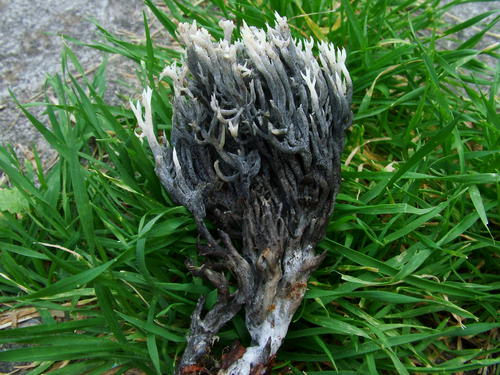
Fig. 1. Parasitic fungus Helminthosphaeria clavariarum on Clavulina cinerea. Anonymous
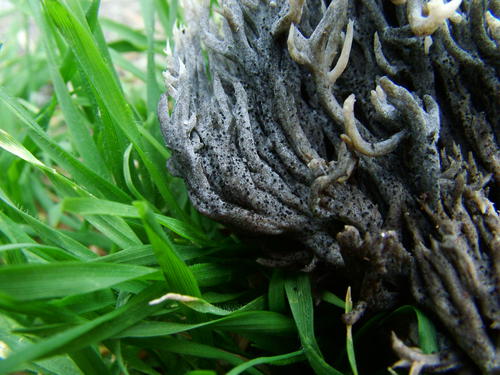
Fig. 2. Parasitic fungus Helminthosphaeria clavariarum on Clavulina cinerea. Anonymous
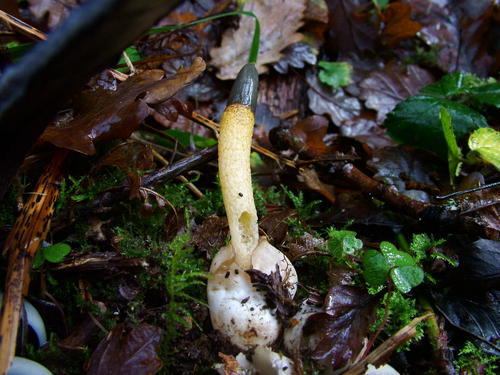
Fig. 3. Mutinus caninus. Anonymous
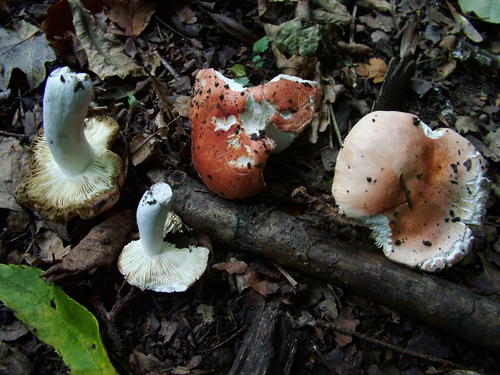
Fig. 4. Russula pseudointegra. Anonymous
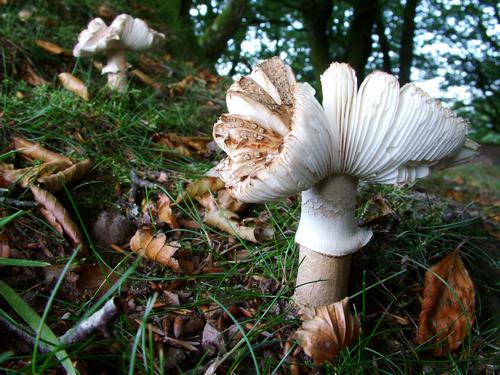
Fig. 5. The Blusher Amanita rubescens. Anonymous
Worcestershire Record | 30 (April 2011) (ISSN 1 475-9616) page: 16-18 | Worcestershire Biological Records Centre & Worcestershire Recorders
Worcestershire butterfly transects
John Tilt
The Butterfly Transect is our way of measuring butterfly populations either on a site basis or within an area. The Transect involves walking a predetermined route within the site over a period of 26 weeks each year. The route can be divided into sections dependant on habitat types (up to 15 different sections can be used). When the route is walked the recorder counts all the butterflies seen within a 5m or 10m distance, taking care not to count a butterfly twice. The Species – Number and Section are recorded. The weather on each visit is also recorded.
At the end of the walk the counts are entered into free software – Transect Walker 2.5 and at the end of the season the data are packaged and sent to the UK Butterfly Recording Scheme via the Transect Coordinator. The data are analysed and an annual report is compiled showing species trends.
The data from Worcestershire Transects have been extracted and analysed.
Worcestershire has 21 transects. These tend to be on nature reserves and on areas where some of the rarer butterflies are found. So these results do not reflect what is happening in the wider countryside. There is a separate recording scheme for doing this.
In 2010, 32000 butterflies were recorded 63 people and over 1000 man-hours were involved.
The Analysis.
First, the transect results are adjusted for missed weeks (holidays or bad weather etc). Where transects are walked on consecutive years trends can be calculated by pairing the counts from consecutive years.
Table 1 shows the trends for Worcestershire over the last 5 years for the commoner butterflies. Starting at 2006 showing +/-% for 2007 to 2010.
The figures show that in 2007, 26 of the 33 commoner species were declining compared with 2006. Nationally 2007 was the second lowest year in the 31 years since the scheme was started. This was put down largely to weather conditions – cold wet spring etc.
2008 and 2009 showed a considerable recovery of most species and 2010 consolidated that recovery.
Looking at individual species.
Brown Argus shows a considerable increase, particularly in 2010. The species is double brooded and has a fairly small first brood, when the second brood emerges the adults scatter widely into all sorts of habitats a number of sites only have a second brood.
Exactly the same pattern is shown for Common Blue with very high numbers in 2010, particularly for the second brood.
The migration explosion of Painted Lady is clearly shown in 2009
Small Tortoiseshells are showing a recovery after a few poor years due to the well documented parasite Sturmia bella.
Table 2 shows the butterfly numbers on 12 of Worcestershire sites which have been walked consistently over the last 5 years. After adjusting for missed weeks this enables us to calculate and index for the commoner butterflies. 2006 is shown as an index of 100 and the succeeding year calculated in relation to this.
Showing clearly the decline in 2007 (index of 82) in recovering to 121 in 2010.
This shows again significant increases for Brown Argus and common Blue.
The steadily improving species are highlighted in blue and species not doing so well are highlighted in red.
By far our commonest butterfly on our 12 sites was Meadow Brown but in 2010 only Ringlet showed to be more common.
Regional Action Span Species
Grizzled Skipper – Still present on Honebourne Railway line, Throckmorton Landfill site, Hipton Hill, Wyre Forest.
Dingy Skipper – Two Sites on the west side of the Malverns – Pennyhill Bank.
Pearl-bordered Fritillary – Doing quite well in Wyre and will be introduced to Grafton Wood this spring.
Small Pearl-bordered – Improved counts in Wyre
White Admiral – Showing a decline on the 12 sites and also a nationally.
Silver-washed Fritillary – Showing improvements in Worcestershire (Best year ever in Grafton Wood)
Dark Green Fritillary – Only very small numbers on west side of Malvern Hill.
High Brown Fritillary – Now lost to Worcestershire none seen on Malvern in 2010.
Wood White – Lost now in Worcestershire but small numbers found in Wyre and doing well over the border in Hereford but nationally a significant decline.
White Letter Hairstreak – Small colonies are being found around the county, for example in Trench Wood and at Brotheridge Green reserve.
Brown Hairstreak – Numbers stable – a good egg-count in 2010.
Grayling – Small colony is stable around North Hill Malvern
If any of the above species are recorded in Worcestershire please send the records to myself at john.tilt2@btopenworld.com.
| Paired Counts 2006 -2010 | ||||
| . |
% increase/Decrease |
|||
| Species |
2007 |
2008 |
2009 |
2010 |
| Brimstone |
-2 |
-37 |
94 |
13 |
| Brown Argus |
-88 |
138 |
49 |
516 |
| Brown Hairstreak |
-83 |
60 |
108 |
7 |
| Comma |
-45 |
-9 |
249 |
-21 |
| Common Blue |
-87 |
114 |
111 |
463 |
| Dark Green Fritillary |
-74 |
296 |
-36 |
-94 |
| Essex Skipper |
-31 |
261 |
51 |
-37 |
| Gatekeeper |
-42 |
85 |
9 |
-12 |
| Green Hairstreak |
2 |
122 |
-9 |
-65 |
| Green-veined White |
81 |
16 |
190 |
-20 |
| Holly Blue |
117 |
-5 |
-58 |
154 |
| Large Skipper |
7 |
-28 |
124 |
71 |
| Large White |
-2 |
17 |
250 |
-56 |
| Marbled White |
-30 |
-31 |
44 |
-29 |
| Meadow Brown |
-2 |
62 |
-14 |
-37 |
| Orange-tip |
26 |
-36 |
184 |
20 |
| Painted Lady |
-90 |
-93 |
90248 |
-97 |
| Peacock |
169 |
-62 |
78 |
38 |
| Pearl-bordered Fritillary |
765 |
-94 |
200 |
33 |
| Purple Hairstreak |
-81 |
117 |
27 |
112 |
| Red Admiral |
-6 |
-48 |
90 |
-29 |
| Ringlet |
-25 |
32 |
87 |
25 |
| Silver-washed Fritillary |
-4 |
21 |
70 |
50 |
| Small Copper |
-61 |
16 |
26 |
69 |
| Small Heath |
-42 |
-31 |
2 |
161 |
| Small Pearl-bordered Fritillary |
-24 |
-85 |
250 |
1129 |
| Small Skipper |
-80 |
45 |
290 |
-16 |
| Small Tortoiseshell |
-30 |
-31 |
127 |
120 |
| Small White |
-25 |
18 |
207 |
-19 |
| Small/Essex Skipper |
-12 |
27 |
29 |
-48 |
| Speckled Wood |
-27 |
69 |
84 |
-18 |
| White Admiral |
-50 |
3 |
19 |
69 |
| White-letter Hairstreak |
-100 |
0 |
850 |
|
| Increases |
7 |
19 |
28 |
18 |
| Decreases |
26 |
13 |
4 |
15 |
Table 1. Paired counts 2006-2010.
In Worcestershire we have 12 sites which have been walked for the last five years, this gives us a good indication of population changes over that period. Table 2 shows this. An index has been calculated using 100 for 2006 then the relative index for subsequent years for each species.
The 12 Sites are: Blackminster, Castlemorton Common, Chaddesely Woods Chase End Malvern, Grafton Wood, Knapp and Papermill, Monkwood, St Wulstans Reserve (Malvern), West Malvern, Windmill Hill, Wyre Forest East, Wyre Forest West.
The species highlighted in red show declines and those in blue increases. It must be appreciated that this is a very small sample. However in is clear to see that there has been a recovery after the seriously poor year of 2007.
Good news that the Small Tortoiseshell is recovering after the well documented parasite problems. In general table 2 shows a fairly optimistic situation. A lot the sites in this sample have had some management work for butterflies e.g. The Malverns, Grafton Wood, Monkwood and Knapp and Papermill.
Worcestershire Wildlife Trust has now recognised the importance of monitoring the effects of their management and has set up Transect on 12 of their reserves. The data are fed back to the reserve management to help plan habitat work.
The results of nationwide transects can be viewed on the UK butterfly monitoring site http://www.ukbms.org/ where data from all transects can be viewed together with the annual report.
Anyone interested in helping with a transect should contact John Tilt at john.tilt2@btopenworld.com.
-
Table 2 Sum of Value Index 2006=100
2006
2007
2008
2009
2010
2006
2007
2008
2009
2010
Brimstone 465
443
278
412
491
100
95
60
89
106
Brown Argus 40
5
11
14
78
100
12
28
34
194
Brown Hairstreak 10
2
3
5
6
100
17
27
56
59
Clouded Yellow 20
100
0
0
0
0
Comma 372
193
170
422
348
100
52
46
113
94
Common Blue 533
71
145
276
1309
100
13
27
52
246
Dark Green Fritillary 26
7
18
14
100
26
70
53
0
Dingy Skipper 1
7
3
100
700
0
0
300
Essex Skipper 13
9
33
36
29
100
69
250
277
221
Gatekeeper 2089
1153
1836
1778
1636
100
55
88
85
78
Grayling 1
1
100
0
0
0
100
Green Hairstreak 10
10
13
20
7
100
102
129
205
72
Green-veined White 559
887
990
2565
1918
100
159
177
459
343
Holly Blue 35
58
48
24
33
100
167
138
69
94
Large Skipper 190
202
136
228
436
100
106
72
120
229
Large White 452
417
477
1228
425
100
92
106
272
94
Marbled White 716
472
305
299
247
100
66
43
42
35
Meadow Brown 3908
3567
5505
3967
2537
100
91
141
102
65
Orange-tip 209
251
159
420
491
100
120
76
201
235
Painted Lady 138
14
1
705
19
100
10
1
511
14
Peacock 463
1237
466
583
941
100
267
101
126
203
Pearl-bordered Fritillary 31
268
17
51
68
100
865
55
164
218
Purple Hairstreak 27
5
11
12
19
100
19
41
45
70
Red Admiral 165
146
78
82
59
100
88
47
50
36
Ringlet 2333
1647
2133
2961
4180
100
71
91
127
179
Silver-washed Fritillary 201
193
234
381
530
100
96
116
189
264
2006
2007
2008
2009
2010
2006
2007
2008
2009
2010
Small Copper 225
86
86
94
187
100
38
38
42
83
Small Heath 84
49
18
30
89
100
58
22
36
106
Small Pearl-bordered Fritillary
17
13
2
7
86
100
76
12
41
506
Small Skipper 237
48
68
214
225
100
20
29
90
95
Small Tortoiseshell 64
44
29
51
134
100
68
45
79
208
Small White 597
440
502
829
926
100
74
84
139
155
Small/Essex Skipper 316
278
315
433
199
100
88
100
137
63
Speckled Wood 1010
620
1025
1521
1299
100
61
101
151
129
White Admiral 207
104
107
109
166
100
50
52
52
80
White-letter Hairstreak 3
2
1
17
100
0
67
33
567
Wood White 16
4
5
1
100
23
34
0
6
Grand Total 15783
12948
15227
19770
19140
100
82
96
125
121
Images
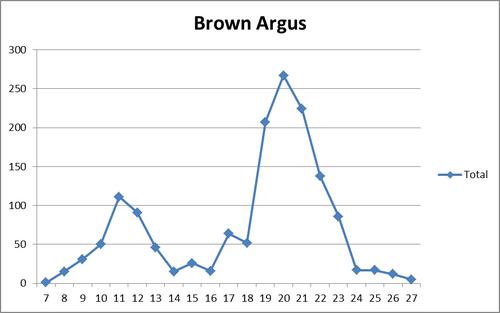
Fig. 1. Weekly transect counts 2010 Brown Argus. ©John Tilt.

Fig. 2. Brown Argus. ©John Tilt
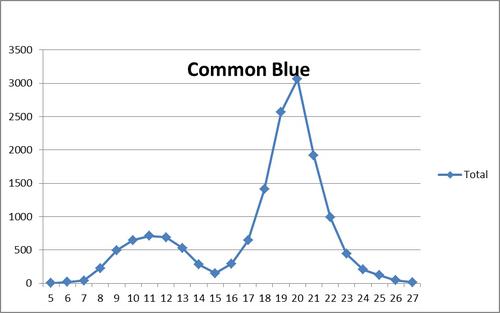
Fig. 3. Weekly transect counts 2010 Common Blue. ©John Tilt.
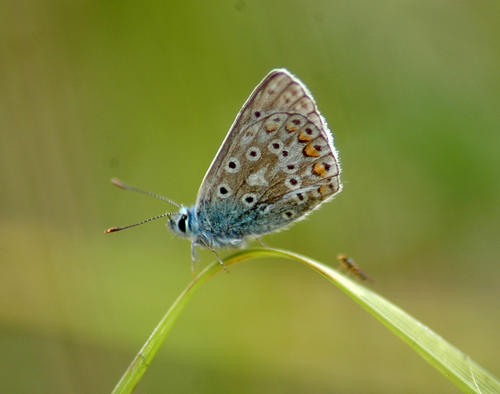
Fig. 4. Common Blue ©John Tilt
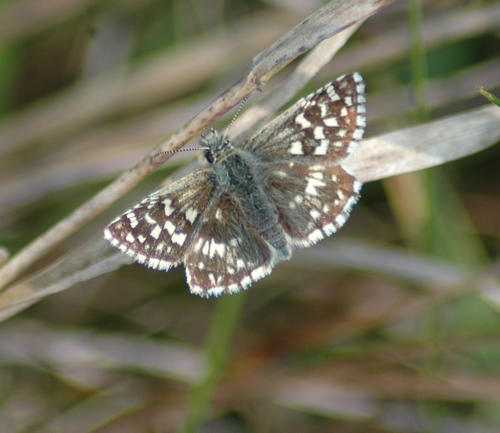
Fig.5. Grizzled Skipper ©John Tilt
Worcestershire Record | 30 (April 2011) (ISSN 1 475-9616) page: 40 | Worcestershire Biological Records Centre & Worcestershire Recorders
Stone the crows, what’s coming next? Carrion Crow breaking walnuts
Mark E Turner
I have for the few years we’ve been living in Evesham known of the Carrion Crows, Corvus corone that reside and raise their families in and around Bengeworth Cemetery, off the Broadway Road.
During October 2010 I noticed when observing from the second floor (converted roof-space) that one or two adult crows from this clan did as the crow flies and make a regular beeline from the graveyard over our house to a large walnut tree Juglans regia to the rear of our property in a neighbour’s garden.
The nuts which appeared to be bursting from their cases since a number of recent frosts, were being collected one at a time by these birds, usually from the crown of the tree. On the morning of 18th October I saw a bird repeatedly dropping a walnut whilst in flight, down onto the car park tarmac below. Another time a crow was hammering open a walnut on a chimney stack across the road.
In the late afternoon of a cold and sunny 20th October I rushed over to observe from our back kitchen window a crow making for the walnut tree again. As the bird departed I rushed to the front living room window to see what would occur this time. The crow in its flight back to the cemetery momentarily stalled then jinked upwards and dropped its walnut only to catch it in mid-air before continuing on its course back home. The skill involved in this manoeuvre almost suggested this to be playful fun, a bit of sport typical of an intelligent being. And these birds being intelligent, resourceful as well as opportunistic have long been a fascination to me not least for their feeding behaviour.
The saga continued at 11.00 hrs on 12th November when the nut-breaking routine had shifted across to a nearby warehouse roof which is flat in its design with a slightly higher outside ledge all the way round. This gave the birds a good level of privacy to carry out their ritual. On this day a crow collected a walnut and made three attempts to break it open by dropping it onto the roof after a vertical ascent on the wing. Obviously this didn’t work and the ritual ceased. The crow then seemed to walk around in a pondering manner as if figuring out what to do next. The decision was to go and get another nut. With the walnut tree now pretty much denuded of its leaves I could watch with ease the method used to procure the fruits. Having selected a nut the crow very gently tweezered at the stalk, but it dropped straight to the ground. Another nut was selected but this time was gripped around the whole case. Back at the roof one block over, this second attempt took five aerial drops before the kernel was extracted. Fortunately for me the crow hopped up onto the raised ledge giving a good view of it from the top bedroom. The bird at first picked delicately at the snack, but then finished off by taking bigger morsels.
The episodes with the harvesting and breaking open the walnuts recall observations I’ve made at Dawlish Warren National Nature Reserve in Devon of crows dropping shellfish in a similar manner. In my battered copy of T.A.Coward’s The Birds of the British Isles and Their Eggs Series One, the author describes the same method of preparation for breaking into molluscs by dropping them onto hard ground. However, I disagree with him that they seldom vary the height from which they drop their food items if the first efforts fail. A case in point being the second walnut on the warehouse roof when on the fifth attempt the crow climbed even higher to achieve the desired result.
More recently my wife and I watched a crow in Sandford Park, Cheltenham, wading up to its belly in a slow-flowing stream and fishing out meagre meals by plunging its head below water.
Most shocking of all though was a time back in 2005 when looking across pasture in the North Cotswolds near Guiting Power, a Carrion Crow was hammering at something in the grass, raining heavy blows repeatedly with its bill on an invisible object. Imagine my horror when the invisible object turned out to be a rabbit which after several seconds of sustained beatings, leapt into life putting an end to the crow’s intentions. Whether the rabbit was stricken with disease and had been resting up and giving the impression of being dead to the crow is open to conjecture or was the crow genuinely attempting to dispatch the rabbit itself? The old saying ‘a murder of crows’ suddenly has a ring of truth about it. I would welcome anybody’s views on this matter or indeed if anyone has witnessed a similar incident.
Crows have evolved to be generalist feeders, yes, but should that read: generalist birds of prey. Perhaps evolution is still progressing.
Worcestershire Record | 30 (April 2011) (ISSN 1 475-9616) page: 40 | Worcestershire Biological Records Centre & Worcestershire Recorders
Worcestershire Record | 30 (April 2011) (ISSN 1 475-9616) page: 41 | Worcestershire Biological Records Centre & Worcestershire Recorders
Unrest in the ranks between Kestrel and Sparrowhawk
Mark E Turner
Since I started to pay serious attention to the burgeoning numbers of birds of prey some twenty years ago, I have been under the impression that the unpretentious demeanour of the Kestrel placed it somewhere near the bottom of raptorial hierarchy. On many occasion I have seen these delightful birds on the wrong end of a hook-billed aggressor, usually victims of piracy. However, birds have a knack of proving even the most seasoned observers among us wrong.
Kestrels are rarely encountered in the garden predating your favourite Blue Tits and are generally seen hovering angelically beside the road: they are not tarred with the same brush as, say, Sparrowhawks. Which leads me to an extraordinary event on 17th January 2007 that took me by surprise in more ways than one. We were living in Kemerton at the time; it was around 13.30 hrs and following a brief storm front passing through from the west, the sky cleared and it became brighter. As I stepped out onto the back patio to throw out a few crumbs from lunch for the birds, a juvenile female Sparrowhawk flew into our small enclosed garden carrying an item of prey. Hot on its tail was a juvenile male Kestrel which I believe was attempting to rob the hawk of its lunch. The two raptors did several circuits round the garden as I froze to the spot completely in the open. I could hear their claws grappling and clattering the fence panels as the Sparrowhawk scrambled for cover in the Leylandii hedge.
The hawk escaped with its meal by going to ground in our neighbour’s plot. The gardens back onto farmland fields, hunting territory for both these birds, the young Kestrel I certainly recognised and hawks regularly took small birds from garden feeding stations.
I would not normally have thought competition between local raptors for a meal was an issue, particularly during recent mild weather with an abundance of prey on offer. However, it appears Kestrels have aggressive piratical tendencies just as many other raptors do and I now see them in a different light.
So it seems our Sparrowhawks with their bad-boy image definitely do not have it their way as often as we make out and with a larger cousin making a healthy return to our forests, the poor Sparrowhawk has another reason to be fearful. An example of this occurred whilst I conducted my occasional raptor survey at a certain site in the North Cotswolds (southeast Worcestershire/Gloucestershire border) on 16th February 2009. The area comprising hillside farmland, conifer forest and mixed woodland, has hosted nine species of raptor, four of which are year-round residents, so there’s bound to be conflicts. On the day in question two Accipiters emerged from the large conifer wood on which I was focussing my attention: they were apparently engaged in a high speed chase. I believe both birds to have been males not dissimilar in their dark blue-grey upperparts, but quite different in size and shape. The pursuer having a greater head-profile and deeper chest pumped its wings hard to keep up with its slighter built quarry: Goshawk versus Sparrowhawk! I am not inclined to divulge site details to one and all, but it does lie within the county of Worcestershire where I have on several occasions enjoyed territorial displays of all the resident birds of prey including Goshawk.
Image
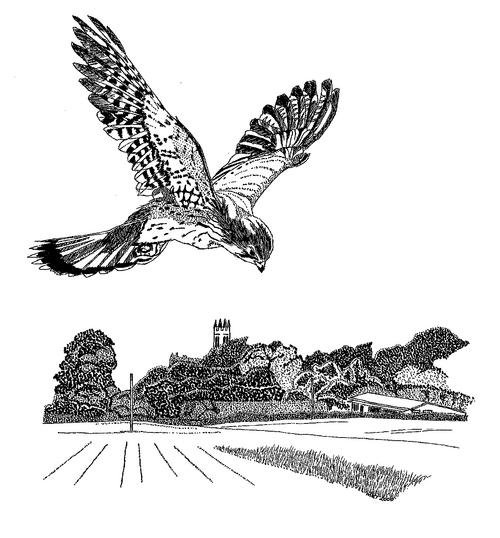
Fig. 1. Kestrel. Drawing ©Mark Turner
Worcestershire Record | 30 (April 2011) (ISSN 1 475-9616) page: 41 | Worcestershire Biological Records Centre & Worcestershire Recorders
Who killed the Manxie?
Mark E Turner
As I have been recording local Peregrine activity since I first found a tiercel roosting on Pershore Abbey in April 2005, I was naturally intrigued when I first heard about Richard Stott’s Manx Shearwater casualty via Harry Green last spring. (Stott 2010).
Nowadays with raptors doing so well, you can bet if anything odd turns up it will often end up as lunch. Our Pershore Peregrines (yes there is now a pair) I have known to feast on a range of birds including Blackbirds, a Fieldfare, a Swift was a real trophy kill and infrequently recorded by past observers/authors, but mostly feral pigeons are the staple diet.
Manx Shearwater as a prey species is well within the capabilities of Peregrine, but is certainly noted by past observers as unusual. The 2009 Devon Bird Report mentions Manx Shearwater as prey taken by resident breeding Peregrines at St. Michael’s Church in Exeter, but says it is an unusual inland record. Derek Ratcliffe states Manxies as unusual inland prey species taken by Peregrines in the Scottish Highlands, relating to overland migration or ‘wrecks’ of maritime birds.
However, I would not rule out female Sparrowhawk as a suspect since having witnessed big, feisty Wood Pigeons being knocked out of the sky in the past, a sickly Manx would be no contest at all. Interestingly though, very recently I discovered a fresh undamaged corpse of a hen Pheasant at Broadway Gravel Pit Local Nature Reserve with identical injuries sustained by the Manxie. We have no recent records of Peregrine from that well watched area and I am not inclined to suspect Common Buzzard in either of the above cases.
References
Devon Bird Report. 2009. Devon Bird Watching and Preservation Society.
Ratcliffe, D., 1980. The Peregrine Falcon. Poyser.
Stott, R.D.E., 2010. Manx Shearwater Puffinus puffinus in Pershore. Worcestershire Record, number 29:41.
Turner, M.E., 2007. Hawkwatch, North Cotswolds to Coasts, 1988-2006.
Worcestershire Record | 30 (April 2011) (ISSN 1 475-9616) page: 41 | Worcestershire Biological Records Centre & Worcestershire Recorders
Worcestershire Record | 30 (April 2011) (ISSN 1 475-9616) page: 21 | Worcestershire Biological Records Centre & Worcestershire Recorders
Chetostoma curvinerve – a second record for VC37, Worcestershire
Brett Westwood
On 24th February 2011, the first mild and sunny day for several weeks, I noticed two orange flies on the leaves on an evergreen shrub Itea ilicifoliain my garden in Stourbridge. Their wings were patterned with dark stripes and blotches and they flicked them in a sideways motion while posturing in front of each other. They looked like picture-winged flies, but were larger than any I’d seen before in the garden. In addition, the time of year seemed odd.
I took a few photographs and began a web search. The website www.diptera.info has an extensive collection of photographs of picture-winged flies and one species, Chetostoma curvinerve, matched the ones in my garden. However they were described as local in the UK , so I was wary of plumping for a hasty identification.
I sent pictures of them to Harry Green and Rosemary Winnall, who promptly replied by brandishing and posting copies of the latest Dipterist’s Digest which contained an article by Laurence Clemons (2010) about Chetostoma curvinerve and its distribution in the British Isles. The records below are from his fascinating account.
Although the first record of Chetostoma curvinerve in the UK was in 1893 in Cornwall, there were no confirmed, captured records until the 1970s, and a review by Steven Falk in 1991 of scarce and threatened flies of Great Britain cited just half a dozen post-1960 sites, in Cornwall, Hampshire, Dorset, Sussex and Surrey. In the late 1990s, more records came from the south-east plus others from Glamorgan (Swansea), Somerset and the Isle of Wight. In the first decade of the 21st century there were more records including the first and only record from Worcestershire on April 17 2003 of one visiting a moth trap in Ribbesford Wood, near Bewdley. By the end of October 2010 there were 57 records of Chetostoma curvinerve from 39 sites in 39 10-kilometre squares, most in the south and south-east. Private gardens and cemeteries accounted for two-thirds of these. Alan Stubbs,an expert dipterist, has since confirmed my identification.
Clearly this fly is on the move, but mysteries remain. It is often seen on the leaves of evergreens such as holly, ivy and rhododendron, possibly because they warm up well in early spring and make broad jousting platforms. Most records are from February until May, with a gap in midsummer and then a scattering in late summer and early autumn. Its food-plant is unknown , but close relatives are associated with honeysuckle Lonicera and it is possible that the larvae develop in the berries. Alan Stubbs (pers comm.) thinks that the fruits of cherry plum Prunus cerasiferaare a possible host. Clemons (2010) suggests that maturing ivy berries in spring when most adults have been seen might point to them as a larval food, but as yet there is no proof. Cherry plum, ivy and honeysuckle are a few metres from my sightings.
Identifying Chetostoma curvinerve is relatively simple as few picture-winged flies of its size (7mm long), have a bright-tawny orange body and a similar wing pattern which includes a dark wing-tip and a diagonal line reaching almost entirely across the forewing. In addition, the males have very distinctive dark curved spines guarding the mouthparts. The time of year and location is also a guide. A test key by Alan Stubbs has proved useful in determining the species.
References
Clemons, L. 2010. Chetostoma curvinerve (Rondani) (Diptera, Tephritidae) in Britain. Dipterists Digest, 17, No. 2, pages 83-98.
Stubbs, A. Test keys to Tephritidae. Version 31 Mar 2009
Images
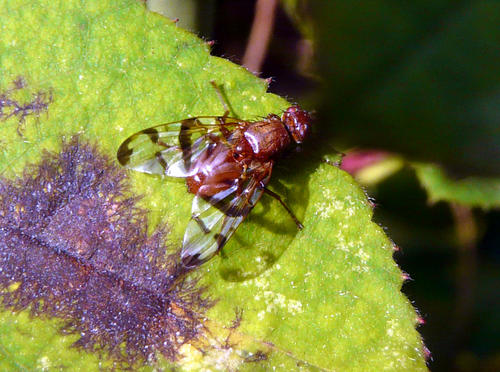
Fig. 1. Chetostoma curvinerve in Stourbridge. Picture ©Brett Westwood
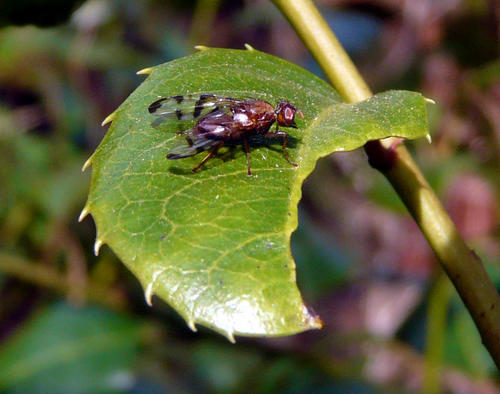
Fig. 2. Chetostoma curvinerve in Stourbridge. Picture ©Brett Westwood

Fig. 3. Chetostoma curvinerve in Stourbridge. Picture ©Brett Westwood

Fig. 4. Chetostoma curvinerve in Stourbridge. Picture ©Brett Westwood
Worcestershire Record | 30 (April 2011) (ISSN 1 475-9616) page: 25 | Worcestershire Biological Records Centre & Worcestershire Recorders
Dotted beefly Bombylius discolor in west Worcestershire
Brett Westwood
A Dotted Beefly Bombylius discolor seen on the edge of the quarry at the end of Camp Lane, near Great Witley, 30th April 2011, grid reference SO744637. Seen perched but too agile to photograph.
According the NBN there are old records for SO77 (Wyre Forest area) but no recent reports in the west of Worcestershire.
Worcestershire Record | 30 (April 2011) (ISSN 1 475-9616) page: 25 | Worcestershire Biological Records Centre & Worcestershire Recorders
Worcestershire Record | 30 (April 2011) (ISSN 1 475-9616) page: 41-42 | Worcestershire Biological Records Centre & Worcestershire Recorders
Aerial inter-relationships between four species of raptor at Winchcombe, Gloucestershire (VC33 SP 03 107M O.D.)
P.F. Whitehead
I have previously drawn attention (Whitehead, 2006) to associations of raptorial birds in Worcestershire and provided some discourse, parallels and references for what must have been a more common feature of past times when raptors were more abundant. On a relative’s farm in a remote part of west Wales where I have previously been able to study Red Kites (Milvus milvus L.), it’s clear that there is a great deal of interplay between individuals of this species, especially during March, which is something one may hopefully look forward to in this area.
March 23rd 2011 was a fine settled day with high levels of insolation and a light easterly air flow. On the low Cotswold foothills at the edge of Winchcombe town in Gloucestershire (VC33 SP 03 107m O.D.), Buzzards (Buteo buteo L.) were conspicuously active once thermals developed. At 1405 hrs GMT four highly vocal Buzzards were persistently falling off the tops of thermals in their highly distinctive ‘porpoising’ display (Whitehead, 2002). This activity attracted other raptors to the spot and a calling Peregrine (Falco peregrinus Tunstall) along with another more distant unknown falcon, appeared on an adjacent thermal. Less than 100 metres away two Kestrels (Falco tinnunculus L.) commenced vigorous display, the male circling with characteristic ‘wing-flicking’ before both birds plunge-dived from height into a tall cultivated poplar tree in open country.
In the midst of all of this activity a further more distant call, with a shrill high-pitched cat-like quality that I’ve heard only rarely, heralded the arrival of a Red Kite, a bird which once “sailed” commonly over parts of the region (Harbird, 1998; Harthan, 1947). This bird behaved differently, flapping steadily through the thermals at a relatively low level on an easterly course presumably acknowledging the presence of the other raptors, or confirming its own presence to them. I was able to demonstrate this ‘social networking’ to another observer who had never seen some of these birds before and was amazed that they might all occur at one spot. In the warmer parts of Europe, large numbers of some raptors also aggregate on thermals to consume macroinvertebrates caught up in them (Whitehead, 2004).
References
Harbird, R., 1998. The return of the magnificent seven. Worcestershire Record 4:12.
Harthan, A.J., 1947. The birds of Worcestershire. Littlebury & Co. Ltd, Worcester, pp. 1-79.
Whitehead, P.F., 2002. An assemblage of 13 Common Buzzards Buteo buteo(L., 1758). Worcestershire Record 13:13.
Whitehead, P.F., 2004. Omophlus proteus Kirsch, 1869 (Col., Tenebrionidae) heavily predated by Eleonora’s Falcon (Falco eleonorae Géné) over Kos, Greece. Entomologist’s Monthly Magazine 140:57-58.
Whitehead, P.F., 2006. Aerial inter-relationships between large mostly predatory birds, with particular reference to the Raven. Worcestershire Record 21:19-20.
Worcestershire Record | 30 (April 2011) (ISSN 1 475-9616) page: 42 | Worcestershire Biological Records Centre & Worcestershire Recorders
Worcestershire Record | 30 (April 2011) (ISSN 1 475-9616) page: 42-43 | Worcestershire Biological Records Centre & Worcestershire Recorders
An assemblage of 300 House Martins at Broadway, Worcestershire
P. F. Whitehead
On 26 May 2011 I received a telephone call that a large number of House Martins Delichon urbica (L.) had assembled in the Broadway area of Worcestershire at a spot where there was no recorded precedent. The assemblage amounted to some 300 birds, hawking invertebrates above Sloe Prunus spinosa L. thickets along a 100 metre embanked stretch of the old Great Western Railway mainline (SP03 70 m O.D.) during the afternoon.
The Cotswolds escarpment was marked on 26 May 2011 by meteorological instability as a fragmenting front tracking south-east created significant localised changes in atmospheric pressure. Frequent showers sometimes coalesced in a variable moderate to fresh gusty north-westerly flow. I reached the site at 1740 hours BST and observed some 45 House Martins feeding intensively above Sloe scrub between six and nine metres above the ground. As I watched them a further dense group erupted, apparently from ballast on the railway track, so that I was able to count some 105 birds in all; the following day some 100 martins were seen. Although rather late in the month, the implication would be that these were immigrants stalled by the front, making use of a food resource, believed to be small flies, itself assembled at one spot (Moss, 1995) by the north-westerly flow passing over the embankment providing some shelter in its lee (Turner, 1994). House Martins take a wide variety of invertebrates depending on their location including, for example, ants (Colston & Curry-Lindahl, 1986) and beetles (Whitehead, 1986; Osborne & Whitehead, 1988). It is possible that an emergence of flies from Broadway Sewage Plant was swept over the embanked railway line by the wind. This would explain the feeding concentration and although somewhat speculatory, numerous Barn Swallows Hirundo rustica L. were observed feeding at the sewage plant at the same time.
Although my mechanised data is incomplete I have no personal recollection of 300 House Martins massed in Worcestershire (noting that streams of autumn emigrants may reach significant numbers over a period of time), although regional large assemblages are documented by Harrison & Harrison (2005). However, a glance through the four most recent annual reports of the West Midland Bird Club shows that the numbers involved in such assemblages have shown a continuing tendency to reduce but that, interestingly, such spring observations are most often associated with episodes of climatic instability. It seems therefore that this observation warrants publication.
References
Colston, P. & Curry-Lindahl, K. 1986. The Birds of Mount Nimba, Liberia. British Museum (Natural History), London. Publication No. 982. pp. 1-129.
Harrison, G. & Harrison, J. 2005. The new birds of the West Midlands. pp. 1-496. West Midlands Bird Club.
Moss, S. 1995. Birds and weather. pp. 1-174. Hamlyn Ltd, London.
Osborne, P.J. & Whitehead, P.F. 1988. Coleoptera in the diet of House Martins in Worcestershire. Entomologist’s Monthly Magazine 124:232.
Turner, A.K. 1994. The Swallow. pp. 1-128. Hamlyn Ltd, London.
Whitehead, P.F. 1986. Coleoptera in the diet of Worcestershire House Martins. Coleopterist’s Newsletter 23:7-8.
Worcestershire Record | 30 (April 2011) (ISSN 1 475-9616) page: 42-43 | Worcestershire Biological Records Centre & Worcestershire Recorders
Worcestershire Record | 30 (April 2011) (ISSN 1 475-9616) page: 42 | Worcestershire Biological Records Centre & Worcestershire Recorders
An extreme beak aberration in a Jackdaw Corvus monedula L., 1758, from Broadway, Worcestershire
P.F. Whitehead
Jackdaws are time-honoured nesters in the chimney stacks of traditional Cotswold houses, including at Broadway village in Worcestershire. On 13th April 1983 I picked up a dead adult Jackdaw at Broadway with a markedly exaggerated overgrowth of the rhamphotheca, the keratinised beak sheath, of the premaxilla (Fig. 1.). The ornithological literature is peppered with accounts of similar, mostly more minor, aberrations which raise a number of questions, including how the overgrowth may have originated, and how the bird survived into adulthood.
The mandible articulates with the cranial occiput through small quadrate bones; these essentially allow the mandibular and maxillary bones to move up and down, the beak to open, and the condition of the rhampohothecae to be maintained in the normal way. Reinforcing rods, the jugal bones, pass from the base of the maxillaries below the orbits to meet the mandibular hinge joints. Without these and their attendant ligaments, a bird would be unable to move its beak.
In the case of this Jackdaw the right side jugal bone is atrophied to such an extent that it is almost separated into two (in Fig. 1. I have highlighted this bone between two thick white-coloured bars); the other is somewhat thickened. Here is the first clue to the aberration. There is no evidence that this Jackdaw was ever able to close its beak any further than shown in the accompanying figure. There is some evidence that the mandible, quadrate bones and occiput have become ankylosed or fused (any attempt to forcefully close the beak would effectively destroy the skull). Presumably this aberration is of congenital origin and worsened over time since there is no visible evidence of trauma.
How did the bird survive? Such an aberration could scarcely have happened to a more adaptable species of bird and the slight inclination of the downturn to the right lends some credence to a view that this bird may have learnt to feed with its head on one side perhaps making particular use of the tongue. When found the bird was clearly underweight but not emaciated.
Image
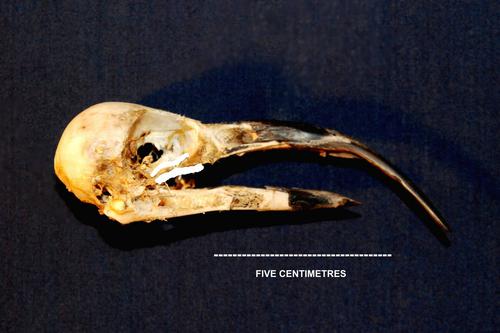
Fig. 1. Lateral view of aberrant skull of adult Jackdaw Corvus monedulafrom Broadway, Worcestershire, 13 April 1983. ©Paul Whitehead.
Worcestershire Record | 30 (April 2011) (ISSN 1 475-9616) page: 0 | Worcestershire Biological Records Centre & Worcestershire Recorders
Grey Squirrels (Sciurus carolinensisGmelin) debarking a mature coast redwood (Sequioa sempervirensEndlicher) in Evesham town, Worcestershire during the 2010-2011 winter
P.F. Whitehead
During March 2011 my attention was drawn to the fact that Grey Squirrels Sciurus carolinensis had debarked an ornamental Coast Redwood Sequoia sempervirens of Victorian age in Evesham town, Worcestershire. When I visited the site I observed, quite remarkably, that the outer layers of the outer bark had been removed for the entire height of the twin-stemmed tree (Fig. 1.) estimated to be in the order of 16 metres. The bark removals that littered the ground varied from about 3 cms in length to long strips some 30 cms long and up to 2.5 cms thick. Observers noticed that the squirrels were active during February 2011 and were concerned that the tree might in some way be impacted on. Providing there is no repetition that can be dismissed.
I have no previous experience of Grey Squirrels intensively debarking trees in the family Taxodiaceae, certainly not in this area. Normally Grey Squirrels debark trees which are relatively thin-barked or sappy to gain access to nutrients, especially in the phloem. It is well-known that Sycamore Acer pseudoplatanus L. is favoured, especially when the sap is rising in the spring, and that most British Sycamore woodlands are affected. The question remains as to why Grey Squirrels would debark a Coast Redwood tree so intensively when the tannin-rich bark is stringy, fibrous, has no food value, and would scarcely impact on incisor tooth condition.
Coast Redwoods have a highly developed ability to reproduce themselves vegetatively; it is not infrequent to observe mature trees surrounded by basal suckers, which are able to develop into new trees when the parent tree ages. Buried deep in the outer bark of this tree were numerous semi-dormant adventitious buds, some of which had been exposed. It is contended that the squirrels had actively searched for these by removing the bark systematically and then consumed the developing buds with their rich store of nutrients and auxins. Such damage had not been observed at the site before and it seems probable that this urban population was faced with two choices once their range of food stocks was nearing exhaustion in a severe winter. One was to individually disperse into urbanised surroundings with much more limited available food; the other was to stay put and make creative choices in terms of food resource usage. That is my explanation for why this tree was debarked.
The interlocking history of all these non-native organisms warrants comment. The Grey Squirrel was introduced into Britain sometime around 1828 (Fitter, 1959). The Coast Redwood was introduced into Britain in 1846 (Gilbert-Carter, 1936), i.e. about the same time, although the genus was native in the pre-Pleistocene of Europe. Sycamore is likely to have been introduced into Britain in the early medieval period (Whitehead, 2005). This note is, in essence therefore, a tale of man the unwitting miscreant.
References
Fitter, R.S.R. 1959. The ark in our midst. William Collins Sons & Co. Ltd, London.
Gilbert-carter, H. 1936. British trees and shrubs. Clarendon Press, Oxford.
Whitehead, P.F., 2005. The Coleoptera of Sycamore (Acer pseudoplatanusL.) with reference to Sooty Bark Disease and Bredon Hill, Worcestershire. Entomologist’s Gazette 56:107-127
Image
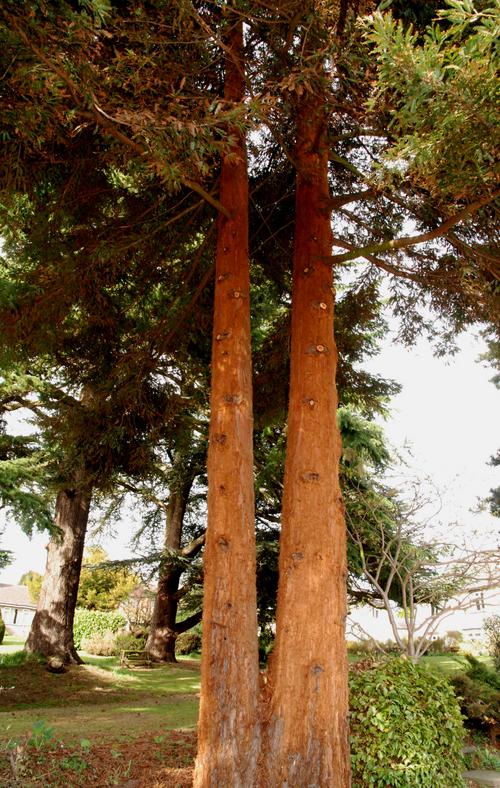
(C)PFWHITEHEAD
Fig. 1. Mature twin-stemmed Coast Redwood (Sequioa sempervirens) debarked by Grey Squirrels (Sciurus carolinensis), Evesham town, Worcestershire, 31 March 2011. ©Paul Whitehead
Worcestershire Record | 30 (April 2011) (ISSN 1 475-9616) page: 37-38 | Worcestershire Biological Records Centre & Worcestershire Recorders
The stoat Mustela erminea L. as a historic predator in Worcestershire
P.F. Whitehead
Pictures ©Paul Whitehead.
Two bird bones from Romano-celtic Kemerton (found on 11 December 1971) and medieval Pershore (Whitehead & Vince, 1979) show evidence of predation. The bones are both tibiotarsi of domestic fowl (Gallus gallus ssp. domesticus L., Fig. 1.). The tibiotarsus is the principal leg bone which equates anatomically with the mammalian tibia. Fig. 1. shows the two bones in their life positions, the distal articulation of the medieval bone (on the left) and both articulations of the Romano-celtic bone, dating to circaAD250, having been anciently sheared off. The medieval specimen, dating to the period AD1200-AD1300, shows a pair of well-marked tooth impressions as well as various superficial surface markings whilst the earlier specimen shows surface punctures effected with such strength that the bone fragmented.
Given the reasonable assumption that these paired impressions are those of a carnivorous mammal I applied the canine dentition of a range of carnivore skulls to them of which mustelids proved a convincing match. The upper canines of a large male Weasel (or Least Weasel Mustela nivalis L., Fig. 2.) did not match perfectly but those a Stoat (M. erminea L., Fig. 3.) did and this is taken to be the predator in both cases. The larger Stoat has the ability to exert substantial and continuing pressure on the bones of its prey whilst the Weasel, in examples seen, leaves something of more ‘sewing machine’-like bite traces, and is generally limited to smaller prey with less robust skeletons. Fig. 4 confirms the relative sizes of the skulls and dentition of three mustelids, the Ferret Mustela putorius ssp. furo L., Stoat and Weasel in relation to the medieval bone.
These records of Stoat kills extending back in time to the early Historic Period provide the earliest primary evidence of the occurrence of Stoat in Worcestershire. The relationship between wild animals and society in Romanised and medieval Worcestershire will have been somewhat different to now. In relative terms, the value of a domestic fowl would have been infinitely greater. It is impossible to say whether the medieval birds were managed resources of Pershore Abbey, although given the situation within the curtilage of the Abbey estate (Whitehead & Vince, 1979) this seems probable. It is at least uncertain that commoners had the time and resources to manage fowls within a system of land use very different to the modern one. At Kemerton, fowl bones were thrown into rubbish pits and the birds apparently wandered amongst a nucleated settlement sited on land above the Carrant Brook. In both cases the fowls were of small type (those from Kemerton being slightly the smaller), not unlike those kept recently in some remote parts of southern Europe, the eating of which is quite different and distinctly superior to that of most modern breeds.
A single Buzzard Buteo buteo L. bone was also found in the medieval sediments at Pershore; this is an opportunistic species which may well have been attracted by the presence of managed fowls.
Acknowledgements
I am grateful to the late Don Bramwell for his assistance in identifying bird bones.
Reference
Whitehead, P. F. & Vince, A.G., 1979. An abandoned Flandrian river channel at Pershore, stratigraphy pottery and biota. Vale of Evesham Historical Society Research Papers 7:9-24
Images
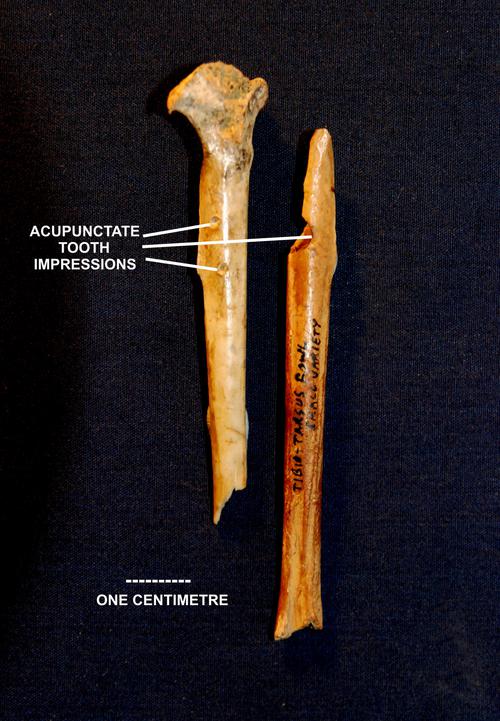
(C)PFWHITEHEAD
Fig. 1. Tibiotarsi of medieval (on left) and Romano-celtic domestic fowl from Worcestershire showing tooth impressions of a Stoat.
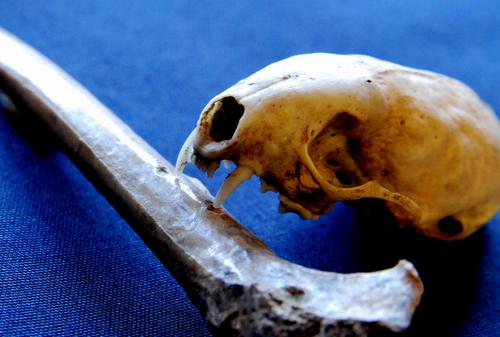
(C)PFWHITEHEAD
Fig. 2. Canine teeth of a large male Weasel skull in relation to canine tooth impressions on a tibiotarsus of a domestic fowl from medieval Pershore.
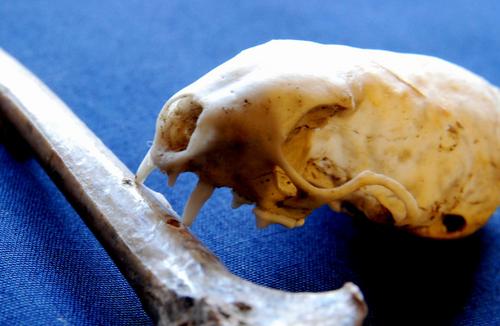
(C)PFWHITEHEAD
Fig. 3. Canine teeth of a Stoat skull in relation to canine tooth impressions on a tibiotarsus of a domestic fowl from medieval Pershore.
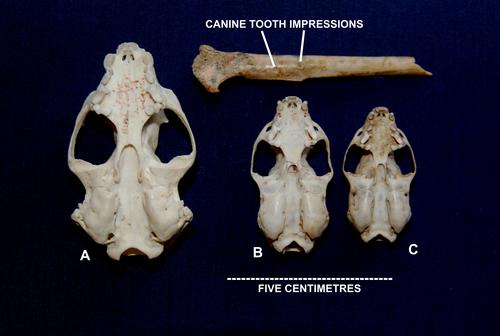
(C)PFWHITEHEAD
Fig. 4. Skulls in palatal view of Ferret (A), Stoat (B) and Weasel (C) in relation to canine tooth impressions on a tibiotarsus of a domestic fowl from medieval Pershore.
Worcestershire Record | 30 (April 2011) (ISSN 1 475-9616) page: 18-20 | Worcestershire Biological Records Centre & Worcestershire Recorders
Where next for the Brown Hairstreak Thecla betulae?
Mike Williams
It was back in 2006 (Worcestershire Record Number 20, April 2006) that I last reported on the county’s most elusive butterfly so a further update seems timely. At that point, we had recorded Brown Hairstreaks in 108 1x1km squares over a wide area of east Worcestershire bounded by Redditch to the north, Pershore to the south, the county boundary to the east and the M5 motorway to the west. The butterfly is difficult to spot as an adult but it lays its eggs on blackthorn (normally singletons), where they remain throughout the winter and, with practice, these can be located fairly easily. We have actually seen adult butterflies in less than 10% of recorded squares: all the rest of our records are based on finding eggs. Through West Midlands Butterfly Conservation a band of volunteer “Hairstreak Champions” have been recruited and trained to search for eggs and our current knowledge of the distribution and status of the Brown Hairstreak is a result of their commitment and dedication. Venturing out in the depths of winter to search hedgerows for objects the size of a pinhead can be viewed perhaps as an extreme form of butterflying but, nevertheless, it has proved surprisingly productive. So much so, that the number of known 1x1km squares where the butterfly has been found has now grown to 179. Each winter, new squares have been added and our evidence suggests that the butterfly is still expanding its range in the county, possibly in response to climate change, but no doubt helped to a more limited extent by agri-environment schemes that have encouraged farmers to cut more hedgerows on rotation. Over the years Butterfly Conservation has worked closely with Natural England to encourage better hedgerow management on farms, latterly through the promotion of Higher Level Stewardship, although recent cuts in budgets makes this option less likely at least in the short term. It sadly still remains the case, however, that the vast majority of eggs laid by every female Brown Hairstreak are lost to annual hedge flailing. Searching for eggs, especially post-Christmas, can be a pretty depressing experience with relatively few hedges having escaped the flail.
This last winter (2010-2011) has proved particularly good for finding new areas for the Brown Hairstreak with 17 additional new 1x1km squares added to our distribution map. Most of the expansions in range have been to the north-east and south with several new squares added near Redditch and around Bishampton and Church Lench. Many of these are areas, we have searched in previous years with no success and finding eggs can therefore be seen as evidence of genuine range expansion. One should not run away with the idea, however, that we are turning up eggs in every place we look. I would estimate this winter that we have only found eggs in around 1 in 4 of the squares searched. We worked hard, for example, to locate eggs along the 49th parallel south of the Lenches which would have been a new 10x10km square for the Brown Hairstreak but with no luck. Redditch itself certainly invites further investigation with places like the public amenity area around Walkwood Coppice on the edge of the town full of excellent looking blackthorn and we are keen to hear from recorders who may be willing to help search this area next winter. Towards Worcester, we have been much less successful in locating new egg squares, apart from around White Ladies Aston, and the M5 still acts as a largely impenetrable barrier to the west.
We did have hopes of a major breakthrough over the M5 after a report of an adult being spotted in the Waitrose supermarket car park in Droitwich last October but, so far, we have not been able to follow this up with the discovery of eggs west of the motorway. Back in 2006, we had a report of another adult being recorded virtually under a motorway bridge near Oddingley which resulted in us obtaining permission from the Highways Agency to search the verge of the motorway itself, which is perhaps another form of extreme butterflying. Interestingly, we found lots of suitable blackthorn on the carriageway south of Droitwich but unfortunately no eggs, although the Highways Agency, as a result of our survey, did agree to manage their blackthorn on rotation. Any records of brownish- orange butterflies recorded out of a speeding car window in September, however, are unlikely to be accepted without further evidence! An adult sighting over the county boundary at Kings Coughton, in contrast, did result in us finding only the second modern egg record in Warwickshire along the edge of Old Park Wood with other nearby records for Worcestershire around Cladswell and Cookhill. Searches in this area in future years will perhaps give us a better idea of whether this was merely a female with a poor sense of direction or whether this is the start of a further expansion of range to the east.
A new area of research over the past five years has been into the Brown Hairstreaks’ use of so-called assembly trees. It has been found that on emergence at the end of July, male Brown Hairstreaks head for prominent ash trees usually situated in a hedgerow or along the edge of a wood. Here, the males set up territories and await the arrival of females which generally emerge some days later. Courtship and pairing takes place around the canopy of the trees and, after the eggs have matured, the female disperses to lay her eggs on nearby hedges. Locating assembly trees is not easy as the main flight period for the males appears to be very early in the morning and after around 9.30 am activity eases off so, in order to observe behaviour, it is very much a question of making an early start and being in the right place at the right time. Occupancy of the assembly trees only occurs for a relatively short period of weeks and it is very rare to find males beyond the end of August. We have found that the ideal tree has an easterly aspect where it catches the first rays of the morning sun. Trees of medium height, perhaps 15-25 feet, appear to be favoured with an uneven canopy offering some degree of shelter. The same trees are often also used by Purple Hairstreaks Favonius quercus so binoculars and telescopes are required in order to check that the butterflies are indeed Brown Hairstreaks. Often, the butterflies are extremely active at this time of the morning, only settling for an instant before shooting off in pursuit of another butterfly, which does not make this task any easier. Perhaps, not surprisingly in view of the above, only a handful of assembly trees have been located so far but we have found that Brown Hairstreaks are faithful to particular trees and the same trees are used every year. The place that assembly trees play in the overall ecology of the Brown Hairstreak is only partly understood. Our admittedly limited evidence suggests that proximity to an assembly tree may influence the density of eggs laid with females laying most eggs on blackthorn relatively close to the tree. If this is indeed the case, it should help us to locate further trees in the future. We also suspect that assembly trees may play an important role in enabling the Brown Hairstreak to expand its range with occupancy of a new tree being a first stepping stone to colonising new areas. Further work is planned over the summer to follow up leads on possible new assembly trees within east Worcestershire and to discover more information on this fascinating aspect of butterfly ecology.
If any county recorders are interested in helping to unravel further the mysteries of the Brown Hairstreak do get in touch by email: mike@stagborough.fsnet.co.uk An ebulletin is regularly sent round to all interested in keeping up to date with all the latest information on the Brown Hairstreak and anyone wishing to be put on the mailing list for this should contact me via the same email address.
Images
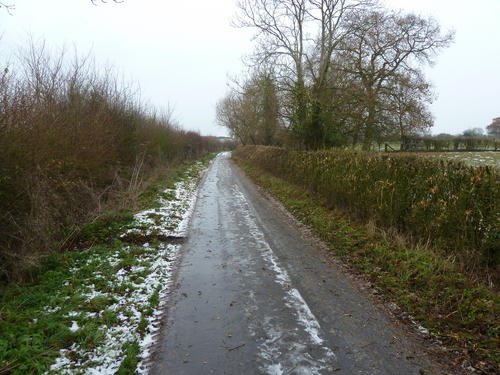
Fig. 1. Flailing miles of hedgerows at the same time destroys many Brown Hairstreak eggs. Rotational cutting is best. ©Mike Williams
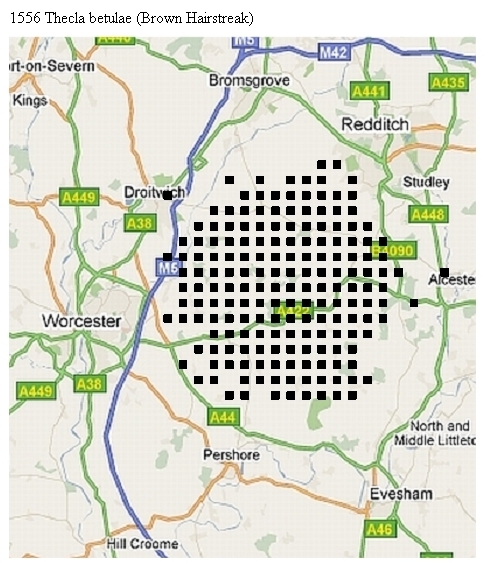
Fig. 2. Known Brown Hairstreak distribution in Worcestershire at March 2011. Each black square represents a 1x1km square.
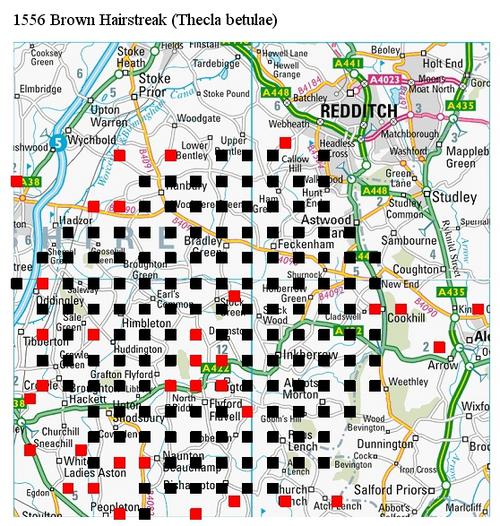
Fig. 3. Brown Hairstreak distribution as figure 1 but with latest 2010-2011 records in red.
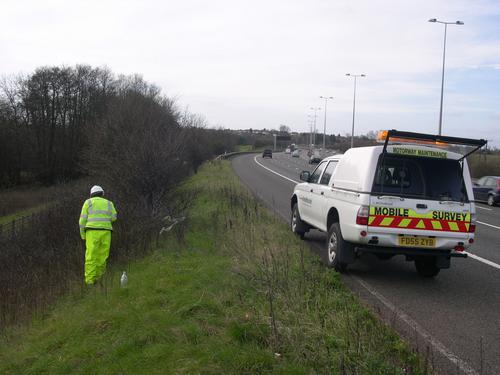
Fig. 4. Searching blackthorn for Brown Hairstreak eggs along motorway verges. ©Mike Williams
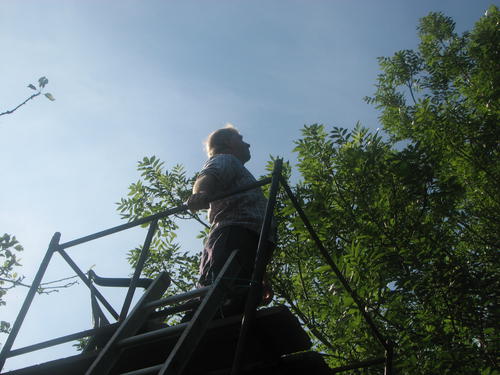
Fig. 5. Early morning watching for Brown Hairstreaks at an assembly ash tree. ©Mike Williams.

Fig. 6. Brown Hairstreakers about to set off on a winter egg hunt.
 Fig. 7. Brown Hairstreaks lay their eggs on young blackthorn shoots. They are normally laid singly, occasionally in pairs, but during the 2010-2011 winter clusters of two to seven were found – reasons unknown.
Fig. 7. Brown Hairstreaks lay their eggs on young blackthorn shoots. They are normally laid singly, occasionally in pairs, but during the 2010-2011 winter clusters of two to seven were found – reasons unknown.
Worcestershire Record | 30 (April 2011) (ISSN 1 475-9616) page: 35-36 | Worcestershire Biological Records Centre & Worcestershire Recorders
Waxcap fungi near Stourbridge
Rosemary Winnall
When I give talks to wildlife groups I often show a picture of the Pink Waxcap fungus Hygrocybe calyptriformis and ask people to let me know if they spot it. I’ve been doing this for many years, but until recently no-one has ever been in contact.
However, in 2009 I was delighted when I had a phone call from David Elder who said he had seen this distinctive toadstool in a garden in Broome near Stourbridge. I made arrangements to visit the garden of Mr. David Taft on 30th November 2009 and as soon as I drove up the drive I could see the welcome sight of a lawn that was not the over-bright ‘improved’ green, but the distinctive yellow-green showing that there was plenty of moss present – a good sign!
I was shown round, and yes, there was plenty of the moss Rhytidiadelphus squarrosus that some waxcaps seen to be associated with. How good it was to find gardeners who did not use moss killer! I was thrilled to see several lawns in this lovely large garden, all dotted with brightly coloured fungi of various shades, shapes and sizes. What an unexpected delight to find this haven of meadow fungi so close to Stourbridge!
On that first visit I recorded the following:
Waxcaps
Hygrocybe calyptriformis (Pink or Ballerina Waxcap)
Hygrocybe virginea (Snowy Waxcap)
Hygrocybe coccinea (Scarlet Waxcap)
Hygrocybe pratensis (Meadow Waxcap)
Hygrocybe ceracea (Butter Waxcap)
Hygrocybe irrigata (Slimy Waxcap)
Hygrocybe psittacina (Parrot Waxcap)
Fairy clubs
Clavaria fragilis (White Spindles)
Clavulinopsis helvola (Yellow Club)
Clavulinopsis fusiformis (Golden Spindles)
Ramariopsis kunzei
Others
Laccaria laccata (The Deceiver)
Stropharia caerulea (Blue Roundhead)
Entoloma sp.
Galerina sp.
A return visit on 8th November 2010 resulted in the count of 18 fruiting bodies of Pink Waxcaps and some additions to the list, including:
Waxcaps
Hygrocybe chlorophana (Golden Waxcap)
Hygrocybe laeta var. laeta (Heath Waxcap)
Fairy clubs
Clavulinopsis corniculata (Meadow Coral)
Earth tongue
Geoglossum fallax
There will undoubtedly be other fungi species appearing in future years unless the management changes, and it will be most interesting to check this special garden in the future. It is an important Worcestershire site and might be of regional significance.
We often think of waxcap grasslands as being unimproved meadows, but we should not forget that churchyards and garden lawns can also yield good numbers of fungi if no nitrate fertiliser has been added and if they are cut regularly, the grass cuttings are removed and the moss left to grow naturally.
I am grateful to David Taft for permission to visit his delightful garden, and to David Elder who alerting me to its special nature. How good it is to see gardens managed with wildlife in mind! I wonder if there are any other Worcestershire gardens with Pink Waxcaps growing on the lawns?
Images
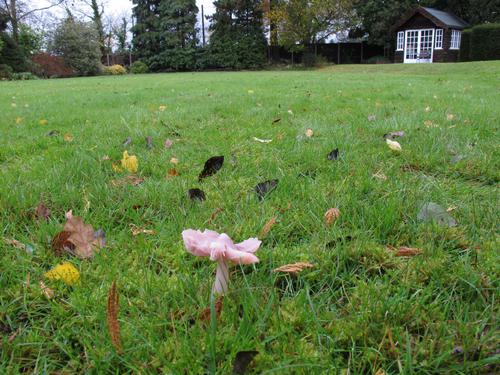
Fig. 1. Hygrocybe calyptriformis Pink or Ballerina Waxcap in lawn. Picture ©Rosemary Winnall
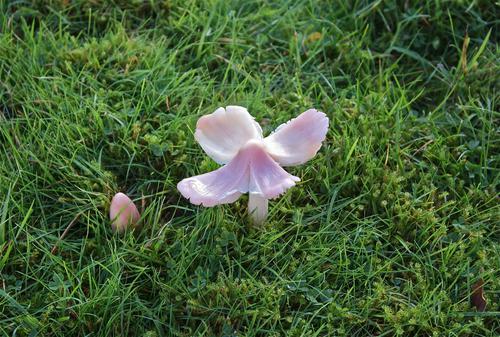
Fig. 2. Hygrocybe calyptriformis Pink or Ballerina Waxcap in lawn. Picture ©Rosemary Winnall

Fig. 3. Earthtongue Geoglossum fallax growing in mossy lawn. Picture ©Rosemary Winnall

Fig. 4. Waxcap lawn in Stourbridge. Picture ©Rosemary Winnall
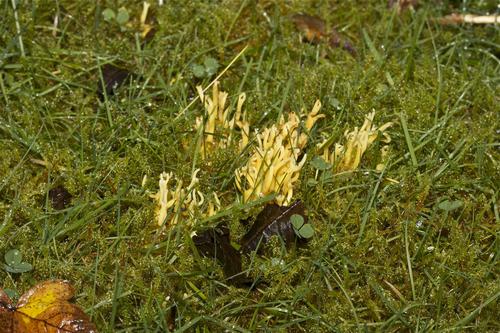
Fig. 5. Clavulinopsis corniculatus Fairy Club Meadow Coral in lawn. Picture ©Rosemary Winnall
